#Still leagues better than other history books from the era though
Text
Not to be dramatic, but I haven't been on Tumblr in literal months and I’m only back to yell about Leckie, so there's that. I finally finished reading “Strong Men Armed”, written by the main dude himself, and his author’s note is one of the most iconic things I’ve ever read.
“[names of a major and other author] insists that there were no snipers riding the Japanese tanks annihilated in the D-Day attack at Peleliu. I have said there were, because I saw them and shot at them, as did many of my comrades. Major Hough’s authority was my own battalion commander, who was quite properly some distance behind the battle, whereas Mr. McMillan’s is a tank colonel who went over the battlefield after the fight was over. Certainly there were no snipers on the tanks by then; they’d been shot off or pulled down from their slings of camouflage netting.”
“[...] I have usually preferred the account of a man who has been in the battle to that of another who has not, even if that person happens to be the commander of the unit involved.”
Aka: Robert “I was there, fucking fight me” Leckie strikes again
#Hey can you still swear on Tumblr?#Let's find out#Also on another note Strong Men Armed was a great book okay#But a tiny bit dry sometimes so I read it in sections and took breaks in-between#Lots of numbers and weapons and somewhat racist accounts of the Japanese and other non-white people#Still leagues better than other history books from the era though#Anyway I'm gonna crawl back into my hole now#Got some notes to finish for a seminar tomorrow lmao yes I am still in uni it never ends#Kidding I have a year and a half left it's getting close#Spilling the peaches
15 notes
·
View notes
Text
On the world of Mortal Engines, class, and the metaphors of consumption
This is less an essay and more a collection of thoughts. Basically I just saw a video on the Mortal Engines film and its being a civilisation too stupid to exist. I got fed up, mainly because so many of the criticisms amounted to ‘the book did it better’ with little elaboration but also the arrogantly grating voice of the presenter got on my nerves, but I cannot deny the points made and in fact wanted to elaborate further on the worldbuilding of this series and, while unrealistic, look at why the books were so engaging.
Some background to start off - Mortal Engines is a four-book series (and three-book prequel sub-series) written by English author Phillip Reeve, and depicts a bleak post-apocalyptic world. North America is uninhabitable and lost to the sands of time, irradiated, poisoned, and flattened by war. Eurasia is mostly barren plains. And, of course, the central premise - towns and cities have raised themselves onto mobile platforms and trundle about. Well, mostly. A major antagonist to this system is the Anti-Traction League, a collective of nations hiding out in old east China, the Indian subcontinent, southeast Asia and some of Africa. They are seen as barbarians and heathens by much of the world for refusing to mobilise, instead hiding in stationary citadels behind their mountains. The Traction Cities near-universally engage in a philosophy of Municipal Darwinism, a savage system of bastardised pseudo-biology where cities literally predate each other and ‘consume’ each other for resources. Cities eat towns, towns eat smaller towns. Some towns and cities deliberately adapt to cheat the system and make themselves a less appetising target, or for that matter a more aggressive and efficient hunter.
THE TRACTION CITIES
The first three books tend to focus their action on one or two cities, whereas the last is a bit more of a road trip. The other consistent thread is multiple characters’ stories running concurrently, usually reconnecting near the end. This allows the books maintain an open, almost global scale - you’ll nearly never not be moving, even sitting still on a city, which reinforces the theme of unnatural life. The first book focuses on London, which has been sulking in what was once Britain (by sheer happenstance on their part and pure irony on ours), and is suddenly running at full pelt back into Europe and eastward as fast as her engines can carry her. Why? London’s not the biggest city around, and the vast expanse of Eurasia is now the Great Hunting Ground - it’s where the big boys play, and by play I mean ‘savagely predate each other’. It’s dangerous territory for a little city. But over the first book, it becomes increasingly apparent that Traction Cities are increasingly non-viable option for existence. Fuel is scarce, prey moreso, and what morsels London can confidently snap up will not sustain it for long. There is an ecosystem at play here - static settlements can farm resources, but are universally seen as food, either by small bandit settlements to raid for supplies or for larger towns to just straight-up eat. Small towns too small to hunt tend to be miners or gatherers, either mining minerals to use or trade, or gathering resources like wood from natural deposits or sifting through the waste heaps left by bigger cities. Most cities bigger than that are ‘urbivores’, or hunter towns, that hunt and eat smaller prey or opportunistically scavenge the ‘carcasses’ of dead cities. I mentioned specialisation earlier, and like in nature, species and cities can occupy a niche that gives them an advantage and thus increased chance at survival. Airhaven, for example, is a politically-neutral city in the air that floats around Eurasia seasonally and serves as a rest stop, fuelling station and trading exchange for airship pilots the world over, Tractionist or no. Tunbridge Wheels is a pirate-run town that has a lightweight wooden chassis and flotation devices to hunt amphibiously in a world where many small towns escape threat by setting up on islands. Panzerstadt-Bayreuth is a conurbation of four massive cities, too big to survive long without prey, they banded together to take down the biggest of prey (it’s unclear whether they achieve this through sheer size or whether they decouple and become a pack hunter). Anchorage, the last American city, neutered its own jaws to increase mobility, skating around the frozen north too fast for threats to catch up with, and survives on trade. Brighton is a pleasure city that paddles around the warm Mediterranean, technically still a predator but with no real agenda and about the only city left that can be called a tourist city (it’s run on the back of brutal slave labour). And these are just the major ones. Throughout the books, cities are treated like living things ... like mortal engines.
And like living things, they need resources to survive.
A DYING WAY OF LIFE
The books are inconsistent on the origins of Traction Cities, as it turns out deliberately - history is written by the winners, after all. But it’s all closely tied to the ‘apocalypse’ part of the post-apocalytic I mentioned earlier. Long ago in-universe, long into our future, was a terrible event known as the Sixty Minute War. This war tore the world asunder with nuclear and quantum energy weaponry. America, the epicentre, is simply no more (it turns out there are some fertile areas in Nova Scotia, but for the most part America is dead). Entire new mountain ranges were born, notably the Tannhäusers in East Asia that shield the heartland of the Anti-Traction League. There was a long period of geological and tectonic instability. According to legend, Traction Cities arose to escape these instabilities. In other words, like animals will flee a volcanic eruption, cities first became mobile to escape and survive. Trade was likely facilitated by towns literally being able to park next to each other. Ironically, London was also where everything changed. After Nikola Quercus conquered (static) London with his mobile fortresses, he decided to upgrade and raise London onto wheels to become the first fully-mobile city. And he did it for war. After all, there’s no better comeback to ‘you and what army’ then literally rolling up with your entire city. By the series present, the idea had caught on and grown into the ideology described above. But herein lies the problem. Early Traction London was a tiny little thing. Now it’s not even the biggest fish in the pond, but it’s still HUGE. And, as we all know, big things need lots of energy to go. London is described as having a top speed of about sixty miles per hour at the height of a hunt. So, you need fuel. There is still oil in this world, mainly because they now have no qualms about mining Antarctica, but if you think there’s nearly enough crude oil to run a world full of cities like London you are sorely mistaken. Wood’s not much better off. And, of course, Traction Cities tend to run on some form of internal combustion engine - it’s only at the very end of the traction era that science has advanced enough for a town to experiment with magnetic levitation. So what do they burn? Well, bits of other prey towns. Do you see the problem? Use fuel to hunt towns, burn those towns for fuel. What next? And it’s not just fuel. London captures a little salt-mining town called Salthook at the beginning of the first book to introduce us to the concepts at play, and we see what goes on in the Dismantling Yards - part of a system literally called the Gut, in case the metaphor wasn’t clear yet. Everything is recycled. Bricks, mortar, steel, wood, everything. Because the state of technology is so weird in this world, Old-Tech (technology from before the SMW) can be incredibly valuable to history and/or science, and London is keen to snaffle that up too. The people are interred into refugee camps, though if you know anything about how real-life Britain treats refugees you can probably see where that is going. And it’s not enough. It’s never enough. Food is an even more pressing concern. Unless you’re very rich (more on that in a mo), food is mostly algae-based, then hardy vegetables that grow quickly like cabbage. And it’s running out fast. And London’s a big city with a lot of resources at its disposal. Most cities don’t even have that. A lot of cities are starving on the wheels, city and populace alike. A lot of cities run on slave labour, and feed those slaves as little as they can get away with. Shan Guo, home of the Anti-Traction League, is a green and vibrant land only because it doesn’t have cities running over or eating its farmlands every other day (and, again, city folk generally don’t know this - they’re given endless propaganda that Anti-Tractionists are barbarian warbands a la Mad Max). A lot of the A story is told from the point of view of Tom Natsworthy, who until the events of the book had never left London. He’s never seen bare earth or walked on mud before. He’s never seen a horse. The idea that you can survive, much less thrive, outside of a Traction City is alien to him. But on the city he came from, everything is rapidly running out, and some cities are turning to desperate measures to survive, including Arkangel openly bribing pilots to sell out the locations and courses of nearby cities. A chilling scene in the first book even has Tom see, from the safety of the air, the corpse of Motoropolis, a city not unlike London that literally just starved to death, running out of fuel and helpless as the scavengers closed in. It���s been weeks since the city stopped, and the narrative description evokes the grotesqueness and sadness of a whale carcass. Sheer Jingoism is about the only thing keeping Municipal Darwinism alive - Traction good, stationary bad.
CLASS, CLASSISM, AND OTHER SOCIAL OPPRESSIONS
In a world so starved as this, compassion is hard to come by. Cities still exist mainly by virtue of rigid social stratification, and often that stratification is literal - most medium-to-large cities have tiers, and will generally arrange those tiers based on social class. London, for example, has seven tiers. The bottom two tiers are dominated by the Gut, the engines, and homes and communities of the workers who keep them running. Tiers 4 and 3 are miscellaneous proles of increasing social standing. Tier 2 is mostly what I’d call ‘tourist London’ - lots of the nice bits and the establishments that London likes to be proud of. Because of his work at the London Museum, this is the quality of life Tom Natsworthy was most used to. Tier 1 is High London, where all the rich live and have their amenities and nice parks (and even that doesn’t last - London’s food shortage means even the High London parks are eventually, begrudgingly, turned over for food production). Katherine Valentine, the hero of the first book’s B plot, lives here. Finally there’s Top Tier, which is purely administrative. The only buildings are the Guildhall (the seat of government), St Paul’s Cathedral (which the Engineers’ Guild have secretly been installing a deadly superweapon in under the guise of ‘restoration’ work) and the headquarters of the Guild of Engineers, the most powerful of London’s Guilds. Social stratification is nearly non-existant, and people are shown to get very uncomfortable when out of ‘their space’. Tom is sent to work in the Gut during the capture of Salthook as a punishment before the plot ejects him from London, and he notes being actively intimidated by the claustrophobia, the dirt, the rough and burly labourers, and the noise. But despite Tom’s relatively privileged life - he lives near High London, above the heat and noise and smoke of the engines, in the care of one of the top four Guilds of London - he is of very low social status. Tom Natsworthy is an orphan; his parents were Historians, but were killed when an accident occurred and part of Tier 3 collapsed, crushing anything on Tier 4 beneath. Even before that, the Natsworthys were middle class at best, but being orphaned meant being left to the care of an orphanage run by the Guild of his parents, the Historians. The Historians were Tom’s only source of education, and eventually they would employ him, but with no parents or money, Tom can only afford a Third-Class apprenticeship. He has no upwards mobility within the Guild, and with no money he can’t leave and train with another. His dream of being a pilot trader, or better yet adventurer, will never come true under normal circumstances. The rich live in a completely different world yet. Katherine Valentine, daughter of the Head Historian and the Lord Mayor’s ‘right-hand man’ Thaddeus Valentine, has a positively bougie lifestyle with not a care in the world. Ironically, though, it is through Katherine’s eyes that the horrors of London’s class system are revealed. Trying to find information about her father’s would-be killer, Katherine finds herself regularly travelling to the Gut, eventually befriending an apprentice Engineer who witnessed the attack. But in the Gut, life is very different. It’s not just a life of hard labour and smoke - petty criminals and the aforementioned ‘refugees’ are tasked with working dangerous and sickening jobs like managing the city’s sewage. And by that, I mean ‘harvesting literal faeces to be converted into food and fuel’. The foreman overseeing their work admits they feed such criminals nothing else. And he has the gall to be annoyed that they keep dying of diseases like cholera and typhoid! These people are denied medical care, denied treatment, denied even basic food other than being told to literally eat sh*t. And when they inevitably die? They get sent to the Engineerium to be turned into robotic zombies that can never get sick, tired or unhappy. And, eventually, they’ll be put right back to work. The crimes these criminals did to deserve this, remember, include petty theft, criticising the Lord Mayor, and living aboard a town that got eaten. The foreman literally cannot fathom why Katherine would care about these people’s wellbeing - after all, they’re just criminals. The Engineerium’s end goal in all this is, again, to staff the entire lower tiers with robot zombie workers who will never grow tired, get sick, complain or protest their lot in life, and will never disobey orders, and just enough human overseers to keep things running smoothly ... because that’s what these people are worth to London, cheap, unending labour. Katherine can’t even bring herself to tell her high-class peers about what she learned down there, because it’s such a different world that they would never empathise, much less care. Again, slave labour is common in this world, especially child slavery - Brighton runs on it to maintain its image as a floating Caligula’s Palace, and in Arkangel slavery is so normal that we watch a rich man beat a slave nearly to death for the crime of bumping into him. In the second book, we see the logical end-point of this. Anchorage’s social structure has completely fallen apart due to a plague in recent years that turned to once-proud ice city into a ghost town manned only by a skeleton crew. The margravine, Freya, is only 14, but with her parents dead, she finds herself in charge of the whole city. She has no household staff, apart from Smew, who finds himself constantly juggling outfits to adopts the roles of steward, chamberlain and so on. His official role before the plague was ... erm ... the Dwarf. He was there in a manner similar to a court jester, for the amusement of the margrave due to being a little person. But the head navigator is just ... the woman who kept the maps. The head engineer is going half-mad, seeing his dead son staring at him from the shadows, and the only reason the town’s still going is because his systems are the best on the ice and can mostly run on automatic. They have no doctor. The only other people of consequence in Anchorage are the Aakiuqs, the Inuit couple who run the air-harbour. The common workers of Anchorage number in the mere dozens. And yet, because they’re so fixated on their traditions, nobody will drop the formalities and just admits that they’re trying to uphold a class system that doesn’t work anymore. No, that’s not quite right - everybody realises it’s pointless to maintain the artifice of Anchorage’s social heirarchy, but nobody wants to be the first one to say it out loud. Much like Municipal Darwinism, nobody want to address the elephant in the room, that the system is broken and that people hold onto it because it’s comfortable in the face of uncertainty. Only in Anchorage’s darkest hour, when everything has been turned upside down and the conquerors are on their doorsteps, do the agree to drop the formalities, drop the artifice of class, and address each other as people, say what they think, and work to save what they have left. And of course, there’s the racism in the world. Life on mobile cities has made cultures smaller and more insular, considering we mainly see this series from the point of view of culturally-English towns. Throughout the first book there is a clear west vs east divide - the Traction Cities are generally English-speaking or multicultural enough that English will get you by. The Anti-Tractionist League, meanwhile, are south or east Asian, or else African, and are commonly understood to be ‘those brown people’. The only ethnically white Anti-Tractionists are from ‘Spitzbergen’ (likely Scandinavia/Finland and northwest Russia) and Hester Shaw’s family, and the latter lived on a town that floated out to an island and gave up running from predators forever. The way Tom reacts to this attitude calls to mind the way racists might refer to ‘race traitors’. There’s even an in-universe slur for people who live in static settlements; ‘Mossies’, because ‘a rolling town gathers no moss’. However, when Tom is taken to Shan Guo itself, he realises that all the propaganda he’d been fed his whole like is exactly that - propaganda. Shan Guo is described as beautiful - an endless patchwork of rolling fields and farms, colourful, bright, vibrant, heaving with life and energy. The Anti-Tractionists aren’t vicious savages, they’re just ... people. Tom can’t understand it at first. He wonders how people can live without the hum of engines or the vibrations of deckplates - he subconsciously equates city life with, well, life, and the absence of that makes him uneasy. But he can also see this culture before him, thousands of years old, outlasting even the end of the world, and he realises there is another way. The next time he sees London, he sees it from outside, from the side of the hunted, and he realises it’s not beautiful or efficient, just dirty, and huge, wrapped in its own waste smoke and driven only by destruction. For the rest of the series, even with the rise of the radicalised Green Storm (Anti-Tractionists Lv2), large Traction Cities are consistently the enemy. Tractionism as a culture is understood to only represent imperialism, destruction, and consumption, literally and figuratively.
SCIENCES SANS FRONTIERES
It should be noted that science and technology are not universally reviled by the series. As a dieselpunk series, a certain degree of technology is fundamental to the series existence. But this is a very different world than the one we know. On the one hand, engines exist that can drive entire cities. On the other, computers basically do not exist. The rare few that still exist are not in working condition, and nobody knows how to restore them. Heavier-than-aircraft don’t really exist - the third book introduces some, but they’re small, experimental ... barely more than short-range toys designed for flashy air shows but not real travel. The main form of personal locomotion in this world is by airship, and this world’s airships are far beyond anything we’ve made in our time. But lost technologies are heavily associated with the hubris and destructiveness of the Ancients. Until now. Like I said, the most powerful Guild in London is the Engineers’ Guild. And they got that way under the leadership of now-Lord Mayor Magnus Crome. It should be noted that Crome genuinely loves his city and wants it to survive no matter the cost. But under Crome, the Engineers began to dabble in sciences considered unethical to downright taboo. Most notable is the MEDUSA Project. Through Thaddeus Valentine, London came into possession of an energy weapon from the SMW ... and, more importantly, the working computer that runs the thing. In terms of Darwinist Evolution, this is like giving a monkey a gun and teaching it how to use it. MEDUSA exhibits a level of power no other force on Earth can match, and London is forced to deploy it early in a crisis. Originally, the plan was to march up to Batmunkh Gompa, the Shield-Wall that represents the only break in the mountains around Shan Guo big enough to permit a city, and blast it to cinders. Unfortunately, London attracts the attention of a bigger, hungrier city about halfway there, and is forced to fire MEDUSA at it to save its own skin. The sheer terror of what that weapon represents is revealed then. Panzerstadt-Bayreuth was the fusion of four massive cities, each one bigger and more powerful than London. MEDUSA killed it dead in one stroke - the energy beam set the entire city ablaze and ignited its fuel stores. Her engines nearly immediately exploded. When the fires go down enough for an Engineer scout ship to investigate, the people had been almost flashed into glass. The flash of light from the attack is so bright that, hundreds of miles to the south, Tom and Hester see the sky light up like a new dawn. The people of London are relieved, of course, that they didn’t all die that night, but more than that the entire city become suffused with the excitement of just how easy it would be to kill ... well, anyone they like, really. London doesn’t even stop to devour Panzerstadt-Bayreuth, as the Engineers can’t afford for the Shield-Wall to prepare for their arrival. Appropriately, and karmically, the finale has an accident lock down the computer lock down, with MEDUSA unable to fire but unable to stop gathering energy, and London melts under the heat of MEDUSA’s glare. But that wasn’t the only scientific sin committed by London’s engineers. I’ve already mentioned London trying to repurpose faeces as food, but we need to talk more about the Stalkers. Stalkers are kinda like discount Cybermen from Doctor Who - dead bodies, threaded with weird old machines and coated in armour, their brains hooked up to simple computers. Originally conceived as soldiers, they were believed long dead. However, one survived to the modern by sheer survivor instinct - Shrike. Through negotiations that are not the purview of this essay, he allowed the Engineers of London to take him apart and figure out how he worked, and hoo boy they did. The Engineers figured out how to manufacture their own Stalkers. The first batch are used as law enforcement like the Worst Robocops, but, again, the plan was to have Stalker workers all over Low London. Katherine, learning this, likens it to London ‘being a city of the dead’ (Apprentice Engineer Pod, to whom she is talking, grimly notes that the Deep Gut Prison is so awful, so callous with human life, that it already feels like that). Logically, the end-point of this idea is to have all workers in London be the resurrected dead, with just enough living to keep things in order ... oh, and they’d all be loyal to the Engineers, because remember, no Freedom of Speech here, and you can be sent to do the worst form of prison labour for dissenting against the Lord Mayor. With Crome being both Lord Mayor and Head Engineer at once, the Engineers’ creed is as good as law - traditionally, London Lord Mayors forsook their former Guild allegiances to show their representation of all of London, and Crome’s refusal to do that caused a bit of a stir. The Engineers are also keen to arm their security teams with some form of energy pistols, despite guns being outlawed in London and the police are only allowed crossbows. Crome’s rationale is the same as every two-bit mad scientist villain, of course - that science should not be held back by moral restrictions, and that progress for progress’ sake is essential for London’s survival. Really, it’s the Engineer’s survival, as they’re rather loathe to share these advancements except to exert power on those around. London isn’t the only example of technology being used to leverage control and benefit the ruling classes. Grimsby is a sunken wreck of a city somewhere in the north Atlantic, yet due to a complex series of airlocks the interior of the city is a secret hideaway of the Lost Boys, a society of children stolen from aquatic towns and trained to be thieves under the watchful eye of the mysterious Uncle. They will then take submarine walkers, attach to passing towns, steal whatever tools, fuel, food and riches they can carry, and vanish back into the depths. Uncle, naturally, takes the lion’s share of the haul. But Uncle maintains his power by careful access to technology, only letting the Boys have what they need and juggling the power structure by choosing team leaders, and punishing insubordination harshly and publicly. Uncle sees and hears everything in Grimsby with his surveillance network, and can address any give Boy in a heartbeat, training the Boys to never expect privacy from him, so that when he demands a progress update from a mission, they never question him. He rewards Boys who do well on burglaries, but more importantly than that, he chooses team leaders according to apparently inscrutable whims. The Boys believe it’s a mark of favour from Uncle, and thus social status, to be trusted with the limpet command and all the tech that comes with. Really, Uncle carefully give command to people he can trust to remain loyal to him, even if that means passing over a more talented Boy who might get a bit uppity. Even in a more mundane way, higher status in the Lost Boys means you can move closer to the heart of Grimsby, where you’re less likely to wake up and find your bedroom wasn’t as watertight as you thought and flooded in the night. Uncle, naturally, doesn’t care if a few Boys drown, so long as he doesn’t lose anything useful. Technology, and in particular access to unusual technology, is the dimension on which power is really decided.
THE END OF AN ERA
We’ve already established that this world is not a sustainable one. There are only so many cities. The inherent entropy of Municipal Darwinism is really showing. Once upon a time, big cities could ‘reproduce’, creating little satellite towns that could grow and become independent - even London had some - but those are no more. In a greedy desperation to keep moving, the predators are not reproducing, and static settlements can’t spread and grow fast enough to count there. The attack of London, and MEDUSA, turned staunch opposition into outright war, with the Green Storm being willing to doublethink their way into using the weapons of the Traction Cities in their fight to stop the Traction Cities, even recruiting ex-London Engineers to make weapons and stalkers for them, and eventually even seeking out another ancient superweapon - an orbital laser called ODIN - without a hint of irony. The Green Storm eventually face internal resistance, from Anti-Tractionists who disagree with the outright terrorism angle, and eventually crumbles. The last great Traction Cities stop. The last mobile city is New London, no longer a hunter but a trade platform, and even that probably stopped hovering about at some point. The ending is told by the great survivor, Shrike, who has cheated Death again and again, who outlived Tom Natsworthy and Hester Shaw, Valentine, Magnus Crome, and a thousand other heroes and villains. When he awakes, long in the future, Traction Cities are not even ancient history. They’re a dream, a fantasy, too incredible to be true. But Shrike remembers, and he teaches people the story of London and Anchorage, Arkangel and Airhaven, Brighton and Harrowbarrow. Did they learn the right message from Shrike’s story? Did they learn that ruthless imperialism is like hunting faster than the food can come back, and that you will starve before you have everything you ever wanted? Did they learn that hoarding resources, gatekeeping knowledge, will lead to ruin? Did they learn, or will the repeat the same mistakes of the greed and gluttony of the Traction Era? Well, who knows.
12 notes
·
View notes
Text
TV I Liked in 2020
Every year I reflect on the pop culture I enjoyed and put it in some sort of order.
Was there ever a year more unpredictably tailor-made for peak TV than 2020? Lockdowns/quarantines/stay-at-home orders meant a lot more time at home and the occasion to check out new and old favorites. (I recognize that if you’re lucky enough to have kids or roommates or a S.O., your amount of actual downtime may have been wildly different). While the pandemic resulted in production delays and truncated seasons for many shows, the continued streaming-era trends of limited series and 8-13 episode seasons mean that a lot of great and satisfying storytelling still made its way to the screen. As always, I in no way lay any claims to “best-ness” or completeness – this is just a list of the shows that brought me the most joy and escapism in a tough year and therefore might be worth putting on your radar.
10 Favorites
10. The Right Stuff: Season 1 (Disney+)
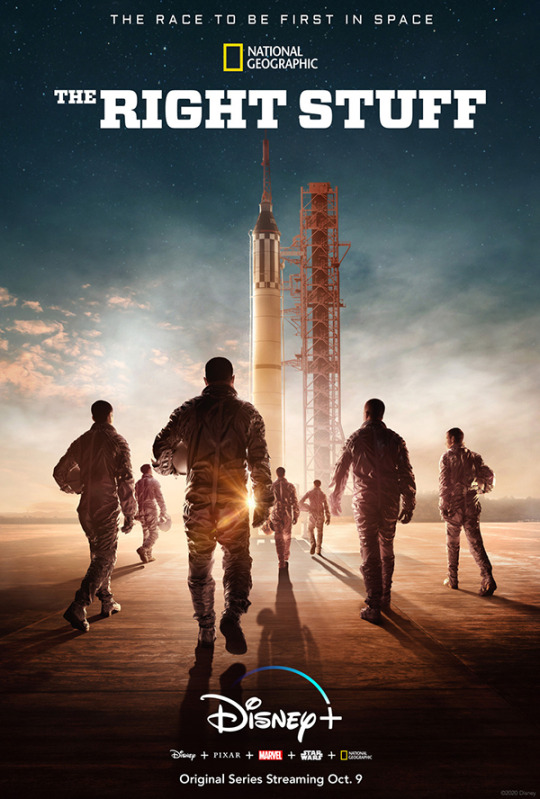
As a space program enthusiast, even I had to wonder, does the world really need another retelling of NASA’s early days? Especially since Tom Wolfe’s book has already been adapted as the riveting and iconoclastic Philip Kaufman film of the same name? While some may disagree, I find that this Disney+ series does justify its existence by focusing more on the relationships of the astronauts and their personal lives than the technical science (which may be partially attributable to budget limitations?). The series is kind of like Mad Men but with NASA instead of advertising (and real people, of course), so if that sounds intriguing, I encourage you to give it a whirl.
9. Fargo: Season 4 (FX)
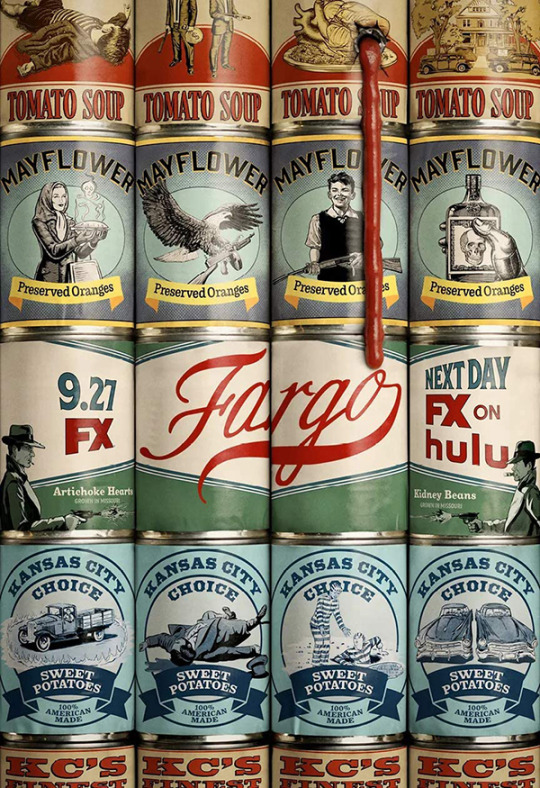
As a big fan of Noah Hawley’s Coen Brothers pastiche/crime anthology series, I was somewhat let down by this latest season. Drawing its influence primarily from the likes of gangster drama Miller’s Crossing – one of the Coens’ least comedic/idiosyncratic efforts – this season is more straightforward than its predecessors and includes a lot of characters and plot-threads that never quite cohere. That said, it is still amongst the year’s most ambitious television with another stacked cast, and the (more-or-less) standalone episode “East/West” is enough to make the season worthwhile.
8. The Last Dance (ESPN)
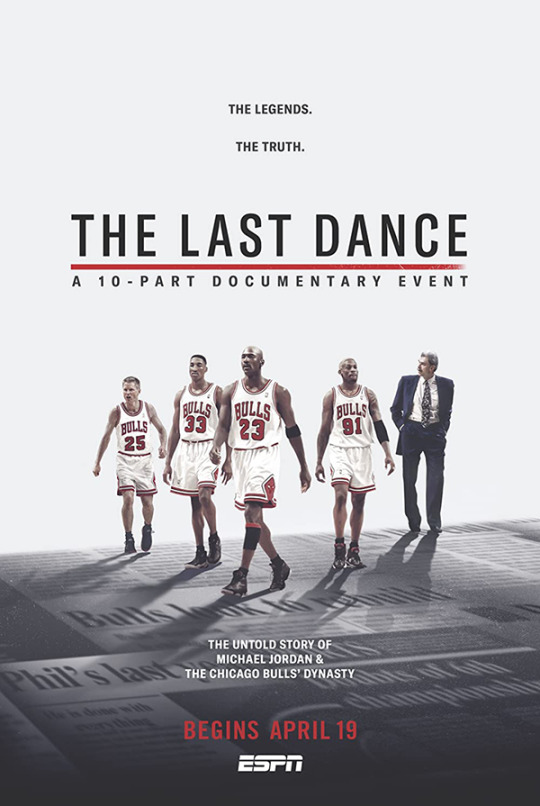
Ostensibly a 10-episode documentary about the 1990s Chicago Bulls’ sixth and final NBA Championship run, The Last Dance actually broadens that scope to survey the entire history of Michael Jordan and coach Phil Jackson’s careers with the team. Cleverly structured with twin narratives that chart that final season as well as an earlier timeframe, each episode also shifts the spotlight to a different person, which provides focus and variety throughout the series. And frankly, it’s also just an incredible ride to relive the Jordan era and bask in his immeasurable talent and charisma – while also getting a snapshot of his outsized ego and vices (though he had sign-off on everything, so it’s not exactly a warts-and-all telling).
7. The Queen’s Gambit (Netflix)

This miniseries adaptation of the Walter Tevis coming-of-age novel about a chess prodigy and her various addictions is compulsively watchable and avoids the bloat of many other streaming series (both in running time and number of episodes). The 1960s production design is stunning and the performances, including Anya Taylor-Joy in the lead role, are convincing and compelling.
6. The Great: Season 1 (hulu)

Much like his screenplay for The Favourite, Tony McNamara’s series about Catherine the Great rewrites history with a thoroughly modern and irreverent sensibility (see also: Sofia Coppola’s Marie Antoinette). Elle Fanning brings a winning charm and strength to the title role and Nicholas Hoult is riotously entertaining as her absurdly clueless and ribald husband, Emperor Peter III. Its 10-episodes occasionally tilt into repetitiveness, but when the ride is this fun, why complain? Huzzah!
5. Dispatches From Elsewhere (AMC)

A limited (but possibly anthology-to-be?) series from creator/writer/director/actor Jason Segal, Dispatches From Elsewhere is a beautiful and creative affirmation of life and celebration of humanity. The first 9 episodes form a fulfilling and complete arc, while the tenth branches into fourth wall-breaking meta territory, which may be a bridge too far for some (but is certainly ambitious if nothing else). Either way, it’s a movingly realized portrait of honesty, vulnerability and empathy, and I highly recommend visiting whenever it inevitably makes its way to Netflix, or elsewhere…
4. What We Do in the Shadows: Season 2 (FX)

The second season of WWDITS is more self-assured and expansive than the first, extending a premise I loved from its antecedent film – but was skeptical could be sustained – to new and reinvigorated (after)life. Each episode packs plenty of laughs, but for my money, there is no better encapsulation of the series’ potential and Matt Berry’s comic genius than “On The Run,” which guest-stars Mark Hamill and features Laszlo’s alter ego Jackie Daytona, regular human bartender.
3. Ted Lasso: Season 1 (AppleTV+)
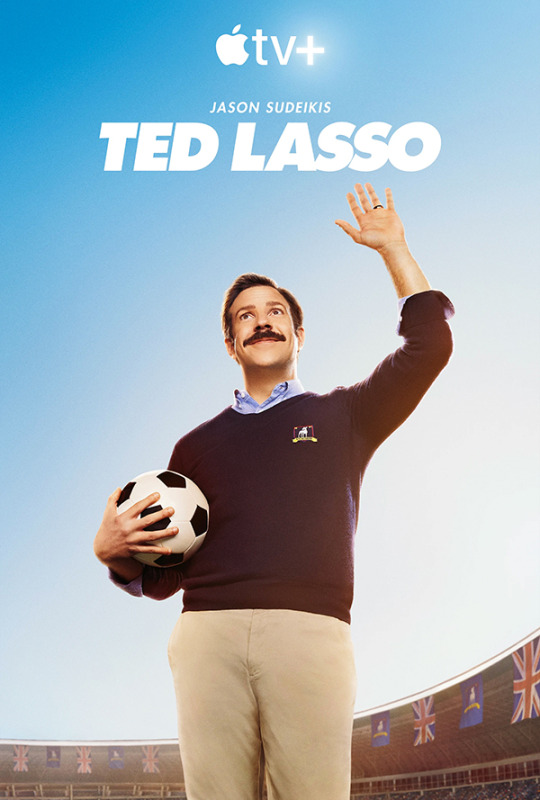
Much more than your average fish-out-of-water comedy, Jason Sudeikis’ Ted Lasso is a brilliant tribute to humaneness, decency, emotional intelligence and good coaching – not just on the field. The fact that its backdrop is English Premier League Soccer is just gravy (even if that’s not necessarily represented 100% proficiently). A true surprise and gem of the year.
2. Mrs. America (hulu)
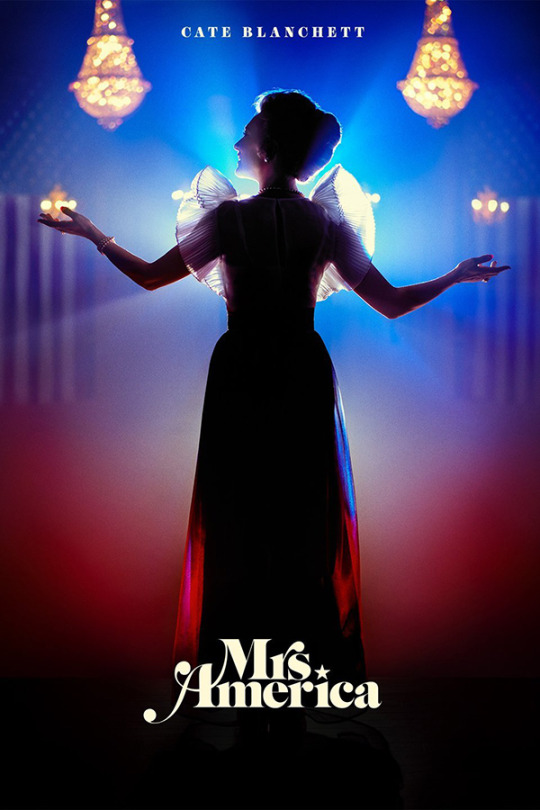
This FX miniseries explores the women’s liberation movement and fight for the Equal Rights Amendment in the 1970s and its opposition by conservative women including Phyllis Schlafly. One of the most ingenious aspects of the series is centering each episode on a different character, which rotates the point of view and helps things from getting same-y. With a slate of directors including Ryan Bowden and Anna Fleck (Half-Nelson, Sugar, Captain Marvel) and an A-List cast including Cate Blanchett, Rose Byrne, Uzo Aduba, Sarah Paulson, Margo Martindale, Tracey Ulman and Elizabeth Banks, its quality is right up there with anything on the big screen. And its message remains (sadly) relevant as ever in our current era.
1. The Good Place: Season 4 (NBC)
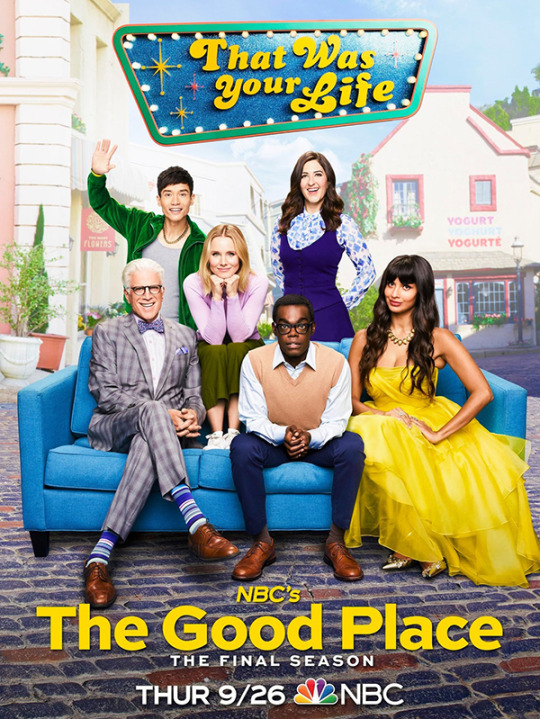
It was tempting to omit The Good Place this year or shunt it to a side category since only the final 4 episodes aired in 2020, but that would have been disingenuous. This show is one of my all-time favorites and it ended perfectly. The series finale is a representative mix of absurdist humor and tear-jerking emotion, built on themes of morality, self-improvement, community and humanity. (And this last run of eps also includes a pretty fantastic Timothy Olyphant/Justified quasi-crossover.) Now that the entire series is available to stream on Netflix (or purchase in a nice Blu-ray set), it’s a perfect time to revisit the Good Place, or check it out for the first time if you’ve never had the pleasure.
5 of the Best Things I Caught Up With
Anne With An E (Netflix/CBC)

Another example of classic literature I had no prior knowledge of (see also Little Women and Emma), this Netflix/CBC adaptation of Anne of Green Gables was strongly recommended by several friends so I finally gave it a shot. While this is apparently slightly more grown-up than the source material, it’s not overly grimdark or self-serious but rather humane and heartfelt, expanding the story’s scope to include Black and First Nations peoples in early 1800s Canada, among other identities and themes. It has sadly been canceled, but the three seasons that exist are heart-warming and life-affirming storytelling. Fingers crossed that someday we’ll be gifted with a follow-up movie or two to tie up some of the dangling threads.
Better Call Saul (AMC)
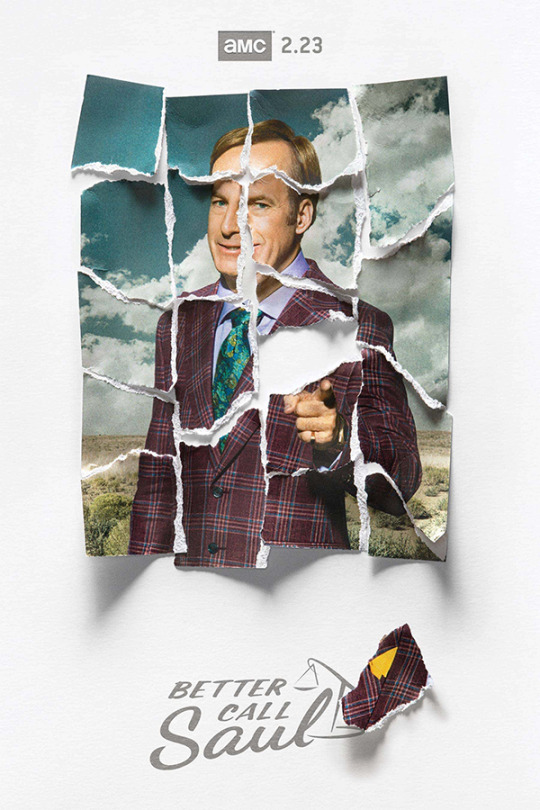
I liked Breaking Bad, but I didn’t have much interest in an extended “Breaking Bad Universe,” as much as I appreciate star Bob Odenkirk’s multitalents. Multiple recommendations and lockdown finally provided me the opportunity to catch up on this prequel series and I’m glad I did. Just as expertly plotted and acted as its predecessor, the series follows Jimmy McGill/Saul Goodman on his own journey to disrepute but really makes it hard not to root for his redemption (even as you know that’s not where this story ends).
Joe Pera Talks With You (Adult Swim)
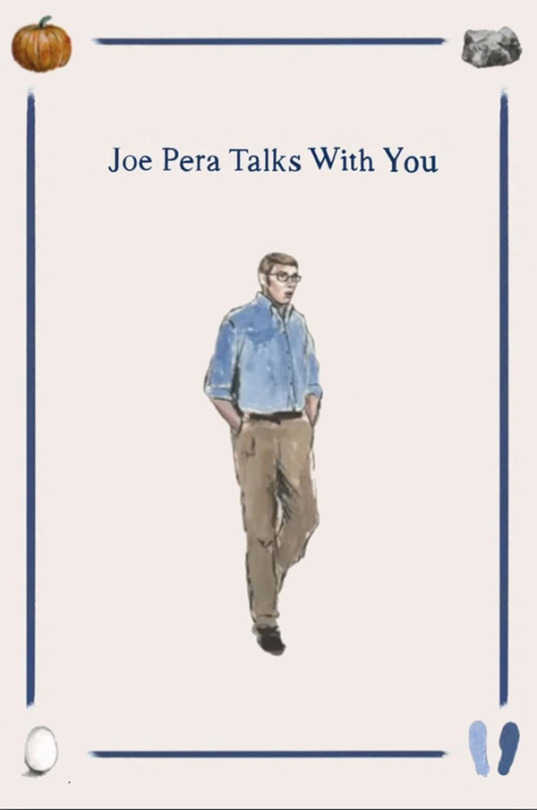
It’s hard to really describe the deadpan and oddly soothing humor of comedian Joe Pera whose persona, in the series at least, combines something like the earnestness of Mr. Rogers with the calm enthusiasm of Bob Ross. Sharing his knowledge on the likes of how to get the best bite out of your breakfast combo, growing a bean arch and this amazing song “Baba O’Reilly” by the Who – have you heard it?!? – Pera provides arch comfort that remains solidly on the side of sincerity. The surprise special he released during lockdown, “Relaxing Old Footage with Joe Pera,” was a true gift in the middle of a strange and isolated year.
The Mandalorian (Disney+)
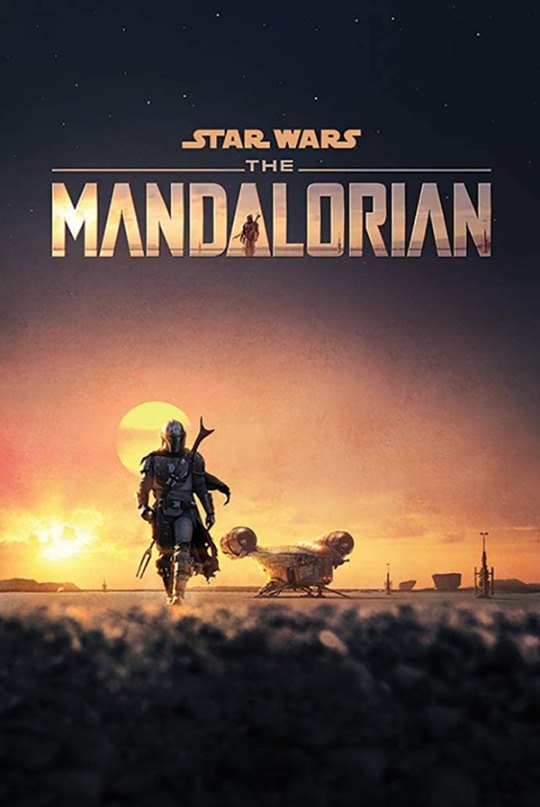
One of the few recent Star Wars properties that lives up to its potential, the adventures of Mando and Grogu is a real thrill-ride of a series with outstanding production values (you definitely want to check out the behind-the-scenes documentary series if you haven’t). I personally prefer the first season, appreciating its Western-influenced vibes and somewhat-more-siloed story. The back half of the second season veers a little too much into fan service and video game-y plotting IMHO but still has several excellent episodes on offer, especially the Timothy Olyphant-infused energy of premiere “The Marshall” and stunning cinematography of “The Jedi.” And, you know, Grogu.
The Tick (Amazon Prime)

I’ve been a fan of the Tick since the character’s Fox cartoon and indie comic book days and also loved the short-lived Patrick Warburton series from 2001. I was skeptical about this Amazon Prime reboot, especially upon seeing the pilot episode’s off-putting costumes. Finally gaining access to Prime this year, I decided to catch up and it gets quite good!, especially in Season 2. First, the costumes are upgraded; second, Peter Serafinowicz’s initially shaky characterization improves; and third, it begins to come into its own identity. The only real issue is yet another premature cancellation for the property, meaning Season 2’s tease of interdimensional alien Thrakkorzog will never be fulfilled. 😢
Bonus! 5 More Honorable Mentions:
City So Real (National Geographic)
The Good Lord Bird (Showtime)
How To with John Wilson: Season 1 (HBO)
Kidding: Season 2 (Showtime)
Unbreakable Kimmy Schmidt: Kimmy Vs The Reverend (Netflix)
11 notes
·
View notes
Text
The Lewis Hamilton Fallacy
With Lewis Hamilton setting a new FORMULA 1 win record, and closing in on a record-equalling seventh World Championship, the vitriol on social media has been increasing, causing many to no longer wish to participate in Facebook groups that tolerate driver-bashing and hatred.
So how did we get to this point?
There are many factors at play here such as most drivers having a big presence across social media, but a key premise is we all have a different model of the world.
How you see things is completely different to how I see things, and generally speaking, this is a good thing for society as we can all bring our different points of view to a scenario and find a way forward.
Sadly this is not the case in the comments of nearly every F1 group on Facebook, where people are adamant that their point of view is right, yours is wrong, and you’re an idiot for thinking the way you do.
Let’s take a look at some of the common arguments in F1 groups, and see if they hold water…
Driver X Is The GOAT!
The GOAT argument isn’t specific to the world of F1, just look at the NBA, where LeBron James fourth NBA title stirred great debate as to whether or not he takes the mantle from Michael Jordan.
In F1 we have Lewis Hamilton vs Michael Schumacher, 93 race wins vs 91, six championships vs seven.
So how do we work out who the GOAT is?
Well, we can’t.
And even when F1 and AWS put out their ‘Fastest Driver’ analysis it still didn’t appease people if their guy wasn’t deemed the fastest.
Different drivers, different competition, different cars, the list goes on.
What we can have though is our favourite, and our own criteria for choosing a GOAT.
Personally, I didn’t much enjoy the years where Schumacher and Ferrari dominated. However, he has the most titles so to me he is still the greatest.
Some say the best of all time is Jim Clark, some say Fangio, some say Ayrton Senna. But unless they have seen them race, how can they compare?
Because if they’re using statistics, well the numbers don’t add up.
If they’re using stories and YouTube clips, then they’re comparing some drivers highlight reels against other drivers careers.
The passing of time plays an interesting trick on the mind, where we often forget the flaws, the disappointments, and the losses, remembering only the triumphs and victories.
And that’s ok.
You can have your GOAT, I can have mine, and neither of us can (or should) try to convince others that their GOAT is wrong.
Lewis Hamilton Has The Fastest Car (Or Best Car)
This one is odd, as I’m yet to see a car that wasn’t the fastest win a race.
When Pierre Gasly won the 2020 Italian Grand Prix, on that day, his car was the fastest.
Maybe there is something in the air in Italy, as in 2008 Sebastian Vettel won in a Toro Rosso to claim his first win in F1. Funnily enough, on that day, his car was the fastest.
You wouldn’t think you’d need to explain how motorsport works, but what happens is the driver who crosses the line first, ie completes the race distance the fastest, wins. It’s that simple.
These ‘fastest car’ or ‘best car’ arguments add to the Lewis Hamilton Fallacy.
Formula 1 is a meritocracy, and as such, the best drivers usually find themselves into the cockpit of the best car.
From 2010 to 2013, it was widely acknowledged that Red Bull Racing were producing the best cars, as they powered Sebastien Vettel to four consecutive World Championships.
Today though, people are rewriting history as they claim Hamilton has ‘always’ benefitted from being in the best car.
So which one is it?
Because clearly it can’t be both.
The Good Old Days Were Better
This one is always fun, and is something that likely happens to all of us as we get older!
I’ve found myself opining that the English Premier League was better in the 90s and 2000s than it is now for example.
Often, the ‘good old days’ coincide with a time in history where our favourite teams and stars were winning. Funny about that.
Have you ever met a Ferrari fan who thinks the current era is better than the 2000-2004 period?
No, you haven’t.
However, where this one gets really interesting is when people argue that the drivers no longer drive the cars, and that everything is controlled by engineers sitting on a pit wall.
The problem with this is the Williams FW14B, built in 1992, is still considered the most technologically sophisticated car in the history of F1.
It’s 28 years old.
The FW14B had semi-automatic transmission, active suspension, traction control and, for a short time, anti-lock brakes.
It also had Adrian Newey in charge of aerodynamics.
In fact, Williams found the FW14B was proving so successful that when the FW15 was ready half-way through the 1992 FORMULA 1 season, it wasn’t used.
The argument (often made by people who reach their limit reversing out the driveway) that Hamilton turns up on a Sunday, plants his foot on the accelerator, and drives into the distance is disrespectful of the amount of work he puts in to keep his body and mind at peak performance, as well as the staff at Mercedes who put in countless hours perfecting the car.
Mercedes Should Get Max Verstappen, He Would Beat Hamilton
This would be a terrible idea for Mercedes, so it’s a good thing they don’t listen to public opinion on social media.
First of all, it sends a message to drivers in their development program that even if you progress through the program the seat will go to the big-name with more runs on the board.
Second, do you recall the Senna v Prost years?
Sure, Ron Dennis had two prodigious talents at his disposal, but the infighting, egos, and crashes out on course disrupted team harmony, causing factions in the garage and distrust at all levels.
Mercedes currently have the perfect set up, and it’s obviously working, as they pick up championship after championship.
As we’ve seen throughout history, having a genuine #1 and an able deputy leads to both Driver’s and Constructor’s Championships.
During the aforementioned ‘Schumacher Years’ of 2000 to 2004, he was the undisputed #1 and teammate Rubens Barrichello understood his role and performed it admirably.
Lewis Hamilton Doesn’t Have Competitive Teammates
Former Formula 1 World Champions Fernando Alonso, Jenson Button, and Nico Rosberg would probably all argue that they are competitive drivers, capable of going wheel to wheel with Hamilton.
And they would be right, because they have the race wins and championships to prove their credentials.
When Hamilton joined the grid in 2007 as a teammate to Fernando Alonso, the belief throughout the paddock was that Alonso was #1 and Hamilton would be there to learn the ropes in F1.
In reality, it didn’t work out like that.
As Hamilton performed well, taking podiums and race wins, tensions mounted, and boiled over at the 2007 Hungarian Grand Prix, where in the final qualifying session Alonso deliberately delayed Hamilton in the pits, ensuring he wouldn’t be able to get in one last run.
The pair didn’t speak for weeks after the incident.
At the end of the season, both drivers secured four race wins and 12 podiums. Clearly they were allowed to race each other, there were no team orders.
Funnily, after tensions thawed, in 2017 Alonso said “[Hamilton] was able to win with a dominant car, with a good car like 2010 or 2012, or with bad cars like 2009 and 2011. Not all the champions can say that”.
Is Alonso suggesting Hamilton hasn’t always had the best car?
Facebook commenters would disagree with the two-time World Champion…
In Jenson Button’s book ‘Life to the Limit’ Button goes into detail how competitive Hamilton was, and makes it clear that he too was there to win, not just to act as a rear-gunner for Hamilton. An interesting fact Button points out in this same book is that when Rubens Barrichello was his teammate at Honda, Barrichello had it written into his contract that they were equal drivers, he was not to be a #2…
When Hamilton moved to Mercedes for 2013, a move derided by many given Mercedes lacklustre performance in previous years, it was Nico Rosberg’s team.
There is evidence that team orders were used on at least one occasion in 2013, where at the 2013 Malaysian Grand Prix Rosberg was ordered to stay behind Hamilton in the closing stages, rather than fighting for third place. Hamilton felt the call was wrong, and that Rosberg should have been allowed to race.
During the 2014 Formula 1 season tensions again boiled over for Hamilton and a teammate, as several early exchanges throughout the season threatened to compromise both drivers title aspirations.
The pair had a wheel-to-wheel battle in Bahrain, a down-to-the-wire tussle in Spain, and made contact in Belgium.
In 2016, the year Rosberg won the championship, the two came together at the 2016 Spanish Grand Prix, in a move that infuriated Niki Lauda, as both drivers crashed out of the race.
The duo came together again at the 2016 Austrian Grand Prix, however both drivers could continue, with Hamilton taking the win.
Nice Rosberg went on to win the 2016 Driver’s Championship, which gives Hamilton detractors a curious dilemma.
On one hand they laugh, saying he was beaten by Nico Rosberg, yet on the other, they say he has never had to race against competitive teammates.
So, which one is it?
Lewis Hamilton Needs To Prove He Can Win With Another Team
This one always brings a smile to the face 😊
I have no problem with fans being new to F1, it’s great! The sport needs more and more fans to keep it going.
The issue is people forgetting that the sport was going before they saw it on Drive to Survive, then commenting on Facebook posts.
For the record, Lewis Hamilton won the 2008 Driver’s Championship with McLaren.
Although they had a Mercedes engine at the time, they were indeed their own team then, as they are now.
And that is a different team to Mercedes.
Hamilton has won championships with two teams.
Before the 2008 season Felipe Massa of Ferrari was the favourite to win the title, and Ferrari did indeed win the Constructor’s Championship, however, in a thrilling finish to the season Hamilton won the title by one point.
His teammate Heikki Kovalainen finished seventh.
But wait, doesn’t the best car always win the Driver’s Championship too?
Well now I don’t know what to believe.
Put Lewis Hamilton In A Williams, Let’s See How He Goes
If Hamilton was to drive for Williams, we already know how it would go – terribly.
Why?
Because it is a poor car that has suffered at the hands of bad management and a lack of finances for several seasons now.
Fernando Alonso drove a horrible McLaren from 2015 to 2017.
Jenson Button and Rubens Barrichello had a terrible Honda to drive in 2007 and 2008, and not just because it had a map of the world painted on it. The aerodynamics were poor from the start, and the car just wasn’t competitive.
Does this diminish any of these drivers achievements before or after?
Does it prove their car is what won them races?
No, what it does prove is that Formula 1 is a team sport, and that it takes everyone rowing in the right direction together to deliver a package capable of competing at the front.
If Lionel Messi signed for Newcastle they still wouldn’t win the league. Likewise if Lebron James joined the Knicks, they wouldn’t win an NBA title. The teams they would join are still terrible, but having a champion on the team would improve them and make everyone life their standards over time.
Hamilton wouldn’t win in a Williams, just like Raikkonen can’t win in an Alfa and Vettel can’t get near a podium in a Ferrari this year.
However, the one thing all these drivers have in common is the ability to wring every ounce of performance out of a bad car, and Williams would expect nothing less if they had Hamilton in their race seat.
Politics Don’t Belong in Sport
As a middle-aged white man, this one makes me cringe the most.
Middle aged white men on Facebook, telling a black man what he should and shouldn’t do, how he can protest, and how he is ‘ruining’ the sport for them.
Yikes.
The purpose of a protest is to bring issues to light, to have people questioning their attitudes and beliefs.
Telling someone how they can protest against their perceived suppression is, er, suppressing them further.
You may not agree with ‘We Race As One‘, the BLM movement or drivers taking a knee before the race, but that’s the point. An issue being highlighted is an opportunity for you to question your thinking, to reflect, and possibly make changes. There is no harm in admitting that at one time you held beliefs that you now feel are wrong.
While we’re on the topic of politics in sports and how the handful of minutes it takes to show drivers supporting the ‘End Racism’ message ruining peoples enjoyment of Formula 1, what of other sports?
The ‘Old Firm’ derby is one of the biggest rivalries in sport, and it is founded on religion and politics. People are born into a side based on which side of the clearly divisive line they fall, Catholic vs Protestant, British vs Irish Scot, Conservatism vs Socialism. People have been killed on derby days, and violence in Glasgow increases any time the two clubs play.
Politics don’t belong in sport though, so they must be fighting over something else.
In 1967 Muhammed Ali refused to serve in the US Army during the Vietnam War, uttering the famous line ‘I ain’t got no quarrel with those Vietcong…no Vietcong ever called me nigger.’ Since then he has, rightfully, been lauded as a hero for his stance.
The Vietnam War probably wasn’t political though, was it?
Even the sport of Bandy isn’t immune to politics!
Norway declined to take part in the 1957 Bandy World Championship because the Soviet Union was invited, due to the Soviet invasion of Hungary the year before. The country made a similar protest for the 1969 Bandy World Championship because of the Warsaw Pact invasion of Czechoslovakia that year, handing over the hosting of the 1969 event to Sweden.
Indeed Formula 1 itself is no stranger to politics in sport, with the 2011 Bahrain Grand Prix cancelled due to concerns over human rights protests led by Avaaz.
You may not agree with the stance Hamilton has taken, you may not like it, but you do have to respect that in a free society he can use his platform however he sees fit – he built it.
What To Make Of The Lewis Hamilton Fallacy
Now I’m not naïve enough to think that the words on this page will make everyone stop arguing on the internet, that will never happen.
What I do hope though is that it has loosened the grip for some people, and will help them take the blinkers off.
We’re lucky enough to be living in a time where each Sunday, one of the finest Formula 1 drivers the world has ever seen jumps into his Mercedes and puts his life on the line to win trophies, and entertain us.
I’m lucky enough to have seen this level of performance twice, once with Michael Schumacher, now with Lewis Hamilton.
Should I live long enough to see Hamilton’s records beaten, I won’t waste time arguing over who is the GOAT, who had the best car, or why this bright new talent needs to jump through made up hoops to prove themselves to the folks in the bleachers.
I’ll simply be grateful to have witnessed three drivers at the absolute peak of their powers, doing what they love.
(adsbygoogle = window.adsbygoogle || []).push({});
from WordPress https://ift.tt/3jZ8CE6
via IFTTT
11 notes
·
View notes
Text
Among Us
So this is going to get long, this is going to get personal, this is going to be about prejudice and race and self-serving bad-faith arguments and flawed rhetoric. And for all of these reasons I’m going to leave the rest of this under the cut.
As a few of my friends will know, earlier this week I was delivered an ultimatum from my landlord/roommate. He disguised it well, telling me he was ‘concerned for my mental health’ that my ‘negativity was dragging the whole house down’ and that I was simply too filthy to live with. I won’t pretend I’m a neat freak, and I can honestly say that I have taken some pains to clean more since, to his surprise and delight, though its particularly hard to take coming from him.
“You’re always so down. It’s making you lazy and thin skinned” You know its funny you should say that, now specifically, because I’ve actually been on the up and up this last week and you didn’t mention this at all in January when I was actually at my worst, or February when I was afraid I was going to have to quit my job, or back during the holiday season when retail work was breaking my back... Only now do you think to check in on me?
“You left a pair of gloves, a letter, and a small wooden trinket on the table!” Indeed I have, as you have left your pair of gloves, well over 21 letters, and regularly set your packages on this same table, including today two packages to be returned to amazon. I didn’t realize I didn’t get to use the table the same way you do.
“You don’t do dishes! except that you did this week, which is cool I guess but still!” You do realize that I actually hand-wash every dish I use within 24 hours of using it, right? And that often the dishes you come to me bitching that I never cleaned are in fact your fiances, yes? Ok good, next question.
“You’re always complaining about work. I don’t mind that you vent, but its all you talk about anymore!” I have either lost or walked away from 4 jobs in this last year, and that has not been easy, or fun. I have worked essential retail jobs the entire pandemic thus far. Additionally, in the months leading up to you storming out of your 75k a year salaried sales job, I had told you to leave it because I could see that it was killing you. You got so fed up with the job that for 4-5 months before you left your grandma-paid-off-my-second-mortgage capitalism-knows-best-pull-yourself-up-by-your-bootstraps-ass spent more time playing valorant and league of legends on the clock than doing actual work. Need I remind you that every time I stepped into your office, or simply stepped upstairs to get ready for work, you would complain about how awful your managers were, or how shitty someone had been to you over the phone? DID I EVER BELITTLE YOU FOR ANY OF THESE THINGS????
The real kicker was that the spark, the moment that started this (at least for him) was me trying to explain why racism and ‘cultural supremecy’ was bad. I had brought to him something I thought we could both agree on, that we could both laugh at. I brought him a series of tweets about how problematic Van Gogh was for studying and imitating traditional japanese painting techniques. He took this, and immediately turned into a piece of the culture wars. Now, I agree, this is an egregious example of trying to ‘cancel’ someone. How cancelling a long dead artist who couldn’t sell his art while he was alive is important is beyond my comprehension, its not as though the market value of these comes up very often, and almost no-one will ever have a chance to buy or reject a Van Gogh. But to him this was emblematic of ‘liberals’ cancelling Seuss and Rowling.
He even went so far as to say that Van Gogh probably ‘did it better’ than the artists he was studying/imitating. Now, this is a huge red-flag to me because this is straight out of the Nazi playbook. This is William Shenker, proposing a theory of music to proof ‘German cultural superiority.’ This, if you will pardon my language, is the real culture war: trying to supplant other cultures art and history with western figures and events.
Now, for those of you who don’t know who I’m talking about, this man is sexist. He doesn’t believe women are equal, complains about women’s sports, and rejects a woman’s right to choose. This man is a transphobe, questioning the logic of ‘safe-spaces’ and allowing people to change their pronouns. This man is a Trump supporter, and voted for him twice. And all of these things I found out years after we became friends. I have in the past contemplated what it would take to cut him out of my life wholesale. Despite our wealth of shared experience and our shared interests, we’ve been drifting apart as he drifts further and further to the right. And he has been drifting. He’s parroted more bad-faith arguments from Ben Shapiro and Tucker Carlson in the last 6 months then he ever did when I first moved in with him.
I have been trying to push back, especially when he says the quiet parts out loud. I try to let him know that it is not acceptable to say he would rather an unarmed black man die that risk that a police officer might be injured. When he compares the people in control of Seuss’ intellectual property and works choose to stop printing less than 6% of his published works to the book burnings in Mao’s china. When he says that its more important to protect teacher from students trolling them by changing their pronouns than it is to protect trans or NB kids. When he espouses his belief that trans and NB kids are ‘just mentally ill.’ Whenever he says any of this shit, I have pushed back. I have tried to halt, or at least slow, his descent towards eugenics and white supremacy and fascism.
It has been to no avail.
And to be honest its exhausting. I wanted to believe that he would trust me, not just to be a moral and thoughtful person, but to be educated and informed on these issues. We went to school together, spent countless hours solving homework and trying to crack games together. If I don’t know the answer to his questions immediately, he often jokes ‘C’mon, you’re supposed to know everything!” and has frequently told me that I’m selling myself short.
But apparently all that trust and all that respect goes out the window when I challenge him. Suddenly I’m ‘overly negative’ or ‘too sensitive’ or he’ll ‘need to look into that, but...’
And the thing is, he is capable of great acts of kindness. He offered to rent me a room in his completely paid-off house, no mortgage at all, simply because he could see living at home was killing my mental health. He offered me 50-75% off of market rate. He buys gifts all the time, has landed tenants job interviews, set people back on their feet, and refused to press charges for several major financial loses he’s taken on the determination that it would do more harm to the defendant than he could ever recoup from it.
But he does not extend this kindness, this generous soul, to everyone. And lately, his circle grows smaller, and his kindess has waned, and it’s been so devastating to see him slip further and further towards his own worst impulses.
I know there will be people who think I should have cut him out of my life years ago, who can’t believe we never talked enough to know that he voted for Trump in 2016. I think back then he was genuinely ashamed, or at least guilty, about that vote. Now? It’s almost a matter of pride for him. I can’t tell you the number of times in the last 4 months that he’s told me that Biden “couldn’t possibly” be as “great” a President as Trump.
And he hides behind this “praise them when they do good, cuff them when they do bad” line and I used to take comfort in it but now... Now it’s clear that it was just a front or excuse for liking these abhorrent people.
I’ve had a couple of hard conversations with some of our mutual friends about what this means for me, and how I interract with the whole group of friends as a whole, in the last 3 days. None of our mutual friends seem to take any of these things as seriously as I do, with my oldest friend even telling me that he ‘can’t imagine’ breaking a friendship off over politics.... I know I know, the caucasity of it all, yes ha ha. And it does make me genuinely worried that I’ll wind up losing the 5-6 close friends that I actually rely on these days over this horrible sonuvabitch. But all this personal venting aside, there’s something bigger here I want to address:
I sat down this evening to watch Last Week Tonight and I was struck by this piece about Tucker Carlson, because while I knew some of what was said on his show, he is remarkably confident for a man who spouts the quiet parts of racism/sexism/homophobia on TV. I have a hard time imaging a more blatantly racist thing to do then declare that a woman who suggested ‘dismantling systems of oppression wherever they are found’ wants to dismantle the American system...
And I have to say, we should go back to punching Nazis. I want these fuckers afraid. I want them to crawl back to the furthest reaches of the internet, relegated to be laughed at for their bigotry by pundits of every political ideology. I want their vile vitriol hidden away where it doesn’t embolden others. I want them to know that they are out of line, out of touch, out of time. I want them to feel ashamed, like the relics of a bygone and worse era that they are, and for them to quietly fade to an ignominious death. I’m tired of seeing them on National News. I’m tired of Pewdiepie’s channel and influence refusing to die despite all the horrible things he’s said and done. I’m tired of Ben Shapiro spouting off about a woman’s place and rights, as if he has any fucking authority on the matter. I just want these people to lose their platforms and their followers. And for me the fact that they haven’t yet is so incredibly discouraging.
I know I didn’t offer any answers here I’m just tired of being alone with this defeated attitude and I guess I needed to get this off my chest as I try to disentangle myself from the losing battle of trying to save a friend from alt-right radicalization.
#tw/ white supremecy#tw/ sexism#tw/ racism#tw/ transphobia#wooow this got longer than I expected#meta: alt right radicalization#and how they're reaching people my age#plus a lot of personal venting
1 note
·
View note
Text
Let’s talk about books
Back in the day, about three years ago, I went through a phase of posting monthly write-ups of what I’d been reading on here. In these trying times there seems to be a little bit more time for reading, plus escapism and procrastination are always fun, so I though I’d share a few recommendations. There’s a few different genres (amazingly, hardly any YA fantasy), and I’ve mostly read these in the last year or so. I’ve kept my thoughts as spoiler free as I can. Read them under the cut.

1. The Hunger Games Trilogy by Suzanne Collins
Everyone and their mother has read The Hunger Games. I have read The Hunger Games before. But, a couple of weeks ago, I reread the trilogy for the first time since my first reading, which was around Christmas 2011. And to be perfectly honest, these books hold up! I think maybe it’s because I read so many not so good dystopian YA novels after I first read the Hunger Games that I thought less of this trilogy, but I don’t know. This is a solid series. If you’ve never revisited it (or if you’ve never read it at all), now could be the time! I love the fast paced writing - once things kick off, they do not stop and I burned through the whole trilogy in about three days. The world building is decent, and it doesn’t back away from some pretty heavy stuff. I remember certain scenes being much more gory, but that’s probably just because I’ve read much worse in the past 9 years. Also being older, I appreciate Katniss as a character a lot more. I remember 13-year old me getting annoyed, but now I kind of like that she is allowed to be confused about her feelings and struggle with what she’s been through and generally be a pawn rather than a flawless 16-year old rebel commander as seen elsewhere. The love triangle also isn’t as bad as I remember, although I was reminded of my own love for Peeta. Some people complain that he’s boring, but I think he’s a lovely boy.
2. The Priory of the Orange Tree by Samantha Shannon
I’ve been wanting to read this since I saw someone on the internet pitch this as something along the lines of “The queer dragon fantasy epic you’ve been waiting for.” I did a lot of waiting for it to come out in paperback, because it is an absolute behemoth over 800 pages, and while incredibly pretty, the hardback was just too big. It was, however, well worth the wait. I haven’t read a ton of adult fantasy, because a lot of it is so big, but this was a good place to start, because the writing style is pretty easy to read and also its a standalone, so the story is told by the end, it’s not the first of like 6 800 page bricks. While the plot and the characters and the love story between a queen and her handmaiden who’s a badass sorceress in disguise are all enjoyable, the thing I loved the most was the worldbuilding. I love the time and effort that was spent developing the religions and mythologies of all the different kingdoms and how they clash in ways such as different takes on the legend of St George and the dragon, and the contrast Western dragons as monsters to be slain by knights vs benevolent Eastern dragons that kind of echoes real world mythology. I saw one review of this describing ‘Priory’ as ‘a feminist successor to Lord of the Rings and Game of Thrones.’ While I think you could definitely say that that is the case, I would say that equally being more feminist than either of those titles is not a particularly high bar, given that there are only about 5 named women in the whole of Middle Earth, and most of the women in Game of Thrones are assaulted and brutalized for no good reason.
3. Red, White and Royal Blue by Casey McQuiston
This book made me so happy, you have no idea. An enemies to friends to lovers story about the son of the first female American president and the Prince of England, that reads kind of like fanfiction but in the best possible way is exactly what the world needs right now. Everything about this book is delightful, from the characters to their relationships to the pseudo-alternate history that its set in. I think the thing that increased my enjoyment of this is the fact that the main characters are in their early twenties. It seems to me that most protagonists, regardless of genre are either 16 or pushing 30, and while I still enjoy their stories, there was just something infinitely more relatable about a character the same age as me. If anyone knows of any more books with characters in this age range, please let me know, because they seem few and far between. Back to this, however, I think I was grinning like an idiot through most of this book. I laughed, I may have shed a little happy tear, I fully recommend.
4. The Broken Earth Trilogy by N K Jemisin
Another foray into adult fantasy, this is such a good series. The books aren’t too long and the writing style is easy to digest, but it is DARK. It’s set in a world which experiences apocalyptic natural disasters every couple of centuries. There are people with powers that can help control this, but they’re super oppressed and treated as evil, rather than potential saviours. The story follows a woman searching for her missing daughter in the wake of an apocalypse, a young girl coming into her powers and others, and it is so well done. It’s such a unique and diverse world, and there are some great reveals as to why the story is being told the way that it is, as well as interesting takes on things like living vs surviving and systems of oppression.
5. The Seven Husbands of Evelyn Hugo by Taylor Jenkins Reid
An aging and reclusive Hollywood star decides that the time has come to share her life story to an unknown journalist and it’s amazing. This is so well done that its easy to forget while reading that Evelyn Hugo is not a real person and you cannot go and watch her films. I first heard about this book and thought it sounded interesting, as I have a love of Old Hollywood musicals. I then promptly forgot all about it, until I heard other people on the internet talking about how it had a bisexual protagonist, which both reminded me about it and made me want to read it more and here we are. Evelyn Hugo had a hell of a life, with seven husbands and another great love story, and I thoroughly enjoyed reading about it. This book does a great job at showcasing both the glamour and less glamorous underside of the era, as well as the lengths people are willing to go. It also had me sobbing at 1am because I couldn’t put it down, and if that isn’t the mark of a quality book, I don’t know what is!
6. Circle of Friends by Maeve Binchy
A coming-of-age story following two childhood friends as they move from their small town to Dublin for University in the 1950s. Quite a chunky book, but a lovely story and I found it read pretty quickly. As I was saying about Red, White and Royal Blue, it’s rare to find books about characters of this sort of age range. Equally rare I think are books with a university setting - the only others I can think of are Fangirl, the Magicians and the Secret History - any recommendations, let me know! I enjoyed the characters growing and finding their confidence and independence, as well as the period setting. I also greatly appreciated the ending, in terms of the main character’s love interest, as it’s something that you don’t often see in this type of book. I may have to read more by this author.
7. Everything I Know About Love by Dolly Alderton
This is one of those books that I just happened to read at the perfect time in my life, and for that reason it means a lot to me. I read it at the very end of 2018, when I was feeling really down and not myself, and something in there just spoke to me and maybe gave a little perspective. I don’t read much non-fiction and this is just the memoirs of someone as she navigates her teens and twenties. I can see why someone might not like it, but I really did. There’s some relatable content in here. As the book went on and I read all these parts about bad dates and third-wheeling friends, I kept waiting for the part where she said, ‘but then I met so-and-so and it all changed’ but that NEVER happened. By the end of this book, this woman is still single and praising all the types of non-romantic love in her life, and that I think is a bit of a revelation. It is so rare for a woman to stay single at the end of a book (see every YA love triangle ever, even when both boys are terrible), and so this resonated deeply with me. I laughed, I cried, I go back and reread bits every so often, and I wholeheartedly recommend.
8. Chain of Gold by Cassandra Clare
There are those who say that Cassandra Clare needs to stop, but I wholeheartedly disagree. As long as she wants to keep writing Shadowhunter books, I will keep reading them, because they are a hell of a lot of fun. I’ll admit, bits of the OG Mortal Instruments series aren’t the best thing I’ve ever read, but the historical series are in another league altogether. I adore the Infernal Devices trilogy, which features one of the few good love triangles in YA, and Chain of Gold is a promising start to a new series about the children of the Infernal Devices characters. I think there’s something about the historical setting that just works so much better than the modern series, it could be the angst that comes from things like marriages of convenience and ruined reputations, but I digress. I really enjoyed getting to know this new cast of characters, while also getting some appearances from old favourites. The plot was solid too, and I liked the new expansions to the mythology, while wondering what they mean for what’s coming in the rest of this trilogy. I think the fact that I read this in less than 48 hours, mostly sitting in the same spot tells you everything you need to know.
#booklr#books#reading#the priory of the orange tree#chain of gold#the seven husbands of evelyn hugo#lizzy reads
13 notes
·
View notes
Text
Sam Amico - Finally on Top, Writing What He Loves
Sam Amico is a self-professed basketball junkie whose lengthy career in sports journalism now finds the Akron, Ohio native covering the NBA for Sports Illustrated. Yes, that Sports Illustrated.
The one most young men and woman growing up in the 1980s and 1990s waited patiently by the mailbox for, only to quickly tear threw the pages and digest the stories within.
While magazines and subscriptions aren’t what they used to be, SI is still one of the biggest players in the sports media game, especially for those gifted with the ability to tell a tale via the written word and not relying solely on hot takes and video footage.
It’s fitting, as Amico grew up near an NBA city during a time when the Showtime Lakers and the Boston Celtics dominated the scene. There was Larry and Magic, Kareem and Robert. The Bad Boys in Detroit came into their own and a man named Michael took the league, and the world, by storm. The young Amico didn’t have a chance.
Played the Game
He grew into a 5-foot-9 sweet-shooting guard at nearby Cuyahoga Valley Christian Academy in nearby Cuyahoga Falls. He parlayed that success into a two-year stint playing for Northeastern Christian Academy across the street from Villanova in Pennsylvania.
While there, he set the school record for most 3-pointers in a game, a mark he’s quick to point out lasted all of there seasons. The school later combined with Ohio Valley College in Parkersburg, W.Va. to become Ohio Valley University. Amico’s old coach, Bill McGee, stayed on board to coach. Amico, meanwhile, turned his attention to his own career.
Originally wanting to get into coaching, he quickly realized that he could utilize his best assets, a great sense of humor and even better gift of written gab and combine that with his love of basketball. He quickly said hello to the world of journalism which initially took him out west to Wyoming and a one-man show at a paper in Rawlins, Utah.
The Report
He still feels his proudest moment came two years later, when he wrote a 14-part series on the history of the Wyoming state basketball tournament while working at a paper in Casper. Additional stops including the Bluefield Daily Telegraph, Observer-Reporter in Washington, among others, eventually landed Amico at the Sports Editor at The Intelligencer in Wheeling. Amico experienced success with both the readers and staff. It’s here he began his well-circulated Amico Report, a free newsletter at the time dealing with all things NBA. It was that digital newsletter that eventually catapulted Amico to his current path. He's also a published author, with his first book, "A Basketball Summer" hitting the shelves in 2002, later followed by three more: "Dribbles of Champions," "The Ultimate Basketball Trivia Book," and 'Three-Ball: The History of Basketball's Three Point Shot."
He later lost his job in Wheeling due to an incident he takes full responsibility for and worked his way back north to the Cleveland Area, eventually catching on with Fox Sports and Fox Sports Ohio. It was there Amico experienced a renewal not only in his professional life, but also his personal one. Lessons were learned, but Amico found happiness again with a second marriage, as and his new wife brought together their blended family and eventually added a third son to the mix soon after. The Amicos now live in Medina, Ohio. Naturally, basketball is still a big part of their lives.
What got you into sports journalism in the first place? You did seem to gravitate to basketball more so than other sports. Was that just an extension of your playing days and your love for basketball as a whole?
It was indeed my love of basketball that led to my career choice. I never set out to become a writer. At first, I wanted to be a coach. I envisioned myself coaching high school basketball while teaching health or typing or some other fairly mundane course. But I also loved to write. I did it in my free time, just as a hobby. My best friend is several years older and became a sports television anchor, and I'd sometimes tag along with him to work. I was fascinated that you could make a career out of this. I loved basketball and writing always came easiest for me in terms of schoolwork. My roommate in college would stay up all night sweating over his essay for English class and bring back a C-minus. I'd crank something out in an hour, maybe less, and always aced it. (As an aside, he got considerably better grades in every other subject.) So, about my junior year of college, it finally dawned on me—why not put together my passion for basketball with the one thing I seemed to do moderately well? When I figured it out, writing about basketball as a career became my mission.

A billboard advertising the Amico Report for Fox Sports, a report that started as a free newsletter Sam Amico sent out during his days at The Intelligencer in Wheeling.
You eventually became an editor at multiple places. But neither was in a basketball-heavy community in terms of the pro game. Did you have a sense deep down that you’d need to get closer to home, or to a major market, to get to where you wanted to be? Was leaving the Wheeling paper a blessing in disguise in that respect?
To be honest, when I took my first newspaper job in a tiny little Wyoming town, I had no clue what I was doing. I showed up for the first day of work and was immediately told to interview the high school swimming coach. I didn't know anything about swimming, had no idea what to ask. I could barely swim myself. That was the start of a long journey of covering things I had very little knowledge of. In Rawlins, I was a one-man staff. I shot my own photos, wrote 3-5 stories a day, designed my own pages, came up with all the headlines and at times, even helped deliver the paper. Little did I know, it would be great practice for running my own website close to 20 years later. But all the while, yes, I dreamed of getting to an NBA market to cover the NBA. I wasn't obsessed with it, but it was always in the back of my mind, pushing me to work harder and get better. I never had a sense that it would actually happen. My goal once I started writing a lot was to just to do the best job I could and let the chips fall where they may.
Eventually, when I landed in Wheeling, I decided to start an NBA email newsletter as a hobby on the side. Writing an email cost nothing and receiving it cost nothing. So, I made nothing. But if I remember correctly, we eventually started running it in the sports section, too. That little newsletter is the very reason I am where I am today, in my 12th year covering the NBA on a full-time basis. I will always be grateful for my time in Wheeling and I look back fondly on it today. Ownership, management, the editors and my co-workers allowed me the freedom to write what I wanted and tackle some interesting topics. It was there that I developed a strong work ethic, and it is one I still try to carry into my assignments today. I learned in Wheeling that there was no place for excuses—just do the job. When I lost my job there, deservedly so, it reminded me about the value of integrity. It was an important reminder and lesson I have not forgotten.
You’d previously written “Basketball Summer” and also kept people up to date with League knowledge via the Amico Report. But once covering the NBA was your full-time job, what was it like being that involved, especially given the Cavaliers were your hometown team? As a journalist, you remain impartial, but growing up a fan, was it difficult to keep the two sides of you separate at first?
Actually, while I grew up outside of Akron, I liked the Cavaliers but never considered myself a huge fan by any stretch. Sadly, I lived and died with the Browns, a lost cause of a franchise that remains near and dear to my heart today. I just happened to like the NBA as a total product, growing up in what I still consider the golden era of Magic, Michael and Larry. By the time I finally became a full-time NBA writer covering my "hometown" team, I had learned how to be impartial. That's one of about 200 reasons why it was a good thing I didn't get the job straight out of college. I had so much to learn about journalism. I had to spend time in the minors before getting to the big leagues. But I also realize that I am sort of an extension of the fans. I didn't celebrate in print when the Cavs won the title in 2016, for instance, but I did write with more enthusiasm and the stories were just more positive by nature. It's always easier to write about a winner. Quite honestly, though, it makes no difference to me. I try to cover the Cavs and NBA with as much fairness and passion as I did when I first got the job. The success and failures of the local team honestly have no bearing on how I approach the job, or even my enjoyment of the job. Sometimes, it's even better when they're bad. When LeBron James is in town, so are about 100 other reporters. When he's not, I'm generally one of about five or six full-time people covering the team.

Sami Amico sits courtside in Cleveland, offering analysis during a Cavaliers game. While still doing some on-air work, his TV time has lessened some since makine the move from FSN to Sports Illustrated.
You wrote for both Fox Sports and Fox Sports Ohio, and on occasion got to do some on-air analysis and interviews. How did that differ from what you were used to and did your public profile blow up further from that? What was the experience like for your sons and wife to see dad on television, talking basketball? Could you foresee a career path that leads to commentary either courtside or in-studio on a full-time basis?
I've been doing television since 2010, less now than most years, but still some. It's quite a bit different because unlike writing, you don't have time to sit down and assemble a thought. The lights come on and you just ... GO. You also don't have a delete key, so whatever you say is out there for forever, especially now in the day of social media. The first time I did it, I was terrified. The second time, I was also terrified. The third time, I didn't even think about it. It just felt natural. My best buddy in TV gave me some good advice: "Look two places, either at the person you're talking to or at the camera. Sit up. Smile. And for the love of Pete, put your hands on the desk and not below it." That was a start. I have also done some stand-up reporting for TV, in which I look at nothing but the camera, hold the mic with one hand and still have no idea what to do with the other.
As for my public profile, yes, it did go up a notch locally. The biggest differences I noticed were that total strangers occasionally began asking me for selfies at Cavs games (as opposed to just yelling that I'm a hack), and mostly, the players and coaches and front-office types began calling me by my first name before I had even introduced myself. Earned or not, there's a level respect that you're granted with simply being on TV. That said, it's always been my least favorite part of the job. You have to worry about your hair, about your tie, about how you dress and about not doing natural things like sneezing or yawning. But they ask me to do it and promise a check, so I shut up and make the best of it. It's never been what I set out to do, though.
My family thought it was cool at first, but those days are long gone. Unless I take them to the studio, they don't watch. Sometimes even then I'll look over at them during a commercial break and they're staring at their phones. The good news is I have a toddler who is fairly animated when I come on the screen. I figure I have another three or four years before he too finds that part of my job to be old news.

The Amico family, prior to the birth of the third son, is an image of a blended family that can find success in coming together.
Finally, like most kids into sports, you probably grew up reading Sports Illustrated. It was the go-to for sports reporting and feature stories. Working for them now, does the image you might have had in your head match the reality and how has the Amico Report morphed into Amico News in terms of content and readership?
Well, let's put it this way -- when I call a potential source for a story and say I'm from Sports Illustrated, they almost always give me a lot of time, say more interesting things, and are overall just more polite. Between the time I worked for FOX and SI, I launched my own NBA website. Fortunately, my time at FOX provided an audience, and enough of those readers followed me to AmicoHoops to turn it into a full-time job. I actually started to earn more on the website than I did at FOX. Problem was, when you factor in TV work, I was putting in 12-14 hours a day on the website during the season, and that included weekends.
It's always nice to run your own thing and be your own boss. I did it for four years with a surprising degree of success. But Sports Illustrated made the decision easy for me. They basically wanted me to move what I had been doing on my site and put their brand behind it. I can also say I have never had more readers. That's not because of anything I'm doing or because I've suddenly reinvented the wheel. It's because everyone knows the name "Sports Illustrated."
Overall, I really like their modern direction. They have moved away from the longform pieces (though plenty still remain in the magazine), and have assigned or are in the process off assigning a writer to every team in the country -- NFL, NBA, MLB, the NCAA power conference programs, and even NHL I believe. Readership has increased significantly for SI across all platforms. Not long ago, I started to suspect the brand was dying, but it feels like it's become a player again.
My role is actually to cover the entire NBA, while also focusing on the Cavs, much like I did for FOX before they pivoted to video-only in 2015. It's a great role and one I've been comfortable in for at least a decade now. Mostly, I feel very blessed to be where I am in my career and am extremely grateful for each step along the way -- from Wyoming to West Virginia to back where I grew up.
Read the full article
1 note
·
View note
Text
Dirt in the Skirt

Moodboard
Many many thanks to @theministerskat, who not only served as the best beta in the world but also took the time to make a gorgeous moodboard (link above) and the epic title graphic!
The inspiration for this beauty started while walking around the National Baseball Hall of Fame. I grew up 30 minutes from the Hall of Fame, and have spent so much time at this wonderful place. The Woman in Baseball exhibit is one of my favorite places to walk around and explore.
Dirt in the Skirt
Chapter 1 - The Beginning of an Era
With our boys overseas and off to war, baseball pitches in for the war effort! Baseball’s biggest stars say “Look out Mr. Hitler. The Yanks are coming!” And the Indians and Red Sox, too! And they won’t come back until it’s over, over there!
Baseball may be shut down for the duration of the war. Detroit Tigers owner and automobile mogul, Colum MacKenzie held meetings with other team owners to discuss the fate of their beloved sport. With fears that the sport would be shut down for the duration of the war, Colum’s younger brother, Dougal Mackenzie, has been charged with finding a way to keep baseball going. With any luck, the promotional whiz can find a way to keep the bases loaded!
Preparing for another day of chores, Claire Beauchamp-Randall quickly tied up the laces of her trainers. The simple routine of it allowed her mind to wander and she thought back on how she came to be in this exact moment. Originally hailing from England, her parents had uprooted their family when the opportunity to own the farm had arisen. Claire’s world quickly became centered around helping her parents by working on the farm.
When she married Frank nearly six years prior, she packed up the few possessions that were precious to her,, put aside the naive girl who knew nothing outside of her family’s farm and quickly learned to navigate the city streets. Claire acclimated well and was much like the other twenty-somethings around her who grew up in the sleepy suburbs of Boston.
Frank, who was a history professor at Harvard, had swept Claire off her feet from the moment they had met. She was only nineteen at the time, and he was much older and had an air of mystery about him. Settling herself into her new role as wife, Claire spent most of her days doting on Frank, ensuring all his needs were met, and that she left a good impression on his colleagues. She quickly became the model wife, putting aside any dreams she may have for the sake of her husband.
Claire never thought she would find her way back to Beauchamp Family Farm, always hoping to find something more than the routine life it offered. But life has a way of throwing curveballs at you when you least expect them. Since the beginning of the war, she found herself back home. Frank, ever the patriot, saw it as his duty to put down his books in favor of joining the fight.
After checking the chickens and cows, it was time to make her way to the garden. With it being her sanctuary, Claire could easily lose herself in the tending of her plants. Making her way through rows and rows of vegetables and flowers, she was so engrossed in her duties that she didn’t notice that she was no longer alone among the flora.
“Claire!” Geillis shouted and quickly dissolved into giggles as she startled her friend.
Claire turned to face her, clutching her chest. She shot the other woman a look of disdain as she tried to calm her heart from being nearly frightened to death. Picking up a trowel full of dirt, she flung it in Geillis’ direction.
“There’s no need to scare me like that!”
Claire should have expected the other woman to come out of nowhere. Geillis was a regular occurrence on the farm. Having been best friends growing up, it was not unheard of to find one where you found the other. Whether it was in the garden where they shared their love of plants, or on the baseball diamond where they shared a passion for the game, the two were thick as thieves. It was another benefit to being back home, Claire had been able to rekindle the friendship she once had with Geillis. As well as getting the chance to lose herself in the sport she cherished.
“Ye better get your glove, Claire. Ye ken it’s almost time for the game!”
“You seem more giddy than usual, Gellie. You normally reserve that level of excitement for the games you pitch.”
Geillis was the star pitcher for the local women's baseball league the two played for, though she wouldn’t be pitching in today’s game. It was only fair to switch off and allow everyone the chance to play the position. Their team was made up of a mixture of Scottish and English baseball enthusiasts, and they aptly named themselves the Swinging Sassenachs. There were several of these small leagues in the area. All coordinated by the players, it gave the women a chance to play a sport that was dominated by men. They made up their own seasons and played as if they were making their way to the World Series. A good time was had all around, and Claire couldn’t wait to take her place behind home plate as the team’s catcher.
Bottom of the ninth, one out, one on base. The Swinging Sassenachs were down 2-0. Geillis knew there was a lot riding on her as she grabbed her bat and made her way towards home plate.
“Gellie, watch out for those high ones!” Claire shouted over the crowd. The redhead had a tendency to imitate a lumberjack rather than Babe Ruth, trying to hit all the high balls.
“Quit naggin’ Claire. I like the high ones!”
Positioning herself, she began to focus on the task at hand. As the ball approached home plate, she swung and missed.
“Strike one!” called the umpire.
Shaking it off, Geillis tried to get her head back into the game. She took a deep breath and readied herself for the next pitch. She could see the ball coming towards her as if it were in slow motion. With a swoosh and a crack, the ball was gone. Geillis took off and successfully made it to second base before the ball reentered the infield.
As the lineup continued, the Swinging Sassenachs were still down 2-0 but had picked up another out. Making her way to the plate, Claire knew the fate of the game was in her hands. If she were to strike out, the game would be over and they would be adding another loss to their season. What she really needed was a home run. That would ensure a win, putting them at a final score of 3-2.
Claire had always been good under pressure, which earned her the spot as the cleanup hitter. Digging her cleats into the dirt, she found her sweet spot. Visualizing the ball coming straight down the middle, connecting with the bat, sending it deep into right field.
The only thing Claire was aware of was the roar of the crowd, and her feet as they made contact with each plate as she made her way around the bases.
“And the Swinging Sassenachs come from behind to win the game 3-2! Well done ladies!”
But what Claire didn’t notice was the spectator that wasn’t participating in the celebrations. Instead, he was still in his seat, silently studying the scene before him.
Upon returning to the farm, the girls busied themselves with the completion of the day’s remaining chores. The two chattered back and forth, recalling every little detail of the game, as they tended the goats, sheep, and horses.
“Ye should have seen the crowd when you hit that home run, Claire.” Geillis cupped her hands around her mouth, imitating the sound of a roaring crowd.
Claire responded with a reddening of her cheeks, and a shower of hay aimed directly at Geillis’ head. Anticipating the reaction. Geillis ducked, causing the offending hay to hit the gentleman neither of them had noticed behind her square in the face.
“Oh! I’m terribly sorry. Can we help you with something?” Claire apologized as she suspiciously eyed the man before her.
Wiping his face and untangling the debris from his beard, the gruff looking man responded.
“Aye. The name is Murtagh Fraser, baseball scout. I saw ye playing ball today.” his voice matched his gruff demeanor.
“And what of it?” Geillis asked, clearly curious as to why this stranger had any interest in their abilities. Claire could tell that this stranger had definitely peaked Geillis’ interest.
“Ever hear of Colum Mackenzie? Mackenzie Motors? Ye ken, the automobiles?”
Both women stared blankly back at Murtagh. Unfazed by their lack of reaction, he continued.
“He’s starting a girl’s baseball league while the boys are overseas.”
“And what does that have to do with us?” Claire questioned. She was running out of patience for this man in front of her. She still had chores to finished before dinner.
“It’s a real league, professional ye ken. Dinna ye want to play professional baseball?”
There was still no reaction from the dark-haired lass. The redhead, on the other hand, acted as if she would burst at the seams with excitement. Realizing that he needed to get the point sooner rather than later, he continued on.
“Look, yer country needs you. And ye can not only play ball, but both of ye are kinda dollies.”
“Dollies? Now listen here you. I’m a married woman! My husband is currently overseas!” Claire was done. Pushing past Murtagh, she made her way to the door where she was waiting for him to get the hint that he was free to leave.
“I didna mean any offense mistress. ‘Tis just that they want girls that are easy on the eye.”
“I’ll go. I’m ready right now. Do I have to sign something?” Gellis had always been the one of the two who was up for any challenge, the one who tended to not look before she lept.
Taking one final shot to make a hard sell, Murtagh left the girls with an envelope containing all the information as well as their train tickets. “The train leaves for Detroit tomorrow. What do ye say? Are ye in?”
“Ye..” Geillis began before Claire cut her off in one swift motion.
Turning back to Murtagh, Claire responded. “We’ll have to think about it. Good day sir.”
With a curt nod, Murtagh excused himself from the barn, grumbling as he made his way through a throng of chickens who were eagerly eating outside the barn.
“What are we to do, Claire?” asked Geillis.
“I’m not sure Gellie. I’m not sure what I want to do.”
“Claire, I’m going to play with or without ye. I just hope it's with ye.” And without another word, the redhead left the farmhouse, closing the door shut behind her.
Still reeling from the baseball scout’s offer to play professional baseball, Claire weighed her options in her head. On one hand, she loved the game and would love the opportunity to play and show the country just what women could do. But at the same time, she had wanted to embrace the simpler life while she waited for Frank to return from war. But maybe Murtagh had been right. Maybe her country did need her.
Hearing a knock on the front door, Claire pulled herself from her thoughts.
Who could be knocking at this hour? Mama and Dad weren’t expecting guests. It can’t be Gellie, she’d just let herself in.
Releasing the locks, Claire slowly opened the door. She wasn’t prepared for what she found on the other side. The one sight that she had hoped and prayed she would never see.
A Western Union messenger.
Claire could feel her knees go weak as she struggled to find her voice.
“M...May I help you?”
“A telegram for Mrs. Beauchamp-Randall,” he said matter of factly. “It’s from the War Department.”
“I’m…” she had to swallow the lump that had formed in her throat. “I’m Mrs. Beauchamp-Randall.”
He placed the letter in her hand before tipping his hat and turning to leave. Claire stood there staring at her hands, the letter still sealed. A myriad of thoughts went through her head, jumping from one to the next.
She wasn’t sure how she had gotten there, but Claire had made her way back inside and was seated at the kitchen table. Slowly she began to open the letter, praying that it wasn’t what she thought it was.
Maybe Frank just sent word that he was being discharged. Maybe he’s coming home.
With a rush of tears blurring her vision, she knew that the letter contained the confirmation that Frank was indeed coming home-- coming home so that he could be properly buried.
Dropping the telegram onto the table, Claire buried her head in the hands. She wasn’t sure what she was going to do now without Frank
Using the back of her hands to wipe the tears from her face, she glanced down at the telegram, nestled right next to the offer to play baseball.
#outlander#outlander fanfiction#outlander fanfic#outlander fan fic#a league of their own au#jamie fraser#claire beauchamp#dirt in the skirts
135 notes
·
View notes
Text
In the name of the White Wolf & The Dragon Queen!

So I was recovering from dumblr not allowing my posts in the jonerys tag for some reason finally it seems to have worked out smh, like I did nothing!? I badly wanted to discuss the Ghost won't like dany nonsense but I couldn't coz you know dumblr! Here It is I've been holding it forever!
"The wind was blowing wet and heavy as they crossed the valley of the Milkwater and rode singlefile through the river camp. Ghost kept close to Jon, but the scent of him went before them like a herald, and soon there were wildling dogs all around them, growling and barking. Lenyl screamed at them to be quiet, but they paid him no heed. “They don’t much care for that beast o’ yours,” Longspear Ryk said to Jon. “They’re dogs and he’s a wolf,” said Jon. “They know he’s not their kind." *No more than I am yours.*"
In the books Ghost was with Jon when he was wildling's hostage as opposed to how in the show they made ghost wander off before Jon came across ygritte. Ghost is the reason Jon could kill Halfhand when he bites his calf but in the show Jon kills him on his own, in a single combat without any help also Jon uses Ghost to keep Ygritte away from him at night & ghost even helps him because that's what Jon wants, just like ghost protects Sam & cares for him because Jon cares for him & because that's what Jon wants. Ghost is Jon's extension of his personality just like Drogon is to Daenerys. Because the entire time that Jon was beyond the wall with him While he was a hostage ghost was an extension of his inner monologue. Outwardly Jon was playing a turn cloak for the Wildlings but only ghost truly knew he never gave up on being a man of the Nights Watch.
"*There were cookfires all along the river, amongst wayns and carts and sleds. Many of the wildlings had thrown up tents, of hide and skin and felted wool. Others sheltered behind rocks in crude lean-tos, or slept beneath their wagons. At one fire Jon saw a man hardening the points of long wooden spears and tossing them in a pile. Elsewhere two bearded youths in boiled leather were sparring with staffs, leaping at each other over the flames, grunting each time one landed a blow. A dozen women sat nearby in a circle, fletching arrows. Arrows for my brothers, Jon thought. Arrows for my father’s folk, for the people of Winterfell and Deepwood Motte and the Last Hearth. Arrows for the north.*"
This is where his undying fidelity for North comes to play he doesn't respect ryk, rattleshirt, weeper or ygritte! He doesn't yet know what it's like to be a ruler, a leader, he surely has those traits in him but still at heart being as young as he was (in the books) he is a follower, of his old gods, his father's words & his home of Winterfell along with his newest allegiance to Night's Watch. Ygritte wanted to change Jon's loyalty, she wanted him to help them raid & ravage the lands of his father & his fore-fathers but jon is way too loyal to his kind for that to happen just like arya is fiercely loyal to the north. Jon's & ygritte's goals never matched, ever! But Jon still fell for ygritte nonetheless he kept his undying loyalty to the north but still fell for a Person who reminded him of arya. And in jonerys's case by the end of S07 Jon & dany's goals matched. No matter how much people deny it by saying dany is still more focused on the conquest; night king killed her child she will destroy anyone who does that & Jon feels guilty that she lost her dragon because of him, that her house sigil is now incomplete because of him, there is guilt in her too for not trusting him. She wanted to help Jon in saving the north which is & always has been his goal. And to say dany's stubborn nature, rashness, bravery & her inclination to not only understand him but also to fly to a frozen, strange corner of the world to help him on his word reminds him of arya would be an understatement!
"*But not all he saw was warlike. He saw women dancing as well, and heard a baby crying, and a little boy ran in front of his garron, all bundled up in fur and breathless from play. Sheep and goats wandered freely, while oxen plodded along the riverbank in search of grass. The smell of roast mutton drifted from one cookflre, and at another he saw a boar turning on a wooden spit.. *"
Jon idolized King Daeron I Targaryen, the Young Dragon. He was a Bastard who was hungry for glory the likes of which he knew he won't find anywhere in the 7K but at the wall. So he joined the ancient order only to learn of it's receding ranks once honorable men of nights watch now reduced to reavers, rapers, cut-throats, thieves. Nobody as honorable as his uncle or LCMormont. But he made his peace with the situation & the First chance he got to get out there & earn some valor & make a name for himself like Qhorin Halfhand, that which he was so hungry for he took the chance! Which lead to series of events that spiralled out of his control he ended up falling for someone which he never intended & he learned that the price for glory is quite high! At this time he was a young boy who thought glory was easy that's why he looks at all the battlements & instantly villainizes the wildlings. Only to realize with ygritte's death that there was no glory in killing the Wildlings so he tried to save them hoping to see the glory in that. Maybe there was glory in it being the first LC in the known history of the watch to have done so but the watch itself didn't think so & ended up taking his life. The path to glory didn't turn out to be as promising as he thought in fact it was full of compromising crossroads. His loyalty to North never died but something else awoke him; the openess to considering all human life equal & the fact that battle has two sides of compromising crossroads. He wasn't ready for Battle of the Bastards until he saw Rickon die up until then it looked like he was just going where his new life was taking him, he doesn't like fighting unnecessary battles unless it's against the dead & for the living. He's a better leader for all that & as a LC who wasn't afraid to do what nobody has done by saving & taking Wildling's help against the dead & he wasn't faking it! Even though Wildlings have been the enemy of the North when time came they helped save his life against the watch itself; similarly he wasn't afraid of taking the Dragon Queen's help against the dead fully aware of the era-defining conflict between Starks & Targaryens & still being truthful in all his actions when time came the Dragon Queen came to his help & saved his life too.
"*Can a bird hate? Jon had slain the wildling Orell, but some part of the man remained within the eagle. The golden eyes looked out on him with cold malevolence. “I’ll come,” he said. The blood kept running down into his right eye, and his cheek was a blaze of pain. When he touched it his black gloves came away stained with red. “Let me catch my garron.” It was not the horse he wanted so much as Ghost, but the direwolf was nowhere to be seen. He could be leagues away by now, ripping out the throat of some elk. Perhaps that was just as well.*"
In the books Jon is a warg or atleast has shown warg-like traits, by far dreaming Ghost's vision & inhabiting his mind initially he wasn't sure what this exactly means. When orell's eagle attacked him he wasn't brutally harmed but still he wanted ghost close to him similarly when he dies he called for Ghost. That was his last words "Ghost.. "
I believe everyone is aware of this very popular theory that before dying Jon warged into ghost. Like orell left a little bit of himself in his eagle, his most immediate emotion that he felt before dying that is hate & revenge just like Jon who must've felt the same before dying & his calling was more of a defensive move since all his other defences were failing, ghost was what he needed at the very end. His "Ghost.." was just like daenerys's "dracarys".
Daenerys & Jon's journey in taming their magical beasts & properly using them as the magical mythology of the WOIAF tells of a magical beast like a Dragon or direwolf were used back in the time when both of them weren't unheard of, all Kings of Winter had a Direwolf & some even rode into battle on the back of their direwolves & most of the Starks of the Past were wargs , that's how they tamed such vicious beasts like direwolves. Once warged into a Direwolf that creates a life-long bond between the beast & the warg. Similarly all the Valyrians had dragons & they rode into battle on the back of their dragons, Daenys the dreamer was a dragon dreamer who foresaw the doom of valyria making dragon dreams a recurring aspect in the blood of Old Valyria as daenerys had dragon dreams too. Also dragons natural lifespan goes past the rider but the bond only breaks when the rider dies before that just like the wolves this bond is unbreakable too. So basically the show gave us a good view into the journey of dany taming her dragons & becoming a dragon rider just like in the books but with Jon on the other hand unfortunately the t.v. show cut major arcs of his story related to Ghost.
Apart from being Jon Snow's Loyal Albino-red eyed pal ghost is very interesting in the books..
Firstly when the Starks discover their direwolves all 5 of them belonging to the true born stark kids are huddled together but ghost was seperate from the group. His appearance is also very different to other direwolves with white fur & red eyes. There is another theory that says Bloodraven often warged into Ghost. That many' a-times he used Ghost to get to Jon. For example when ghost brought jafar flowers hand warning the watch & specifically Jon about the threat of the dead, then leading him to Jeor Mormont's chambers before the Wight attack, in the books Ghost leads Jon to cachè of dragonglass hid by the fist of the first men along with the Horn also when Jon tries to leave the Watch in the middle of the night it's ghost who gives away his position by moles town, he stops Jon from leaving the watch. Not that ghost was never himself or always warged by bloodraven or something but yeah a lot of times he was.
Apart from ghost there was another, jeor mormont's crow who is also believed to have been warged by bloodraven.
Before bran falls off the tower he used to climb there to feed corn to the crows & after his fall during his coma in his dreams bloodraven asks him "... say got any corn?" So bloodraven was basically keeping an eye on bran through one of the crows.. When jon talks about Bran's health with LCMormont his crow screams "Corn! Corn! Corn!" & when jeor mormont informs Jon that bran is awake the crow screams "Live! Live!"
"He rose & dressed in darkness as mormont's raven muttered across the room. "Corn", the bird said &, "King", &, "Snow, Jon Snow, Jon Snow." That was queer. The bird never said his full name before, as best Jon could recall"
-Jon AGOT
"Do you think your Uncle Benjen was the only ranger we've lost this past year?" "Ben Jen", the raven squawked, bobbing its head, bits of egg dribbling from its beak. "Ben Jen. Ben Jen." "No", Jon said. There had been others. Too many. "Do you think your brother's war is more important than ours?" the old man barked. Jon chewed his lip. The raven flapped it's wings at him. "War, war, war, war," it sang
-Jon AGOT
When Jon burns the Wight in LCMormont's room..
"Jon tried to shout, but his voice was gone. Staggering to his feet, he kicked the arm away & snatched the lamp from the Old Bear's fingers. The flame flickered & almost died. "Burn!" the raven cawed. "Burn, burn, burn!"
-Jon AGOT
When LCMormont gives him Longclaw he initially refuses it so the crow says..
"Take it" echoed his raven, preening. "Take it, take it."
-Jon AGOT
In the show they omitted both these aspects of Jon's storyline, wherein not just bran but also Jon has a connection to bloodraven. Him being Aegon & Bran being Brandon. Both these names have prophetic value in their respective houses. The raven stayed with Jon when he became LC in fact he is the reason Jon was elected. I was always pissed at why the tv show reduced ghost to just another 'pet'. But before getting to that, first about the journeys of both Jon & dany in taming their magical beasts..
Dany at first acquired the dragon eggs that were said to have turned into stone over the time but she hatched those eggs bringing dragons back into the world.
While they were infants she taught them as a pet is taught to take care of themselves, be able to gather or atleast help themselves with food & or follow commands by daenerys "Dracarys". In many ways dany trained them like she would've trained her son.
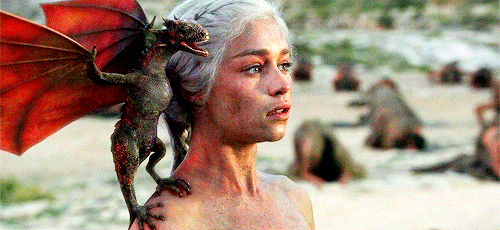
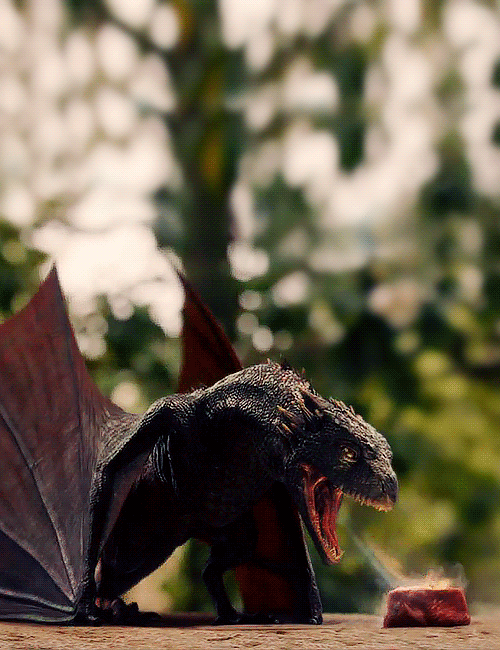
Whenever daenerys acts like a Valyrian or behaves like a true Targaryen & let's the Fire & Blood in her out by commanding her dragons to do what they do best. Whenever daenerys let's the dragons behave like themselves they grow closer to her. Their bond shows best at such a time.

Again when daenerys acts like a Valyrian during the sacking of Astaphor & truly allows the greatest weapons of war in the world her Dragons to do what they do best she brings them closer to herself.


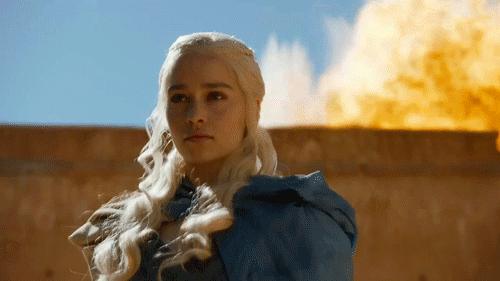
And then as the dragons grew in age & in size their viciousness grew as well & they became harder to be tamed. While this was one of the many reasons why it was harder for dany to tame them but that isn't it. Daenerys locked them away for the sake of the safety of people of mereen like her ancestors who made the Dragon Pit to lock away their dragons. Being treated as a mere pet doesn't do well with dragons instead of being captured drogon escapes while Rhaegal & Viserion are imprisoned. When daenerys tries to be a Queen unlike the Targaryen Queen that she should be & sort of resists her Valyrian nature the dragons grow apart from her. For a long time Daenerys tried to be a different sort of queen for mereen so drogon knew he wouldn't survive the captivity like the dragons before him & he escaped. But the bond never died as long as the blood of Old Valyria flows within dany she will always have a bond with the dragons. Drogon doesn't let her touch him until he returned to Daznak's fighting pits & in a way reminds her what she is & she rides him for the first time.
Beyond the books what also happened is drogon gave her a taste of who she really is, a Dragon in her own right! After which she burns all the khals & was reborn in the fires again which gained her drogon's allegiance.
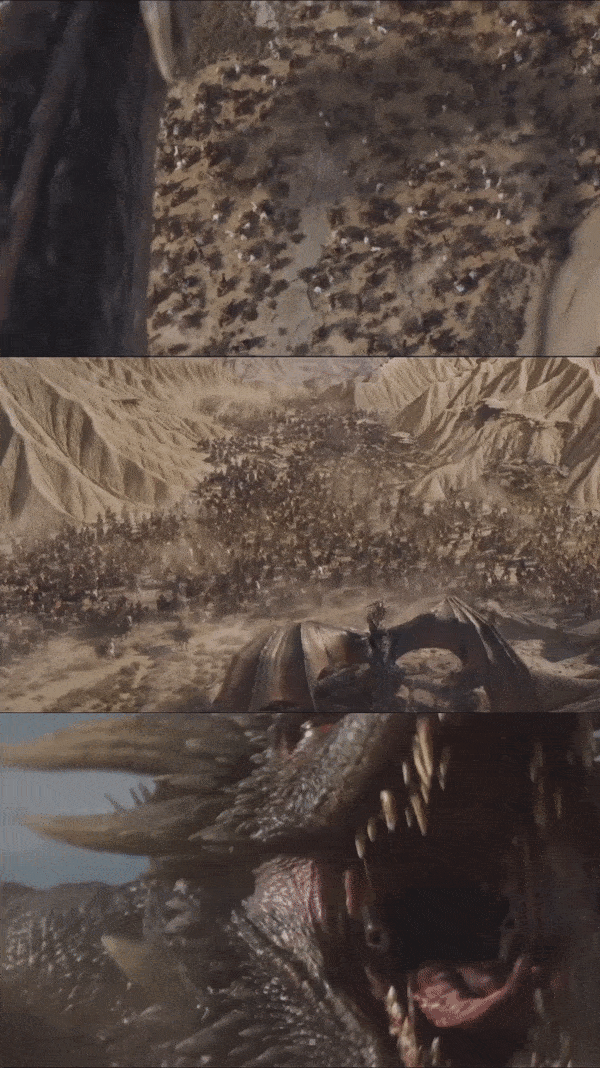
I suppose there were elements of Jon's Targaryen heritage coming to play when drogon accepts his touch in S07. But it's not drogon who burns quentyn it's Rhaegal because quentyn tried to tame him without any blood of Old Valyria. Jon embracing his Targaryen heritage will be complete when he becomes a dragon rider himself. But before that not only does drogon accept Jon but also recognizes something in Jon, drogon already has a rider so it was just a moment of recognition. Tyrion has also touched both Rhaegal & Viserion but they didn't recognize anything in him except the fact that he isn't a foe & they didn't harm him. Apart from recognizing blood in Jon; drogon is now not only a full grown embodiment of Targaryen sigil but also an extension of daenerys's personality. That's why he is roaring while dany is roaring her bloodriders speech. They have truly become bound to one another! Quaithe's words of remembering that she is blood of dragon is complete now because she has truly become a dragon, she's owning it!
Continued
27 notes
·
View notes
Photo

For the week of 11 March 2019
Quick Bits:
Age of Conan: Bêlit #1 expands Marvel’s Conan franchise further with the beginning of this limited series featuring the early days of the notorious pirate Queen of the Black Coast. Tini Howard, Kate Niemczyk, Jason Keith, and Travis Lanham deliver a compelling story setting up the tragedy of Bêlit’s early life and her one-track mind for adventure on the high seas.
| Published by Marvel
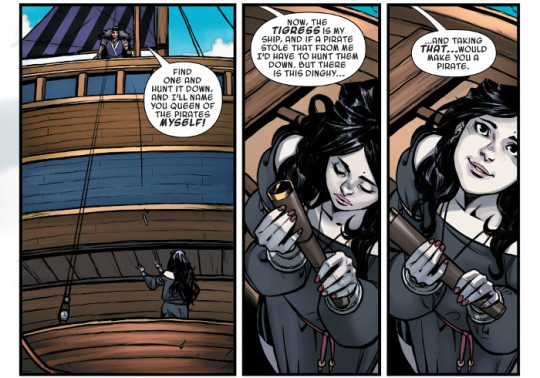
Amazing Spider-Man #17, after two preludes (one branded, one not) and a simmering sub-plot of Taskmaster and Black Ant kidnapping the villains running for months, finally gives us part one of “Hunted” from Nick Spencer, Humberto Ramos, Victor Olazaba, Edgar Delgado, and Joe Caramagna. And it’s essentially more set-up. Don’t get me wrong, it’s still great, building anticipation for the hunt to really start in earnest, but it’s a slow build.
| Published by Marvel

Animosity #19 starts trying to pick up the pieces after the fall of the Walled City. There’s some very interesting questions raised regarding survival and existence from Marguerite Bennett in this one, as both the animals and humans try to figure out a way to bridge the divide.
| Published by AfterShock

Asgardians of the Galaxy #7 concludes this arc with Sera and the Ravagers, as they team up to help refugees and Ego, the Living Planet. I still think it’s weird to see essentially the movie version of Yondu in present day 616 continuity, but Cullen Bunn keeps this fun. I suspect that Sera/Angela fans will still be disappointed, though.
| Published by Marvel

Assassin Nation #1 is the exciting debut of this action thriller, somewhat in the vein of Skybound’s other title Die!Die!Die! mixing elements of extreme violence, action, and a bit of humour, from Kyle Starks, Erica Henderson, and Deron Bennett. It’s a damn good set up, immersing us into a world of assassins jockeying for a number one spot, screwing one another over and turning on them for the highest bidder, with two interesting hooks of “Chekhov’s Gun” trying to figure out who’s trying to kill him and Bishop searching for who killed his husband. Phenomenal art from Henderson, with some very inventive death sequences.
| Published by Image / Skybound
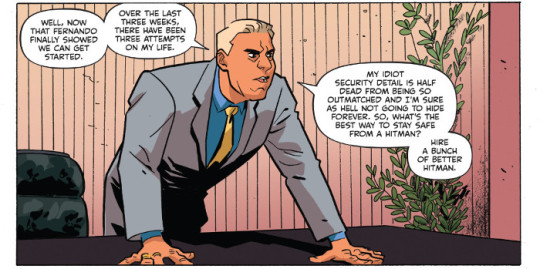
Avengers: No Road Home #5 takes it up another notch as the Avengers continue to battle against Nyx and her children, this time narrated by Scarlet Witch. The fight on Nightmare’s front gets particularly interesting as we see how scary Hulk has really become, along with a humorous fight between Hawkeyes. Sean Izaakse and Marcio Menyz really turn in some incredible artwork here. And the final scene is pretty savage.
| Published by Marvel

The Batman Who Laughs: The Grim Knight #1 isn’t something I was going to pick up, but I saw some gushing about it from people I trust and decided on a last minute purchase. Like the rest of the Batman Who Laughs mini-series, this is dark, giving us a “Batman” who picked up the gun that was used to murder his parents, and, though technically proficient, isn’t really for me. What I do really appreciate, though, is the artwork from Eduardo Risso and Dave Stewart. It is gorgeous, with Risso continuing to explore some of the softer, painted style that he’s used in Moonshine and Hit-Girl. It really is worth the price of admission.
| Published by DC Comics
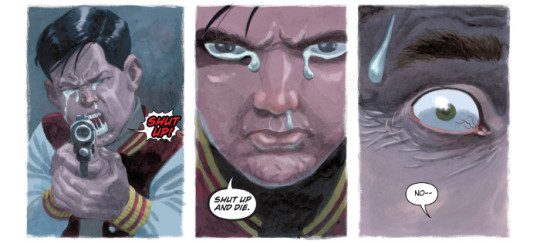
Buffy the Vampire Slayer #3 continues to be one of my favourite comics each month. Jordie Bellaire, Dan Mora, Raúl Angulo, and Ed Dukeshire are presenting a story here that so perfectly captures the spirit and fun of the television series, while also just being a great original tale. It’s fun to see the old faces in new situations, but it’s also an enjoyable story in its own right, introducing us to the characters and tossing them into the chaos.
| Published by BOOM! Studios
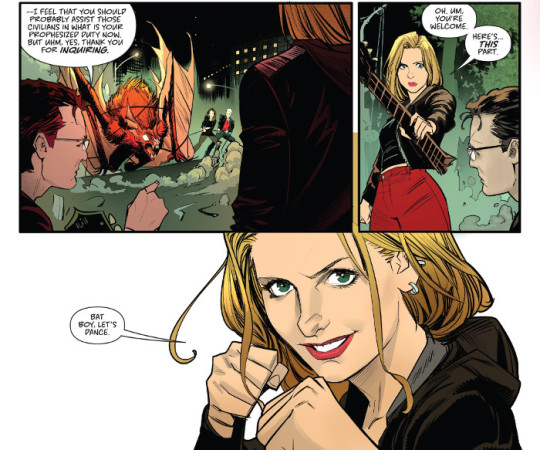
By Night #9 gives us Jane’s mom’s history with Charlesco and more or less the origin of the portal and the experiment. It’s particularly interesting as John Allison, Christine Larsen, Sarah Stern, and Jim Campbell tell the story in the visual style of an early ‘90s comic. There’s even a nice little nod to the Marvel Bullpen in there.
| Published by Boom Entertainment / BOOM! Box
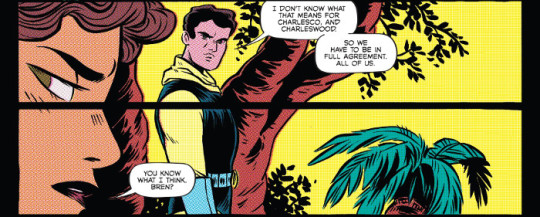
Calamity Kate #1 introduces us to Kate, Vera, Jade and a world of monster hunting in this debut from Magdalene Visaggio, Corin Howell, Valentina Pinto, and Zakk Saam. Between this, The Girl in the Bay, and the forthcoming Dark Red, I’m loving the higher profile that Howell is carving for herself. She’s a great artist with excellent versatility.
| Published by Dark Horse

Catwoman #9 is a fill-in issue from Ram V, John Timms, and Josh Reed that’s one part revenge tale and one part heist, resulting overall in one hell of a good single issue. There’s a nice sense of rhythm and pacing to the story that fits with the theme of the heist, with some great artwork.
| Published by DC Comics
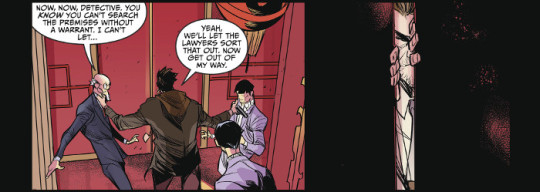
Cover #6 brings what has been one of the most unique, ambitious, and inventive uses of the comics medium I’ve seen in a long time to a close, with a bit of conversation and some gorgeous art from Brian Michael Bendis, David Mack, Zu Orzu, and Carlos M. Mangual. It get even more meta this issue, along with the usual multi-layered storytelling that delves into the comics world.
| Published by DC Comics / Jinxworld
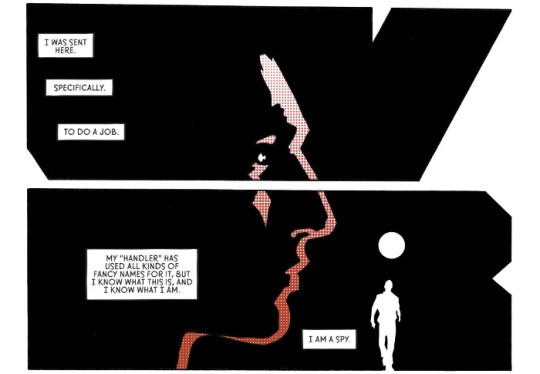
Cyber Force #9 more or less completes the gathering of the team, presenting a bit of a quiet moment to collect themselves before setting up a confrontation with Cyberdata. There’s some interesting soul-searching between Dominique and Ripclaw on whether or not with the change they’re still them. And, as usual, the art from Atilio Rojo is pretty much worth the price of admission on its own.
| Published by Image / Top Cow

The Empty Man #5 has some gorgeous artwork by Jesús Hervás and Niko Guardia, especially among the repeating cycles of the opening and closing scenes.
| Published by BOOM! Studios

The Flash #66 brings back the single issue Rogue profile format for an origin story of the original Trickster, James Jesse, from Joshua Williamson, Scott Kolins, Luis Guerrero, and Steve Wands. Great art from Kolins and Guerrero.
| Published by DC Comics

The Freeze #4 concludes the first arc, with a very satisfying reveal of the serial killer and confirmation on a few other ongoing plot threads that nicely serve as a hook for future arcs. I’m really enjoying this one. Dan Wickline, Phillip Sevy, and Troy Peteri are telling a very compelling story here about essentially rebuilding society from a very different form of cataclysm, with some wonderful character-building and enough intrigue to keep you on your toes.
| Published by Image / Top Cow

Grimm Tales of Terror #13 is one of the better recent issues, with Joe Brusha, Umberto Giampà, Fran Gamboa, JC Ruiz, and Fabio Amelia diving into the story of a true crime writer investigating a serial killer in Detroit utilizing the signatures of other famous serial killers. There are a few really nice twists throughout the tale.
| Published by Zenescope
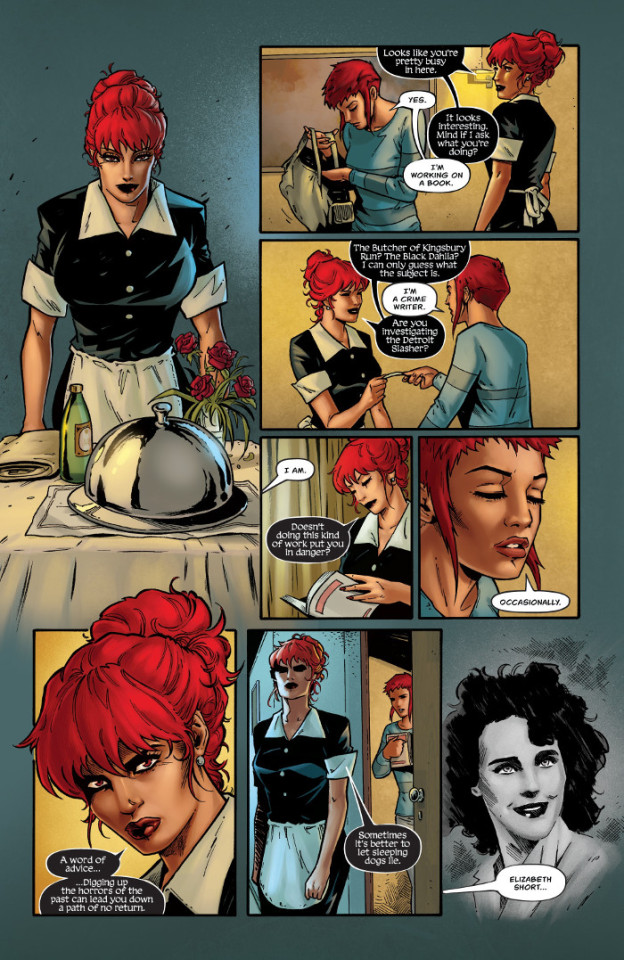
Gunning for Hits #3 throws a few wrinkles into Martin’s plans for Stunted Growth and Brian Slade as Slade’s bodyguard, “Mr. Gladstone”, causes problems while trying to extort Martin. This continues to be a dense, but satisfying, read every month. It feels like Jeff Rougvie, Moritat, and Casey Silver are just packing in as much content as they possibly can.
| Published by Image
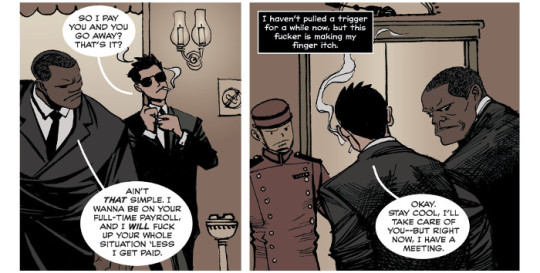
Hawkman #10 features a larger than life confrontation between Hawkman and Idamm. Bryan Hitch, Andrew Currie, and Jeremiah Skipper deliver nicely on that widescreen epic feel of the assault on London.
| Published by DC Comics
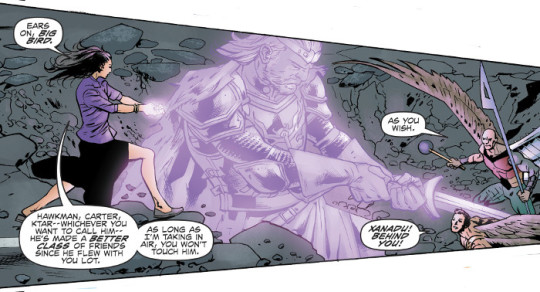
Hit-Girl Season 2 #2 gets up close and personal with the uglier side of Hollywood as Kevin Smith, Pernille Ørum, Sunny Gho, and Clem Robins continue their arc featuring the adaptation of Hit-Girl’s side of the story from Kick-Ass by the film industry. Things get a little complicated.
| Published by Image

House Amok #5 concludes what has been an excellent, mind-bending series exploring truth and delusion and the power of family, from Christopher Sebela, Shawn McManus, Lee Loughridge, and Neil Uyetake. This finale doesn’t give any easy answers and actually raises a few more questions, all with some gorgeous artwork from McManus and Loughridge.
| Published by IDW / Black Crown

James Bond: Origin #7 begins “Russian Ruse” with Ibrahim Moustafa and Roman Stevens taking over art duties, joining Jeff Parker and Simon Bowland in this tale of essentially piracy in the Barents Sea. Nice set up of the Russians’ duplicity here and an inept Commander not listening to Bond’s observations.
| Published by Dynamite

Justice League Dark #9 unleashes the Lords of Order against pretty much everyone, causing death and destruction as they try to “cleanse” reality of the chaos they think infests it. Between them and the Otherkind, things aren’t looking particularly cheery for existence. Incredible artwork from Alvaro Martínez Bueno, Miguel Mendonça, Raul Fernandez, and Brad Anderson.
| Published by DC Comics

Little Bird #1 is an experience. Darcy Van Poelgeest, Ian Bertram, Matt Hollingsworth, and Aditya Bidikar launch a dystopian future where a theocratic America seems to rule with an iron fist and a pocket resistance holds out in the Canadian Rockies. There’s a bit of a feel of Akira here, and Grendel: God and the Devil, maybe even a little Martha Washington, but still with its own unique elements and some seriously awesome art from Bertram and Hollingsworth.
| Published by Image
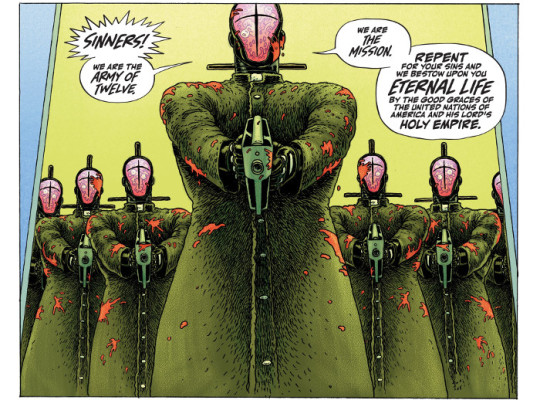
Livewire #4 concludes the first arc with a nice bit of soul-searching as Amanda comes to terms with what she did during Harbinger Wars 2. Between this, Age of X-Man: Prisoner X, and this week’s Shuri, Vita Ayala is definitely on fire right now. They’re doing some great character-driven work and it shines in this finale. Also, Raúl Allén and Patricia Martín can do no wrong. The layouts on this book are stunning.
| Published by Valiant
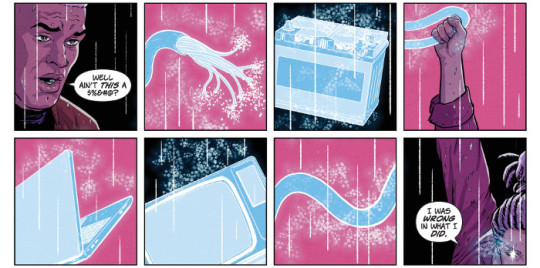
The Magnificent Ms. Marvel #1 is the beginning of a new era for Kamala Khan from Saladin Ahmed, Minkyu Jung, Juan Vlasco, Ian Herring, and Joe Caramagna. Using a kind of fable narration, setting up something new for the future while dealing with a continuation from Kamala’s current status in the presents, is a nice approach from Ahmed. It also marks a good jumping-on point for new readers as it recaps more or less what you need to know about Ms. Marvel’s history. Beautiful art from Jung, Vlasco, and Herring.
| Published by Marvel

Murder Falcon #6 is an epic, face-melting issue. Daniel Warren Johnson and Mike Spicer give us a bit of a tearjerker as Anne comes to terms with her situation with Jake and finally finds her voice. It’s really incredible. Also, giant monsters and metal.
| Published by Image / Skybound

Oblivion Song #13 jumps ahead three years for a new status quo, a few shuffled faces, and new situations for many of the cast of characters, providing an excellent jumping on point for new readers. There are some interesting bits about harnessing the flora and fauna of Oblivion for medical advances and the growing mystery about what the Faceless Men are doing. Gorgeous art as always from Lorenzo De Felici and Annalisa Leoni. De Felici really does some amazing reaction shots.
| Published by Image / Skybound

Old Man Quill #3 advances the Guardians’ story a bit further as they celebrate what little hope they’ve brought to the Wastelands, while hell in various forms circulates around them. It certainly pretty bleak, even in the good times.
| Published by Marvel

Outer Darkness #5 drops hell on the crew’s head as they crash on a relatively inhospitable ice planet with an ancient evil prowling and the crew at “Each Other’s Throats”. Also, naked cat girls. John Layman, Afu Chan, and Pat Brosseau are doing an incredible job with this mix of sci-fi and horror and the stakes seem to have been raised this issue.
| Published by Image / Skybound

Shuri #6 begins a two-part guest arc from Vita Ayala, Paul Davidson, Tríona Farrell, and Joe Sabino as Shuri travels to New York in search for the Lubber. Great art from Davidson and Farrell and Ayala has a wonderful feel for Miles and Shuri’s voices.
| Published by Marvel

Spider-Gwen: Ghost Spider #6 continues to suss out a new role for Gwen now that her identity is public and she’s returned to her own Earth. The character building that Seanan McGuire is doing here is pretty spectacular, especially given how strong the interpersonal relationships in the series were to begin with under Jason Latour and Robbi Rodriguez. Also, the art from Takeshi Miyazawa and Ian Herring is perfect.
| Published by Marvel

Star Wars: Age of Republic - General Grievous #1 is the last of these Age of Republic one-shots from Jody Houser, with Age of Rebellion coming next from Greg Pak and a rotating team of Chris Sprouse, Marc Laming, and others. This one focuses on Grievous and is a nice look into what he traded of himself in order to become the even worse monster that we see in the prequel trilogy and Clone Wars.
| Published by Marvel

The Stone King #4 concludes what has been a wonderful light fantasy adventure Comixology original series from Kel McDonald and Tyler Crook. There’s an interesting throughline in the story of responsibility for family versus responsibility for the greater society that comes to a head here, along with misunderstandings continuing to cause conflict. It’s not exactly a happy ending, but there is a set up for something more down the road that I’d love to see. Beautiful artwork from Crook.
| Published by Kel McDonald
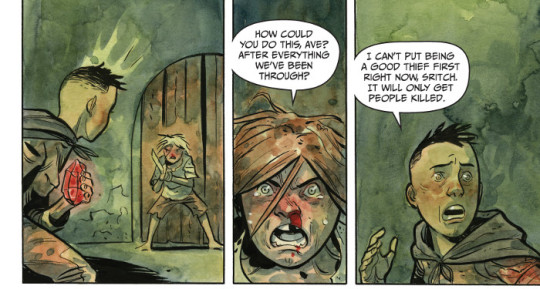
Supergirl #28 concludes her jaunt with the Omega Men and the Supergirl clones, opening up more questions about The Circle and the destruction of Krypton. I’ve enjoyed the circuitous route Marc Andreyko has been taking us on to advance Supergirl’s mission, tossing bits of side adventure in growing out of her search, but it feels like we’re going to get down to brass tacks soon. Great art again this issue from Eduardo Pansica, Julio Ferreira, FCO Plascencia, and Chris Sotomayor. Pansica does some great horror and creature work and it shines through in the Kryptonian monstrosities.
| Published by DC Comics
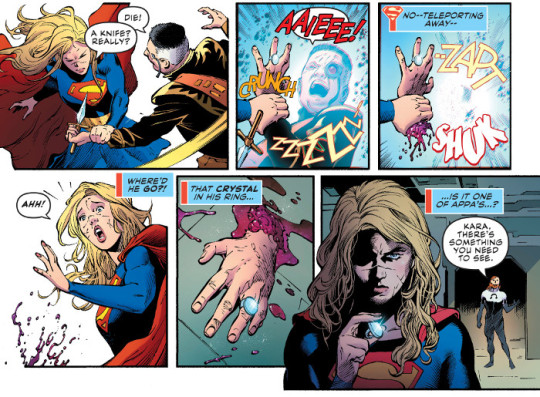
Superman #9 tells of Jonathan’s ordeal trapped on Earth 3, tortured at the hands of Ultraman. Great art from Brandon Peterson and Alex Sinclair during the Earth 3 sequences. It’s also interesting to see that dream still haunting Superman.
| Published by DC Comics
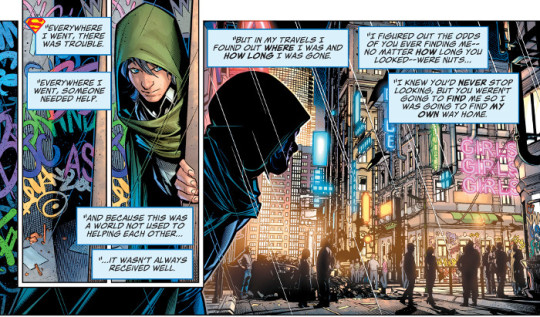
Teenage Mutant Ninja Turtles: Shredder in Hell #2 continues to be revelatory. Mateus Santolouco, Marcelo Costa, and Shawn Lee are doing some incredible work as Shredder continues to be plagued by nightmares, demons, and the undead as he tries to figure out his way through hell and his status as a vessel for the dragon god’s spirit. Over the years, Santolouco has grown exponentially as a storyteller and this is just a masterpiece.
| Published by IDW
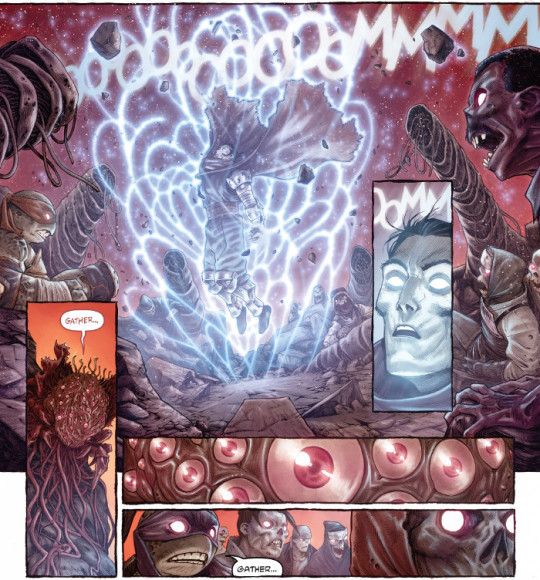
Titans #35 continues the team’s nightmare excursion to Unearth, fighting a possessed enraged Beast Boy, Raven’s angry aggressive side, and Mother Blood as we head into the series conclusion next issue. This is a very entertaining story from Dan Abnett, Bruno Redondo, Christian Duce, Marcelo Maiolo, and Dave Sharpe, really putting the team behind the 8-ball wondering how they’re going to get out of this mess. If they get out this mess.
| Published by DC Comics

Tony Stark: Iron Man #9 continues the “Stark Realities” arc, nicely advances Controller’s assault on Stark Industries, the eScape users causing havoc, the mole within Stark, and the corruption causing Tony’s current simulation, from Dan Slott, Jim Zub, Valerio Schiti, Paolo Rivera, Edgar Delgado, and Joe Caramagna. Some really interesting possible revelations about Tony during this issue.
| Published by Marvel

Transformers #1 begins a new continuity, a new universe, a new era for the Transformers, from Brian Ruckley, Angel Hernandez, Cachét Whitman, Joana Lafuente, and Tom B. Long, as we start off some time in the past of Cybertron, before Autobots or Deceptions, as Bumblebee watches over a newly-forged Cybertronian as he makes his first decisions. We also get bits of an uprising of “Ascenticons”, though their ideals and motivations aren’t really explained, just showing a disagreement between longtime friends Megatron and Orion Pax (not Optimus Prime yet). It’s not bad, with some nice bits of humour, and there is an interesting mystery for a cliffhanger, but it is slow. The art is nice, but like the story there’s nothing flashy about this right now. I’ll certainly give it a few more issues, but there’s really nothing “bold” about this new era. Don’t expect something radical out of the first issue, this one plays it pretty safe.
| Published by IDW
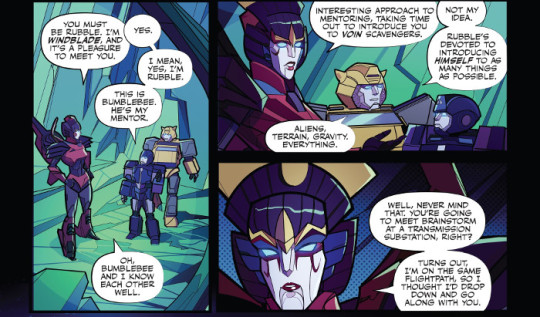
Winter Soldier #4 delves into RJ’s father, Richie, attempting to get back into his life. It’s heartfelt and bittersweet, with Kyle Higgins, Rod Reis, and Clayton Cowles delivering a gripping tale with one hell of a set up for the final issue. Reis’ art remains absolutely incredible.
| Published by Marvel

Wonder Twins #2 is more fun from Mark Russell, Stephen Byrne, and Dave Sharpe. There’s some nice commentary on the state of corporate run prisons in the United States in amongst a humorous send-up of z-list villains in the Legion of Doom’s farm team, the League of Annoyance. Great art from Byrne.
| Published by DC Comics / Wonder Comics

Other Highlights: Accell #19, Auntie Agatha’s Wayward Home for Rabbits #5, Blackbird #6, Dark Ark #15, GI Joe: A Real American Hero - Silent Option #4, Go Go Power Rangers #18, The Goon #1, Head Lopper #11, House of Whispers #7, LaGuardia #4, The Life and Death of Toyo Harada #1, The Long Con #7, Marvel Action: Spider-Man #2, Marvels Annotated #2, The Maxx 100 Page Giant, Prodigy #4, The Punisher #9, Radio Delley, Rick & Morty Presents Jerry #1, Riverdale: Season 3 #1, Runaways #19, Spider-Man/Deadpool #47, Star Trek: Discovery - Captain Saru, Star Wars: Han Solo - Imperial Cadet #5, The Unbeatable Squirrel Girl #42, Wonder Woman #66
Recommended Collections: Astonisher - Volume 3: Black Hat, Batman vs. Deathstroke, By Night - Volume 1, Defenders: The Best Defense, Infinite Dark - Volume 1, Mata Hari, Moonstruck - Volume 2, Rick and Morty vs. Dungeons & Dragons, Shadowman - Volume 3: Rag & Bone, She Could Fly, Sleepless - Volume 2, Star Wars Adventures - Volume 5: Mechanical Mayhem, Strangers in Paradise XXV - Volume 2: Hide and Seek, Trout - Volume 1: Bits & Bobs, Vampironica - Volume 1, The War of the Realms Prelude

d. emerson eddy knows a muffin man.
2 notes
·
View notes
Note
What would be your DC Starter pack?
I’ve put together equivalent lists for Superman and Batman in the past (and in deference to that I’m leaving them off this list; take Superman: Birthright/All-Star Superman and Batman: Zero Year as what I’d put on here), but this is obviously an entirely different ballgame. DC is BIG, with all manner of different corners and subgenres to it - getting into it as a whole is a pretty substantial undertaking even for those who’re already fans of a handful of given characters. But as before, here’s a set of springboards - 15 this time instead of 10 given the scope of the undertaking - for getting a sense of how DC as a whole works, and what aspects of it you might want to pursue further, almost all of which should be available on Comixology or at a local comic book shop. Two caveats up front though:
* I’m sticking to titles that can claim at least some sort of tangential, secondhand connection to the ‘main’ universe, if even by the absolute slimmest of threads, so I’m not including the likes of Astro City, Transmetropolitan, Preacher, Ex Machina, etc., even though they’ve all been published by DC and absolutely deserve your attention.
* Since this is for prospective new readers, I’m with a singular exception sticking with comics from the mid-1980s or later.
1. The World’s Greatest Superheroes

What it’s about: A group of six oversized all-ages comics by Paul Dini (critically involved with many of the DC family of cartoons, especially the beloved shared universe of shows extending from Batman: The Animated Series to Justice League Unlimited) and Alex Ross; four stories focusing on Superman, Batman, Wonder Woman, and Captain Marvel handling ‘real world’ issues, the Justice League trying to stop a very different kind of global threat than their usual supervillains, and a set of origins for most members of the classic Justice League of America.
Why you should read it: If you’re in the market for a one-stop shop of “what’s the deal with DC Comics?”, then this is as good as you’re gonna get. A set of introductory stories with their biggest icons by proven crowdpleasers, along with a set of storybook-esque explanations for a bunch of their other biggest heroes (at least among the ‘classic’ crowd) to boot.
Further recommendations if you liked it: This is more a “getting your feet wet” example than a direct gateway to other material (especially since most of the all-ages titles I’d suggest following up on this I mentioned in those Superman and Batman starter packs), but it’s notable that Captain Marvel plays such a prominent role in here given how scaled-back his presence has become over the years. He’s terrific when handled properly, and past his original 1940s comics, I’d recommend Shazam!: The Monster Society of Evil, The Multiversity: Thunderworld (while that’s part of a larger series this issue works perfectly well standalone), and Convergence: Shazam! (ditto).
2. DC: The New Frontier
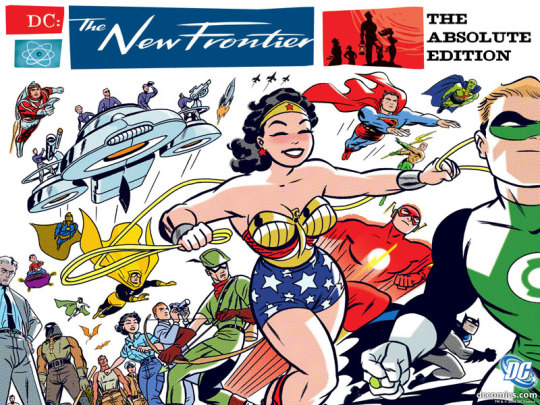
What: In the 1950s the age of heroes seems to have come to an end - most of the Justice Society of America retired following congressional inquiries, Superman and Wonder Woman have grudgingly aligned directly with the United States government so that they can continue operating somewhat unobstructed, and the Bat-Man has gone underground, while human champions such as the Challengers of the Unknown, the Blackhawks, Task Force X, and the Losers now carry the day. But with the dawning of a new era, the first stirrings of a new generation of extraordinary individuals, and the creeping emergence of a new threat, all of America’s heroes must unite to defend and shephard in its future if it is to have any future at all.
Why: A radically different origin for the Justice League set against the backdrop of McCarthy’s America and the beginnings of the space race, it’s largely considered to be the late Darwyn Cooke’s masterpiece, and one that perhaps more than any other story demonstrates the breadth and potential the larger universe offers. It’s a rugged, heartfelt, soaring story of our strive to reach farther and better ourselves in the face of a world that would fight back against that impulse, and one that draws on every corner of the world it’s set in to show old and new fans alike how it comes together as more than the sum of its parts when handled right.
Recommendations: Two of the three main heroes presented here - Flash, Martian Manhunter, and Green Lantern - have quite a stock of classic adventures of their own, which I made some recommendations from here and here (on top of those I’d recommend Tim Seeley’s tenure on Green Lanterns, which just began last week with issue #33). For the beginnings of the “superheroes dealing with Relevant Social Issues” strain of comics that this delves into, there’s the classic Green Lantern/Green Arrow run, which has aged awkwardly but was a seminal moment for DC, and established Green Arrow as he’s known today (who I understand has been doing well in his current Rebirth title under Ben Percy, if you want to pursue him further). And for large-scale DC sagas drawing from across the scope the universe and interrogating the place of superheroes within it, I have to mention Kingdom Come, Mark Waid and Alex Ross’s end-of-days vision for the latter-day Justice League and their world that proved one of the company’s most enduringly popular and influential books.
3. Wonder Woman: Year One

What: When pilot Steve Trevor crash-lands on the hidden island of Themyscira - a mythical paradise where immortal warrior women live in peace and prosperity under the protection of the Greek gods themselves - Diana, daughter of queen Hippolyta, volunteers to escort him back to Man’s World and serve as their ambassador knowing that she may never return. Finding her place in a strange new culture, discovering the depths of her power, and detecting the hand of the gods in mortal affairs, these are the first steps towards a girl fashioned from clay becoming Wonder Woman.
Why: You know who Superman and Batman are, so you should get a decent grasp on the other member of the ‘trinity’ that props up the rest of the universe too, and this is as fine a place to begin with Wonder Woman as it gets thanks to Greg Rucka’s fantastic handle on the character and Nicola Scott’s absolutely gorgeous, iconic artwork. It tells you everything you need to know and shows you everything you expect to see, and it does the best job of it that anyone yet has.
Recommendations: For another take on Diana’s early days and adventures I can’t recommend enough The Legend of Wonder Woman, a recent all-ages take on her origin set in World War II that brings more depth to Paradise Island itself than I’ve seen elsewhere and serves as an at least equally fine introduction; I chose Year One since it’s both contemporary and the current ‘official’ origin. The rest of Greg Rucka’s run here is fine, but a lot of it is essentially cleaning up the larger mythology since Wonder Woman’s background and world had undergone some major revisions in prior years; his original run is what I’d recommend, essentially him handling her as a political drama. Aside from those two, Gail Simone’s run on the character is I believe easily the most universally-beloved modern take on her, and what I’ve read absolutely lives up to that. I do also have to mention her original 1940s adventures, which were bizarrely playful and politically unusual in a way that little else with her has been since. Steve Orlando’s work with her, while segmented, is also among her best.
4. History of the DC Universe
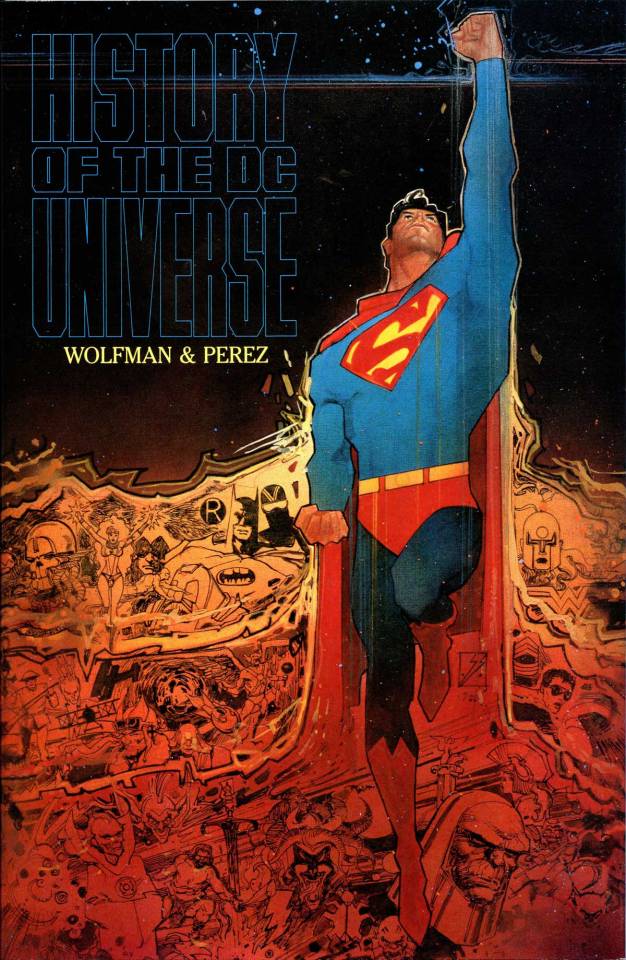
What: A recording by the woman Harbinger, one of the only survivors of a cosmic crisis that shredded and reassembled reality to recall the full extent of what was lost, detailing the ‘new’ history of humanity from the dawn of civilization to the end of time.
Why: I don’t want to make too many concessions with this list to what’s ‘important’ over what’s good, and large chunks of this are long since out of date anyway. But in terms of getting a sense of the world as a whole, having a basic outline of what’s a big deal and what happened when certainly helps.
Recommendations: If you want more that can give you a sense of the history of the larger world, I’d recommend Flash of Two Worlds! as the introduction of the multiverse, Crisis on Infinite Earths as the (temporary) dissolution of that multiverse and a truly major event that’s still being referred back to, The Multiversity Guidebook which - in spite of some connections back to the main story that’ll only make so much sense without reading the rest of it - outlines the history and current cosmological setup of that multiverse (though even that’s since been upheaved with the official reintroduction of an infinite multiverse around the ‘core’ 52 universes, even if it hasn’t been taking center stage), and DC Rebirth, which sets up and foreshadows most of the big stories happening right now. I’d also suggest trying Supreme: Blue Rose, a pseudo-sequel to Alan Moore’s classic run on Supreme (a book that under his direction was essentially one long riff on DC Comics and Superman in particular) which takes a much heavier and stranger look at a new version of that world from a ground-level perspective, telling the story of what it feels like to live in a universe constantly subject to reboots and revisions in the way DC is.
5. JLA
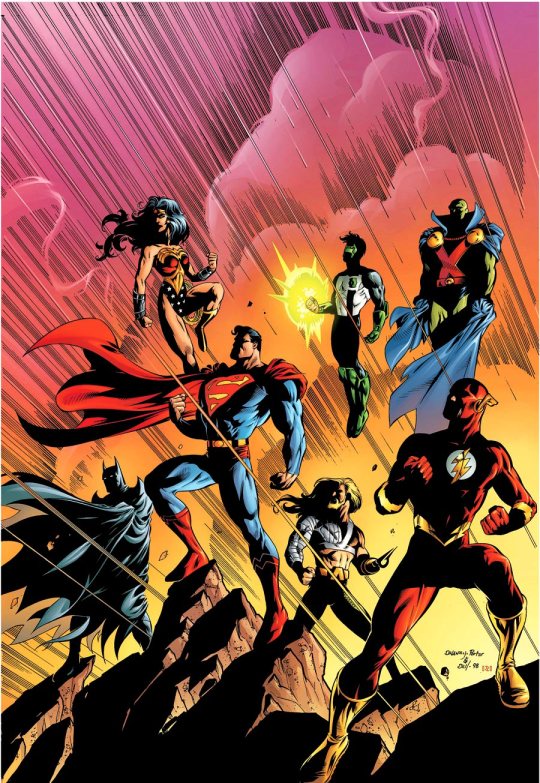
What: The return to an iconic Justice League lineup under Grant Morrison after years of second and third-stringers, this run pits them against some of the wildest, weirdest, and most definitely BIGGEST threats of their considerable careers, from a new Injustice Gang and Solaris the Tyrant Sun to renegade angels and warring higher-dimensional colors.
Why: The template for 21st century Big Action Superhero Comics, defined by excellent characterization and incredible setpieces, it’s the premiere example DC’s big guns working together alongside allies from across the universe against the worst the universe has to throw out them. A lot of what defines modern DC’s approach to how these characters are supposed to work together and what constitutes a threat to their entire universe traces directly back to here.
Recommendations: In the immediate aftermath of Grant Morrison’s run, Kingdom Come writer (and already part-time fill-in writer on the book) Mark Waid took over with existing artist Howard Porter and The Authority big gun Bryan Hitch, in a run that’s similarly worth your time and in many ways just as influential for its first story, Tower of Babel; you can and probably should collect both runs across JLA Deluxe Edition Volumes 1-6. Speaking of The Authority, both Warren Ellis/Bryan Hitch and Mark Millar/Frank Quitely’s original runs on the team represent the refinement of the widescreen formula JLA pioneered to a brutal science, and Steve Orlando’s handling of series breakout star Midnighter in his own title set in the DCU proper - along with the followup mini Midnighter and Apollo - pushed it even further. Orlando’s gone on to write JLA himself, starring an eclectic lineup led by Batman trying to hang in there against the kind of cosmic horrors the classic model fought back against, and that’s definitely worth your time, as are numerous arcs of JLA Classified (particularly Morrison’s opening that acted as a prequel to his book Seven Soldiers of Victory, Warren Ellis and Jackson Guice’s New Maps of Hell, and Gail Simone and Jose Luis Garcia Lopez’s The Hypothetical Woman). Meanwhile, Christopher Priest and Pete Woods took the Authority’s influence on the team in an entirely different direction with a brief, clever, politically-flavored run. On top of those, I’d suggest Aztek, a short-lived series by Morrison and Millar around the same time as the original JLA that ultimately figured into it, and Geoff Johns and Mike McKone’s Teen Titans, which mixes the broad strokes of the approach with the requisite teen soap opera and yields probably the best take on that group outside the mid-2000s cartoon. Most substantially however is Scott Snyder’s extended Justice League run (with a number of recurring partners, primarily cowriter James Tynion and main artist Jorge Jimenez) spinning out of his Dark Knights: Metal event comic with Greg Capullo, a gleefully sincere supercharged jolt of color to the DCU that takes the best of Morrison’s approach and runs in a completely different direction with it.
6. Tom Strong

What: Born at the turn of the 20th century on the island of Attabar Teru to a pair of scientists and raised in a gravity chamber, the stories’ titular hero was freed in an earthquake that killed his parents and raised by the natives - journeying at 21 to Millennium City to learn of the legacy his parents left for him, he found himself a “science-hero” to the beleaguered metropolis. Now at the dawn of the 21st century, kept in his prime by the mythical goloka root alongside his wife Dhaula, they, their daughter Tesla, steam-powered servant Pneuman, and talking gorilla Solomon still use their wits and skills to defend their home in Millennium, and unknown realms far beyond.
Why: With the recent announcement of the Strong families’ integration into the DCU in some fashion it’s likely these comics are going to be reprinted, and that’s a darn good thing - as far as I’m concerned, they’re the platonic ideal of classic-flavored superhero books. Fun, funny, adventurous and warm-hearted, while it wasn’t intended as part of DC it represents its arguable baseline tone and approach as well as any comic ever has; if this ends up doing it for you, it’s likely to be a gateway to plenty more.
Recommendations: If Tom Strong does it for you, then that’s really a sign that you might be up for older DC titles in general; I made suggestions in that regard for Superman and Batman in their respective starter packs, but I’m also especially inclined to mention the likes of Metamorpho and Legion of Superheroes, alongside other titles you can pick up in DC’s inexpensive black-and-white Showcase Presents reprints (a list of which you can read here). For something more modern with a similar tone, I’d suggest Mark Waid’s 12-issue run on The Brave and the Bold with George Perez and Jerry Ordway, and for more period-piece style heroics with heart, try the currently ongoing DC Bombshells (currently running as Bombshells United).
7. Solo
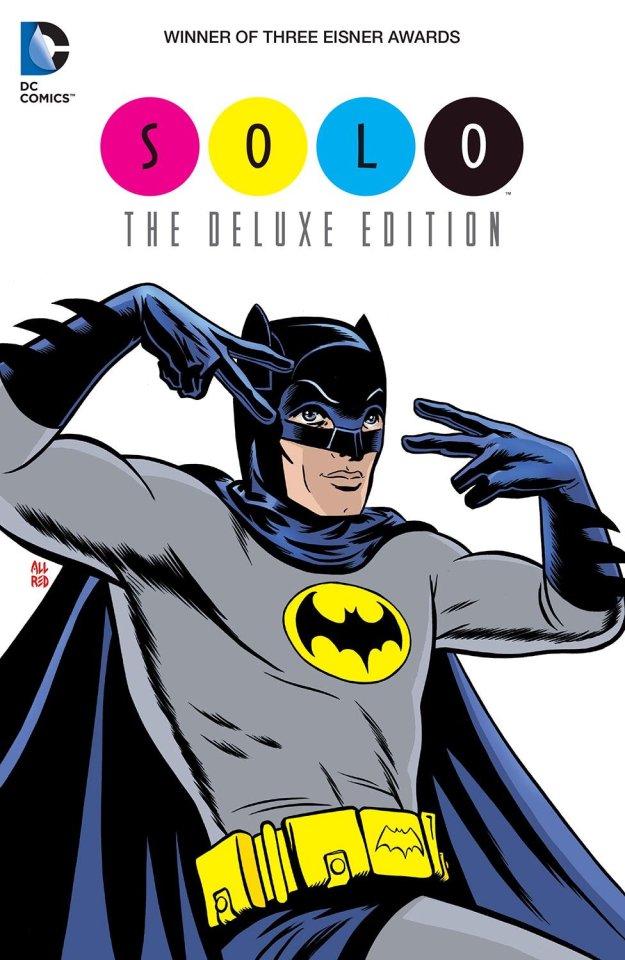
What: A 12-issue anthology, each stars a beloved artist with whichever collaborators they wish doing whatever they please, the only restriction being that at least one story must involve some permutation of some version of a DC character.
Why: I recommended Tom Strong as representative of the baseline for how DC Comics generally aspires to work; this represents the farthest possible afield territory from said baseline. Treating DC’s biggest names as broad iconographic tools to be shaped and reshaped at a given creators’ whim for the sake of their stories, this is DC as indie comics, and it’s a valuable perspective.
Recommendations: Along with Batman: Black and White, DC’s other big project in this vein was Wednesday Comics, a 12-part set of 15 running stories presented one massive page at a time in the oversized format of Sunday newspaper comics; some of them indisputably stink, but for every one of them there’s at least one fun title and one borderline-masterpiece, and nearly all of them are at least interesting. Another title significantly varying in style and content was Tomorrow Stories, from America’s Best Comics along with Tom Strong and operating in a completely different mode with each story, whether the Eisner-flavored Greyshirt or the Kurtzman-esque shenanigans of First American. And if Solo’s anarchic spirit and artistic variety appeal, I’d also have to give a shout-out to World’s Funnest, where a feud between goofball super-imps Mr. Mxyzptlk and Bat-Mite reaches multiversally catastrophic proportions.
8. Watchmen

What: Set in a 1985 that has significantly diverged from our own - first in the 1930s and 40s with the emergence of costumed crimefighters inspired by comic book heroes, and much more radically in the 1960s with the creation of the world’s one superhuman, the near-omnipotent Doctor Manhattan, who has spent the last two decades changing the technological landscape and securing American interests even as his mind grows more and more detached from any human perspective - Edward Blake is murdered. An investigation by the unhinged vigilante Rorschach uncovers that Blake was the Comedian, one of the only ‘superheroes’ to join with the government rather than be driven into retirement or forced to operate outside the law, and the detective becomes convinced that this is sign of a larger plot against the former costumed community. As the terrible secrets of the one-time crimefighters are unearthed, the question becomes not whether Rorschach is correct or as demented as his one-time comrades believe, but if it matters in the face of a Cold War escalated by Manhattan’s presence into the very real possibility of a nuclear apocalypse.
Why: Reading superhero comics at this point means reckoning with Watchmenone way or another: realistically speaking, if you’re reading this you’ve probably either already read it, already intend to get around to it, or have actively chosen not to. As a meticulous artistic construction it’s the standard by which all other modern comics are measured; as an interrogation of the genre its influence is for better or worse incalculable across the breadth of popular culture as a whole. Even minus the upcoming efforts to somehow merge these characters into the larger structure, there is no comprehensively understanding DC Comics in 2017 or beyond without reading Watchmen.
Recommendations: The most obvious suggestion - if also by far the most questionable one - is the upcoming Doomsday Clock, the thoroughly unexpected sequel where Doctor Manhattan and likely other figures from this world are revealed as having interacted and tampered with the ‘main’ DC universe, leading to some form of confrontation between Manhattan and Superman and their radically different cosmic viewpoints and representations of the moral nature of the superhero. As far as the structure and ambitions of the comic itself go, you’d likely be better served looking into the likes of Omega Men by Tom King and Barnaby Bagenda (another grimly political and acclaimed superhero comic operating on the unifying structure of the nine-panel grid), Top 10 by Moore and Gene Ha (another ABC title, this one a police procedural in a city where everyone in a superhero, it’s another 12-issue attempt by Moore at showing how superheroes would ‘really’ be using many of the same artistic tricks, but on an altogether wilder and more overtly optimistic wavelength), Miracleman (not a DC title but a book by Moore based on DC characters, and his other seminal superhero ‘deconstruction’ alongside Watchmen of the 1980s), and The Multiversity: Pax Americana (another standalone Multiversity issue, this one stars the Charlton Comics characters that inspired Watchmen’s leads and pushes its concerns and structural tricks even further in a time-bending overview of one man’s life and death that attempts to deconstruct superhero deconstructions themselves). And while not published by DC, Peter Cannon: Thunderbolt was once one of theirs and the inspiration for Ozymandias, and Kieron Gillen and Caspar Wijngaard’s 5-issue series with him is easily one of the best, most fascinating responses to Watchmen of all time.
9. Planetary
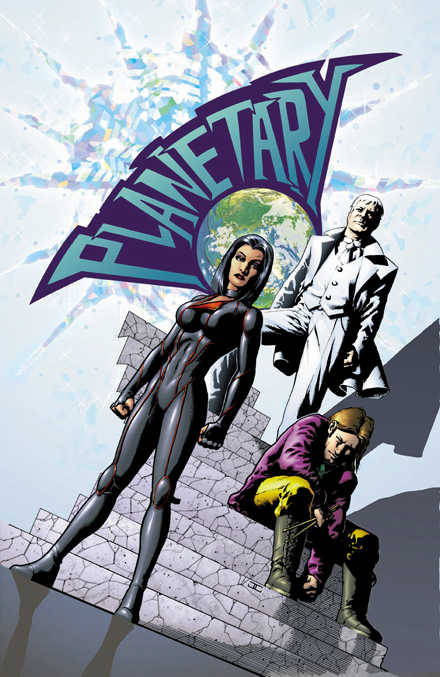
EDIT: This list was written prior to allegations made against Warren Ellis. It’s your money, but while I’d still recommend checking the book out of the library - the quality of the work isn’t going to change now that it’s out there in the universe - if you’re looking to pad your bookshelf I might recommend Al Ewing’s El Sombra trilogy in its place.
What: Elijah Snow has spent over a century bearing witness to the world’s hidden wonders and horrors, and now that he’s been recruited by the mysterious Planetary organization he has a chance to make use of that experience. Alongside the invincibly powerful Jakita Wagner and the eccentric technopath The Drummer, they are “mystery archaeologists”, investigating beneath the grim, ‘realistic’ superhero surface of the Wildstorm universe to uncover the buried, wondrous mysteries hiding in its corners, from Kaiju graveyards to lost underground city-ships from beyond the cosmic fields we know. As well as hunting the greatest mystery of all: the force that has conspired to keep these miracles a secret.
Why: Essential to an appreciation of a superhero universe is a well-developed sense of wonder: Planetary built itself on distilling artifacts of 19th and 20th century pop culture (typically by proxy) down to their most essential ideas and iconic values as mysteries to be unveiled, whether 1920s pulp heroes, Godzilla, Sherlock Holmes, 80s and 90s Vertigo comics, James Bond, John Woo revenge flicks, or any of a dozen others, so as to best allow them to be appreciated in that regard. It’s a celebration and reinvigoration of the base genre components that have made up American comics for lifetimes, an articulation of an approach that merges the intimate and grungy with the cosmically fantastic, and a masterwork of one-shot comics storytelling.
Recommendations: The immediate things that come to mind are, well, other Wildstorm comics by Warren Ellis, specifically his original run on Stormwatch where he turned a generic edgy ‘realistic’ superhero black-ops book into a bizarre political sci-fi adventure series with a bloody black wounded heart that later became the far more popular The Authority, and his fascinating relaunch of the universe line in The Wild Storm and assorted titles under the imprint of the same name; I also have to recommend by reputation Ed Brubaker and Sean Phillips’ Wildstorm crime comic Sleeper. Also, there’s Wildcats 3.0, which similarly converts a formerly achingly 90s title into a corporate drama as a gaggle of superhumans deal with the obstacles in attempting to provide a boundless energy source.
10. JLA/Avengers
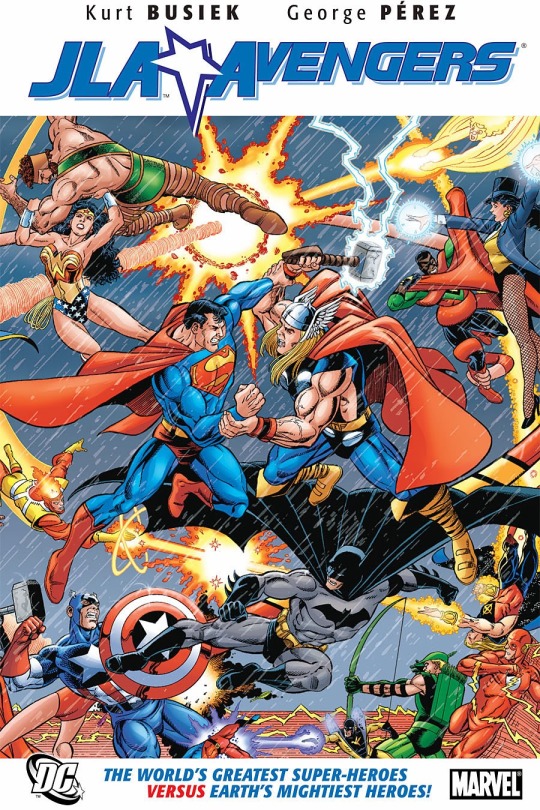
What: When the manipulative Grandmaster and the amoral cosmic seeker Krona decide to settle their titanic dispute via proxy, the greatest superheroes of two worlds find themselves pitted against one another in a conflict that leaves each of their realities’ at stake.
Why: There’s little better way to understand something than through contrast, and that at its core what JLA/Avengers is about: enmeshed within a fantastically written and drawn fanpleasing crossover adventure, easily the best of its kind, is a story on just what it is that separates the worlds of Marvel and its distinguished competition on a basic conceptual level, and how they overcome those barriers just once in the face of an unthinkable threat. Above any other comic, this defines what it is that separates DC superheroes from the rest.
Recommendations: For another exercise in contrast, Jonathan Hickman’s massive Avengers saga critically involves a crossover of its own with DC, at least in spirit, with the volume New Avengers: Perfect World. As the Illuminati (a gathering of many of the Marvel universe’s top minds alongside preeminent experts and political leaders) attempt to rout the threat of the Incursions, destructive collisions between parallel universes that can seemingly only be averted with the prior annihilation of one universes’ Earth, they discover another reality home to a far more morally forthright group of heroes known as the Great Society whose powers match their convictions, and who thus far have saved their world without compromise. But when the Society and the Illuminati find themselves in opposition, will their ideals win out? And if not, what is to become of the Illuminati when they make a choice no man can live with?
11. Jack Kirby’s Fourth World
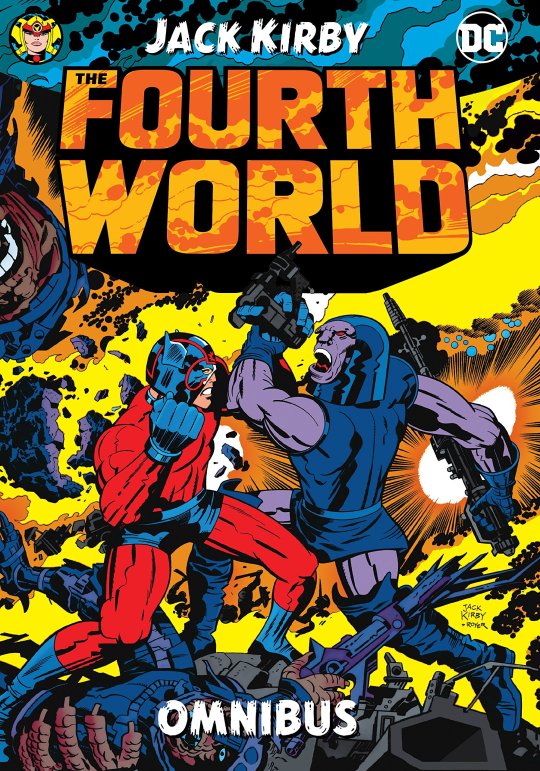
What: On numerous fronts across the cosmos, a secret war rages - with Jimmy Olsen and Superman investigating the Wild Area alongside the Newsboy Legion, with a group of bizarre teenagers landing on Earth, with a mysterious young man taking up the mantle of the fallen world’s greatest escape artist Mister Miracle, and with the mighty space god Orion arriving on our planet with a mission of direst import. For when the Old Gods died their world was torn asunder into the warring planets of New Genesis and Apokolips, and as the ultimate tyrant Darkseid seeks the utter domination offered by the Anti-Life Equation, the New Gods’ gaze turns to the Earth…
Why: The king of comics’ Jack Kirby’s unfinished masterpiece, the Fourth World Saga - soon to be recollected in a single titanic omnibus as several of the concepts make it into the upcoming Justice League - spans from the slums of Metropolis to universe-shattering wars in epochs long since past. It’s a treatise on youth and free will that’s perhaps the most purely ambitious DC publication of all time in its attempt to create a new myth for our times, and one of the only superhero stories to truly deserve the title of epic in the classical sense. I’ve only had a chance to read a fraction of it myself as of yet, but from that fraction it’s clear it not only has the combined brains and energy of nearly any dozen modern comics, but was and remains one of the most powerful testaments to the potential of the genre ever put to paper. And Superman and Jimmy Olsen fight a planet of horror movie monsters in it so evil it grew devil horns, so you really have no excuse not to take the plunge.
Recommendations: The King contributed plenty of concepts to DC such as the Challengers of the Unknown, the Boy Commandos, and an incarnation of Sandman; most promising if you’re sucked into his Fourth World material would be his other 1970s DC books, The Demon (where the immortal Jason Blood’s spirit is caught in an eternal tug-of-war with the dread Etrigan), OMAC (where Buddy Blank is forcibly conscripted to become the One Man Army Corps and stop the threats of tomorrow from becoming wars that would end the world, by way of punching like seven dudes at once), and Kamandi (where the last boy on Earth struggles to survive a post-apocalyptic wasteland where mutated anthropomorphic animals have long since come to reign supreme). The Fourth World itself has been followed up by numerous creators, usually weakly as they attempt to warp the characters to fit more traditional superheroic archetypes; some exceptions that fit with the King’s vision and ambition include several works by Grant Morrison mentioned above and below, (by what I’ve heard of its reputation) Walter Simonson’s Orion, and the current Mister Miracle by Tom King and Mitch Gerads.
12. Books of Magic

What: Twelve-year-old Timothy Hunter is met by the ‘trenchcoat brigade’ of the Phantom Stranger, Mister E, Doctor Occult, and John Constantine, with an unbelievable prophecy: that he has the potential to become the greatest sorcerer of all time. Taken on a tour over twelve issues of the magical side of the DC universe, Tim will ultimately have to decide whether to turn away from his potential destiny and live a normal life, or accept it knowing the horror of the price that always comes with magic.
Why: A small, self-contained story by the pretty dang beloved Neil Gaiman starring an archetype that many should find themselves familiar with (while Hunter preceded him by a few years and both Gaiman and Rowling have denied any inspiration, many have noted his undeniable similarities to Harry Potter), it’s not exactly the meatiest story, but it serves perfectly for its intended purpose as an introduction to the magical side of the DC universe. If you enjoy this - even if you don’t but could imagine the same tone, aesthetics, and general approach yielding interesting results under a different premise or creators - it may well open the doors to an entirely new set of fantastic comics for you.
Recommendations: Books of Magic is a single branch on a mighty tree of magical DCU books inspired by and connected to one another, appropriately beginning with Alan Moore’s transformative run on Swamp Thing, which itself introduced John Constantine who would go on to a great deal of acclaim in his own title Hellblazer. Swamp Thing in turn beget the titanically popular and influential Sandman, which had its own phenomenal spinoff title in the form of Lucifer. Books of Magic continued as well under different creators, and while only now tangentially connected to DC via Tom Strong, Moore and JH Williams III’s book Promethea is brilliant and very much of the same breed.
13. Flash & Green Lantern: The Brave and the Bold

What: In the years leading up to their deaths (and subsequent resurrections, though they weren’t in effect at the time this story was written), Barry Allen and Hal Jordan were friends through thick and thin. Here, from their early days in the JLA to their twilights, these are six stories showing how that friendship changed and endured over the course of their careers.
Why: Two big things come with big superhero universes: histories, and the relationships that come with them. Both can go wrong, whether in the form of purely continuity-driven comics or soap opera titles driven entirely by the old faithful, but when creators handle them properly they’re an essential part of the magic of the shared world, and few comics are better examples of how to do it right than this.
Recommendations: For starters, this mini is itself a sequel of sorts to JLA: Year One, an origin for the team that while no longer their official history is regardless an excellent character-driven Justice League story. For the culmination of preexisting history being used as a tool for great storytelling, you’re in the market for Starman, extrapolating a D-list superhero lineage into a century-spanning family odyssey (and if you enjoy it, you’ll want to check out James Robinson’s book Golden Age, showing the retirement of the Justice Society in what many consider their definitive story). And Brave and the Bold is in many ways the final gasp of an era of phenomenal 80s and 90s character-driven DC titles, including (both from personal experience and shining reputation) the likes of Hitman, Hourman, Justice League International, John Ostrander’s Suicide Squad, and Chase.
14. Seven Soldiers of Victory
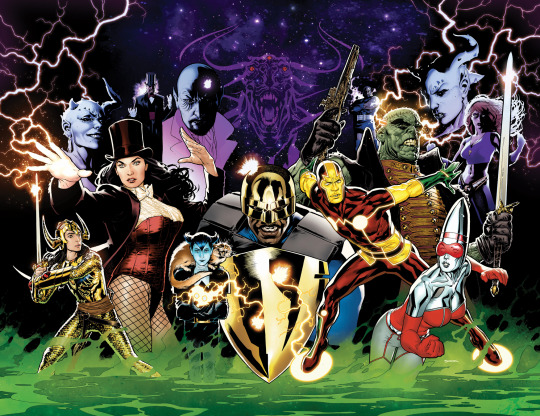
What: A set of seven interconnected miniseries plus bookends, this is the story of seven minor superheroes forced to band together and punch far, far above their weight in the face of a cosmic apocalypse that only they by prophecy can stop. And the catch on top of it? None of them know they’re on a team. Or even meet each other.
Why: Seven Soldiers is a tour-de-force in just about every regard, but even beyond its incredible quality, it just as importantly serves to teach the final, most important lesson of all when it comes to the DCU: there are times it gets buck wild. Superhero worlds are crazy as hell, and to a certain extent you’re going to have to not just accept that on the journey to loving them, but embrace them. And nothing’s going to help you learn that better than a crimefighting newspaper mascot unwittingly working alongside the likes of Frankenstein and the god of escape artists to save the world from evil fairies.
Recommendations: Past the 1970s and truly weird superhero stuff falling out of fashion, Grant Morrison’s the master of this kind of bonkers material - alongside material by him I’ve mentioned before and in the final recommendation, I particularly have to bring up Final Crisis, the event-comic sequel to Seven Soldiers and his JLA that brings his incredible, bizarre vision of the DCU onto the largest scale possible. That itself spins out into the incredible Multiversity, and the aforementioned Scott Snyder/Greg Capullo DC event book (overseen to some extent by Morrison) Dark Nights: Metal; if you want to check out the latter I’d suggest Return of Bruce Wayne, another Morrison-written Final Crisis spinoff that ends up planting some very important seeds even outside the context of his larger Batman run.
15. Flex Mentallo: Man of Muscle Mystery

What: Gifted with the superpower of being able to do anything by flexing his muscles and posing dramatically (with the incredible mental discipline of muscle mystery!), Flex Mentallo was brought to life by a the dying wish of young boy Wally Sage into the real world - albeit a ‘real world’ far stranger than any we might know - but faced with apocalyptic cynicism and a seeming message from an old ally in his fictional days, Flex finds himself on an odyssey to find where all the superheroes have gone and how to save the world the way they used to. Meanwhile, punk rocker Wally Sage is ODing in an alley and babbling away on a suicide hotline about the comics he loved as a child…most of all his own creation, Flex Mentallo.
Why: Grant Morrison’s ultimate statement on superheroes and the potential they hold in our own lives, Flex Mentallo is perhaps the most important comic of all on this list, because while the rest of the recommendations illustrate aspects of the history or genre possibilities or characters that will make you fall in love with the world of DC, Flex is the definitive text on Why This Superhero Comics Shit Actually Matters.
Recommendations: Well, most of Morrison’s other DC work, which I’ve suggested plenty of above alongside his Superman and Batman material in their respective starter packs; the big two I haven’t brought up are his run on Doom Patrol, the headtrip freako comic that introduced Flex in the first place, and Animal Man, his first DC book and alongside Flex his most foundational. If you enjoy Flex you might also be the market for more of DC’s odder Vertigo output meshing the superheroic with the supernatural and horrific; much of its best material was under the Books of Magic entry, and it’s not a field I’m that acquainted with, but I’d also recommend the volumes of Doom Patrol, Shade the Changing Girl, and Eternity Girl under DC’s Young Animal imprint, which carried on the tradition once Vertigo mostly switched to creator-owned work prior to its shutdown.
451 notes
·
View notes
Text
Jon Writes a Year-End List
My favorite songs of 2020, alphabetically by artist
Bedouine (Margo Guryan cover)- The Hum
The original Guryan version is good but Bedouine’s take is cleaner, all the better to emphasize Guryan’s blissful songwriting. I could listen to the chords in the chorus forever.
Bob Dylan- I’ve Made Up My Mind to Give My Heart to You
It’s nice to hear Bob sing a yearning and clear-eyed love song. And the way he stretches out his words gives the whole thing a confidence that’s easy to get lost in.
Boldy James- Giant Slide
Boldy had a great year, and it’s The Price of Tea in China with Alchemist producing that stood out to me.
Empty Country- Becca
I don’t go to music festivals anymore, but listening to this album makes me dream of hearing it live, while being dehydrated, sweaty, feet hurting, holding in a p*op, a late afternoon sunburn loading. I want the whole thing!!
fawning, Rui Gabriel ft. Jack Riley- God
Toss it on the cloudy day walking playlist!
Frances Quinlan- Went to LA
Great cathartic yell in this one. Quinlan builds up a palpable tension here. It rocks.
Judy ft. Jack Dolan, jommis- Say What U Mean
You’ve got to imagine these fellas knew they had put a few catchy melodies down while trying to out-croon each other.
Kurt Vile ft. John Prine (John Prine cover)- How Lucky
A Prine acolyte with a feature from the man himself. RIP.
Lala Lala, Grapetooth- Valentine
Kind of like a slow-dance song at nightmare prom. I love the percussion and Frankel’s villainously-low voice.
Lil Durk- Street Affection
The range of emotions Durk can access and scroll through is impressive.
Miranda Winters- Little Baby Dead Bird
Scuzzy guitar and violin create a hypnotic effect in this evocative dirge. Miranda Winters is such a good singer. Check out her main band, Melkbelly-- they put out a great album this year!
Nap Eyes- Mark Zuckerberg
Two guitars: one is pointy, the other is chugging. That is the correct way to do two guitars.
Noname- Song 33
This song is 70 seconds. 70! Noname casually negates J. Cole and the song isn’t even about him. She’s so great.
Ratboys- I Go Out at Night
Julia Steiner is on her The Hours shit in this melancholic fantasy of leaving and not returning.
Rio da Yung OG, Lil Yachty- 1v1
I like how Yachty comes in on his verse! It’s been fun to see him back in action with his new Michigan friends. Rio is the star here, though. And Enrgy too.
Soccer Mommy- yellow is the color of her eyes
Sophia Allison’s delivery of “The tiny lie I told to myself is making me hollow” might be my line of the year.
Swamp Dogg- Memories
The whole of Sorry You Couldn’t Make It is great, but for Swamp Dogg, who has covered John Prine, to work with the man before he died is a special accomplishment, and we’re better off that it’s recorded.
Tall Juan- Irene
One of my favorite 2020 releases. And I’ll be a bit vulnerable here folks….when I am walking outside and this song comes on, I push my butt out a little bit and walk like I have rhythm and purpose.
Tierra Whack- Dora
I’m so excited to see what Tierra Whack does, from her beat selection to how she jumps between flow and cadence. She understands herself so well.
Non-2020-specific Music I Enjoyed, in Superlative Form
Group Vocal Performance Most Likely to Pierce Your Heartless Facade
Yesu Ka Mkwebaze
Best Song to Listen to if You are an 1850’s-era whaler in Your Feels
Mary Ann
Favorite Duet (Not Blood-Related)
Emmylou Harris and Herb Pedersen (but mostly Emmylou) create such an intricate and gorgeous melody on “If I Could Only Win Your Love”. Pedal steel heads and mandolin freaks, eat up.
Favorite Duet (Blood-related)
The Louvin Brothers- When I Stop Dreaming
Any longtime friends of the show know I’m a big fan of the singing duo The Louvin Brothers. They’ve got that golden country tone but it’s the blood harmony that turns these guys into something else entirely.
And here’s the kicker, folks. Emmylou covered When I Stop Dreaming! How coincidental for all of us reading this End of Year list…. The Louvins are my preferred version, but Emmylou, that you could help me make this connection is enough, dayenu!
Most Surprising Use of a Song in a Network TV Show
"Yama Yama" by the Yamasuki Singers, Fargo Season 2
When I was a dishwasher at St. James Cheese Co., late 2016ish, this CD was in our back of house music rotation. It is a magical album-- a Japanese children's choir with French pop production (think a bunch of bells and shit). I never learned the name of the album while working there and it fell out of my mind until years later when, after remembering how much I loved it, realized I had no idea how to find it. The pain of typing different spellings of “japanese children’s choir” into google for days on end.....I literally yelled when Fargo used this in its Season 2 big boy shootout. *chef’s kiss*
Best Album by a Spiritually Hungry Musical Genius, Lapping Her Contemporaries in Arrangement, Theme, and Songwriting, Gone Before Her Time
Judee Sill’s self-titled debut.
Best Use of a Second Keyboard in A Keyboard Solo
Fountains of Wayne’s Red Dragon Tattoo
Do I mean to say synthesizer? Not sure. RIP Adam Schlesinger and long live FoW. What a loss.
Best Vibes/ Song I’d Most Want to Show Ezra Koenig so That We’d Bond & Become Friends
Zibote
Best Lyrics Written by a Jew in 1920’s NYC Being Sung by Willie Nelson
Lonely rivers flow to the sea, to the sea / to the open arms of the sea
Favorite TV Shows
Ramy
-Second season shook its focus on the titular character and oh am I thankful. Not that Ramy himself isn’t great, he is, but the entire cast here deserves attention. The Uncle Naseem episode. The Uncle Naseem episode. Ahem. The Uncle Naseem episode.
Joe Pera Talks with You
Lovecraft Country
-Small gripes and complicated plotlines aside, this anthology connecting gothic horror, racism, and American history is phenomenal.
Small Axe
-The second installment in this series, Lovers Rock, which takes place at a party, is the vicarious shot in the arm you deserve, you little extroverted thing you.
I May Destroy You
Betty
The Last Dance
-The first Bulls game I ever went to was the first game *without* Michael Jordan, at the beginning of the ‘98-’99 season. Bad timing.
The Chi
Schitt’s Creek
-This show was never about the plot. Am I allowed to say that? I’ve never cared less for a plot and more for a cast. Catherine O’Hara is in her own league above us all.
Jon Writes a Year-End List
In 2019, my roommate June and I took a road trip through the Upper Peninsula of Michigan. I was out of a relationship, happily or unhappily I wasn’t sure yet, but along the way I downloaded Tinder hoping to meet a local who’d be excited to make out with me. There wasn’t much bite on my line, but by the time we reached Marquette, largely due to my good looks and charisma I’d orchestrated some type of group date with June, me, a girl from Tinder, and her friend.
We met at a dingy karaoke bar and drank for cheap. Nobody wanted to hear me sing, but I got on stage anyway and gave “Willin” by Little Feat a go. Some guy at the bar in a maroon work shirt looked at me, scoffed, and left to smoke outside. The four of us weren’t hitting it off, even with alcohol. I and the friend made a plan to sing “Mommas Don’t Let Your Babies Grow up to Be Cowboys'', but she quickly abandoned the duet after we had begun, citing a lack of vibes.
But we kept singing and drinking and hours later I was leaning against the bar, waiting to order, standing next to maroon-shirt guy who had so easily shrugged off my existence earlier. What caught my eye as I stood next to him was a Star of David tattoo on his forearm. And sure enough, the name tag stitched onto his shirt identified him as “Isaac”. Well I’ll goddamn be-- this guy was frickin Jewish! I was shocked-- I assumed he was goy in the same way I assumed everyone I ran into up there would be.
For just one unconscious assumption (I’m the only Jewish person in this Marquette karaoke bar) to be wrong felt great. My assumptions are really awful. I assumed maroon-shirt hated my guts. I assumed these two girls we were drinking with thought I was a loser too. I assume people don’t like me or respect me or have any interest in getting to know me. I tell awful stories about myself to myself, and my assumptions about the world are limiting and boring! With patience, “guy at bar who kinda scowled at me” had all of a sudden turned into “my new friend Isaac” who, after a few minutes of conversation, I “asked to bum a cigarette from.”
One of my favorite shows of 2020 was Joe Pera Talks With You. I still remember watching Joe Pera’s stand-up for the first time, and then rewatching and rewatching, savoring his cadence. He dressed and spoke like a grandpa, replete with pitch-perfect, kinda-gross mouth sounds, stutters, and low-but-driving energy. It’s a good bit, and Joe has morphed it into probably the funniest, sweetest, and least-pandering show of 2020. What I love about this show is its foundational belief that anyone can surprise you, you just need to give yourself time to notice.
I didn’t end up making out with anyone but I did wake up the next morning with the worst hangover of my life. Wake up, barf, whimper. As June drove us out of Marquette, I could barely keep my eyes open. I did notice, however, a massive, wooden structure jutting out into Lake Superior.

It is this same Lake Superior structure that Joe Pera Talks With You fixates on for its first shot of Season 2. Yes, this is an Adult Swim show that takes place in none other than Marquette, Michigan! Which is weird. Think about other movies, shows, or books that take place in the U.P. You can’t! Even zooming out to include the larger Upper-Great Lakes region leaves us with an almost-empty net: The Wreck of the Edmund Fitzgerald by Gordon Lightfoot and titular Gatsby’s origin story on Lake Superior. These are stories of hard living and life and death on the dangerous Great Lakes. But neither of those are specific to the Upper Peninsula.
Regions are an easy if reductive lens with which to attempt to view and understand people. In 2020, broad and sweeping generalizations about large swaths of people continued to gain power. There was the movie adaptation of JD Vance’s ahistorical Hillbilly Elegy. Woolly-eyed liberals trotted out fake maps of a preferred America that holds only the “good” blue states, not at all engaging in the history of racism and voter suppression that got us here. Besides the fact that Georgia went blue. And Democratic strongholds like California, New York, and Chicago betray any notion of a “better” America. The sins of this nation are not cordoned off into one section or time zone, no region is monolithic, and most importantly, no person can be explained away with a quick sentence.
There is no regional monolith more widely misunderstood than the Midwestern gestalt. Fargo (the show) does a great job of serializing this one type of Midwestern character-- they say “oh sure, happy to help” and they’re murderers. So for Joe Pera to settle his show in the U.P. is a fun choice. Most Americans are probably hard-pressed to conjure an accurate mental picture of who the U.P. is, so Pera creates his own flavor of a seemingly-recognizable small Midwestern town.
In the first episode, Joe walks us through the bean arch he’s growing. Why grow snap beans? “Beans are straightforward.” Straightforwardness, or the appearance of, is central to Pera’s charm. Pera’s shtick is walking the audience through a basic task that can serve as a metaphor for a larger existential question. This conceit isn’t new to Pera, but it has been en vogue recently, with shows like Andy Daly’s Review and the new HBO show How To with John Wilson. These shows present a simple stated goal that obfuscates a larger, more complex grapple.
Joe Pera Talks With You is incredible and endearing because of the genuine tone Pera gives his tight-knit Marquette. We’re getting deranged lunatics like Conner O’Malley and Dan Licata to write jokes for 70-year old Michigan grandmas at a salon. The show trades in the perceived Midwestern folksiness for a punchline, yet doesn’t lose itself in irony or resentment.
Every character in the Joe Pera universe has the opportunity to be profound. Pera gives every character the patience they deserve; even O’Malley’s berserk Joe Rogan listening-caricature Mike Melsky gets incredible moments of vulnerability. It’s a rare comedy: self-aware but not self-obsessed, sweet but not gross, and uniquely funny.
Nowhere else on TV are you going to see such consistently great acting. Some of the best working comedians are in this season. Conner O’Malley has found a way to tap into his unsettling grotesque that is a pleasure to watch, playing characters at the ends of their ropes, shrieking. Jo Firestone is hilarious and essential as Joe’s doom-prepper girlfriend Sarah. We get guest stars like genius Carmen Christopher. Even one-line role players like Joe’s teacher-coworker, who says Joe and Sarah go together “like desk and chair,” knock it out of the park.
The questions at the heart of Talks With You feel more pronounced in a year of death and isolation. How do we connect with people? How can we really be there for our loved ones? How can we feel comfortable in our own skin? The show came out pre-pandemic but Pera’s touch and pacing is universal.
It’s difficult not to compare Talks With You to How to with John Wilson. The two shows have a lot in common. Both protagonists are soft-spoken, and speak at an arrhythmic clip. John Wilson’s voice is affected just like Pera’s; both vocal deliveries are meant to engender trust by signaling to us that they’re lacking some social confidence. But I don’t buy Wilson’s shtick as much as Pera’s.
John Wilson’s show is not straightforward in the same way Pera’s is, and the show suffers under the added weight of pretense. Wilson’s tangents lead us to places that barely fit under the established thematic umbrella and feel forced. On memory, Wilson’s adventure with the Mandela Effect turns from fascinating to boring as the truthers devolve into sketch characters, viewing simple spelling errors with magnifying glasses. “How to Cover Your Furniture” spends an upsettingly long amount of time with an anti-circumcision advocate as Wilson works through the question of how much we are allowed to change parts of other people. Meant to appear as if they effortlessly fell into place, these characters feel shoe-horned in.
Both characters and shows are performative authenticity, and Joe Pera and John Wilson’s whole deal is their status as observer. This year, many of us have become observers. I know I have: unemployed, unable to see people, watching death counts climb, sending money to various bail funds and rent relief to people and organizations near and far. There is a responsibility to being an observer. It is not some callous task. Being an effective observer means allowing your subject the space they need to be as they are and not foisting your own nonsense onto them.
In Joe Pera’s America, it’s understood that everyone is weird. By virtue of being human, we are all weird, off, we do confusing things, and say dumb stuff that doesn’t make sense. Even you’re a weird freak. John Wilson’s subjects seem like circus animals, squeezed in front of the camera for their fucked-up little flip. I can’t shake the feeling that John Wilson is making fun of the people he’s observing. Pera’s observations are rooted in the fairness that comes from seeing humanity in people-- every person has an equal chance of surprising you with how weird they are if you just make them comfortable and let them talk. We owe that to each other.
To be fair, these shows are also very different. Wilson’s found-footage, documentary style is ingenious, hilarious, and completely not the vibe that Pera and Co. are going for at all. And region here is everything. Wacky stuff happening in NYC? Eh, isn’t that par for the course over there? Wait, a show set in Michigan’s Upper Peninsula? Ok...now that I’ve never seen.
Obviously I was wrong about Isaac in Marquette, just as any broad assumption about a region and its people will be. I actually learned that Jews have a significant relationship to the U.P. And I found similarities between my own Jewish history, covering a similarly nebulous area of the Rust Belt/Midwest, and my U.P. cousins. Yes, home was closer than I thought, even across the length of Lake Michigan. Yes, people don’t just hate my guts. Yes, we can overcome lazy assumptions and we can even connect with people. We can make a better world. It just requires patience and listening.
Now, on to my thoughts regarding Fiona Apple’s landmark album Fetch the Bolt Cutters...
0 notes
Text
Morning mail: inner-Sydney cluster grows, America's 'red zone', the anti-real estate agent
Good morning, this is Richard Parkin bringing you the main stories and must-reads on Thursday 30 July.
Top stories
Queensland has closed its borders to greater Sydney and halted all visits to aged care facilities for 48 hours as a new Covid-19 cluster forms in Sydney’s inner-east suburb of Potts Point. Victoria has recorded nine deaths and 295 new infections, with the rising tally of active cases linked to aged care facilities requiring clears answers, Gay Alcorn writes. The prime minister’s department has refused to release 1,100 documents relating to the national Covid-19 commission’s discussion of gas projects, amid ongoing allegations of potential conflicts of interest. Legal advice obtained by the Australian Conservation Foundation suggests that national cabinet deliberations may not be exempt from freedom of information requests. And, in bad news for older Australians, the latest payroll job numbers are in, with workers aged 60 and older facing a sharply tightening labour market, writes Greg Jericho.
The US has suffered its deadliest day of summer, with more than 1,300 Covid-19-related deaths taking the national toll to just shy of 150,000. Twenty-one states have entered what the federal government has dubbed “the red zone”, in terms of rising infection numbers. Globally, known cases have doubled in the last six weeks, undermining optimism that pre-pandemic normality is anywhere in sight. For the first time in history, Saudi Arabia has banned Muslims from abroad from entering the country to perform the hajj – an annual event that usually attracts 2.5 million people, with officials allowing between 1,000 and 10,000 locally based pilgrims access to Mecca.
Top executives from Amazon, Google, Facebook and Apple have been grilled by US Congress in a landmark antitrust hearing. The “emperors of the online economy”, including two of the world’s four richest men, Jeff Bezos and Mark Zuckerberg, faced a fierce examination of their business practices, with the panel chair, David Cicilline, saying the four “abuse control over current technologies to extend their power” and use “control over digital infrastructure to surveil other companies”. “Open markets are predicated on the idea that if a company harms people, consumers, workers and business partners will choose another option,” he said. “We are here today because that choice is no longer possible.” Facebook has been under fire for its aggressive monopolistic tendencies and Apple faces accusations of anti-competitive behaviours.
Australia

Aemo’s electricity roadmap outlines a system based on large-scale renewable energy and distributed power sources such as rooftop solar panels supported by multiple ‘dispatchable’ sources. Photograph: Benjamin Egerland/Getty Images/EyeEm
The price of gas-fired power will need to stay very low if it is to compete with a national grid increasingly based on renewable energy, Australia’s peak governing body for the electrical system has warned, with solar panels expected to meet up to nearly a quarter of need by 2040.
A third Aboriginal man has died in Western Australia custody this month, with authorities confirming that a 47-year-old man was discovered unconscious in his cell at Roebourne regional prison, 500km south-west of Broome.
Feral livestock are to blame for a sharp fall in native mammal numbers in the Northern Territory, researchers say. Populations of small and medium-sized animals such as bandicoots and gliders have declined, with cattle, horses, buffalo and donkeys destroying their habitats.
The world
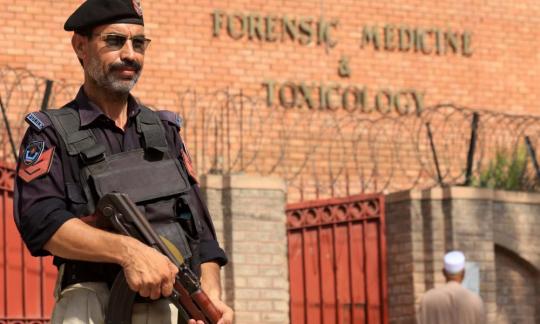
A Pakistani police officer stands guard outside a mortuary where the body of Tahir Ahmad Naseem was taken. Photograph: Bilawal Arbab/EPA
A Pakistani man on trial for blasphemy has been murdered inside a courtroom, with the member of the minority Ahmedi sect shot dead by a lone gunman. A spokesman for the Human Rights Commission of Pakistan said religious fanaticism had become “unbearable”.
German police investigating the Madeleine McCann case have uncovered a cellar on an allotment plot in Hanover owned by the prime suspect in 2007. A garden house on the property was torn down that year. Forensic experts have begun combing the site.
As many as 1,000 babies born to surrogate mothers in Russia for foreign families have been left in limbo, with international border closures preventing would-be parents from entering the country, one of the few countries globally in which paid surrogacy is legal.
Researchers in England have located the likely site from which 50 of the 52 giant sarsen stones at Stonehenge were hewn, a popular dog-walking spot in Wiltshire some 24km north of Salisbury. The 20 tonne, 7m centre stones were moved 4,500 years ago.
Recommended reads

Veteran mechanic Craig Salmon has retrained to work on electric cars and loves it when his regulars make the switch. Photograph: Matthew Netwon/The Guardian
“Car enthusiasts hate them because they run so silent; you can’t get any noise out of them.” But for the veteran motor mechanic Craig Salmon, the list of upsides to electric vehicles far outweighs the negatives, as he tells Royce Kurmelovs – including performance. “The thing no one tells you about electric cars is you get 100% of the torque with zero rpm.” While Australia may have been slow to embrace the worldwide turn to EVs, one company in Tasmania is making affordability its mission. A common fear across the country is that electric cars won’t get you where you want to go. What happens if you run out of charge on a busy highway, or halfway to work? Here’s how the government could easily address these problems.
It’s almost the norm across parts of Europe and North America, but such are the weak rental protections for tenants in Australia, build-to-rent apartments remain rare. In Sydney’s inner west that’s now changing for longtime renters like John McCallister, writes Alyx Gorman. And while on-site rents might be higher, no-surprise leases and 4% capped annual rental rises are just some of the benefits for those looking to eliminate the real estate agent.
There’s something intrinsically cathartic about being in a choir. Linked to improving health and wellbeing, fighting diseases like Alzheimer’s and Parkinson’s, being in a choir fosters near-family like closeness, Ria Andriani explains. But in the coronavirus era, the feasibility of packing dozens of singers together for rehearsal renders this a remote dream, at least until a vaccine is found.
Listen
As Australia eyes its worst economic downturn since the Great Depression, on this episode of Full Story, Greg Jericho speaks with Gabrielle Jackson about where the economy is at and what still lies in store.
Full Story is Guardian Australia’s daily news podcast. Subscribe for free on Apple Podcasts, Spotify or any other podcasting app.
Sport
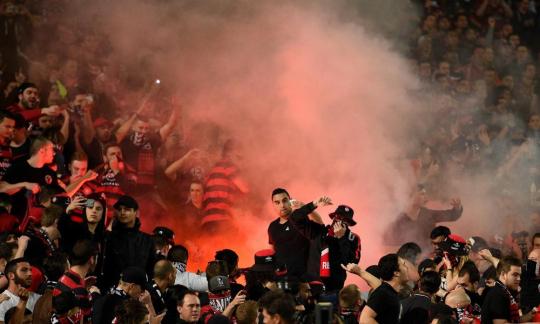
Western Sydney Wanderers looked as though they had cracked the code until a media campaign carpet bombed the entire terrace. Photograph: Dan Himbrechts/AAP
In its 15-year history, the A-League has seen the support for clubs wax and wane but it has never captured the sort of tribalism the old NSL engendered, writes Simon Hill. And while success acts as a fillip, a sense of belonging is much harder to sustain.
After nearly five months of inaction Andy Murray believes upsets could be the new norm, likening the enforced break to world tennis to a long injury layoff. And the Scot has called for more mixed-gender events.
Media roundup
Australian workers will withdraw nearly $42bn from retirement savings, reports the Australian, with the figure nearly double forecasts, fuelling concerns the government is undermining long-term planning for short-term solutions. The AFL clubs Richmond and Carlton are facing hefty fines, the Age reveals, after reports a player left the hub to attend a beauty salon, and another’s young children were taken to Sea World before returning to lockdown. And Australian astronomers have discovered a group of ancient stars considered “the building blocks of our galaxy”, posing major new questions about the evolution of the Milky Way, reports the ABC.
And if you’ve read this far …
What’s in an apostrophe? Well, if you’re Donald Trump Jr, quite a bit. Having copped heavy flak for a grammatical error in the subtitle of his forthcoming self-published book, the president’s son has been digging downwards on Twitter: “Sleepy Joe wont like this one. But lets be honest he probably doesn’t keep up with current events.” And his promotional website doesn’t do much better, promising the book will uncover “countless liberal scandals, years of entrenched racism in the democrat party and decades of failed polices”.
Sign up
If you would like to receive the Guardian Australia morning mail to your email inbox every weekday, sign up here.
Go to the article
0 notes
Text
TITLELESS: 16 overachieving NBA teams who fell short of a title

Russell Westbrook and Kevin Durant never won a title on the Thunder.
Some great non-champion NBA teams weren’t supposed to be great teams until they showed off in the playoffs. Here are 16 near-miss playoff runs defined by outperforming their talent, seed, or both.
Some great non-champion NBA teams weren’t supposed to be great teams until they showed off in the playoffs. Here are 16 near-miss playoff runs defined by outperforming their talent, seed, or both. Meet the Overachiever Division.
We begin with the ultimate NBA Finals Cinderella and end with a more recent contender that broke up in the summer, though not by choice.
16. 1975-76 Phoenix Suns
ERA: John MacLeod’s Suns
RECORD: 42-40
POINT DIFFERENTIAL: +0.6
PLAYOFF RESULT: Lost in Finals to Boston Celtics (4-2)
KEY STAR(S): Paul Westphal
COACH: John MacLeod
OTHER KEY PLAYERS: Alvan Adams, Gar Heart, Dick Van Arsdale, Curtis Perry, Ricky Sobers, Keith Erickson, John Shumate
OTHERS CONSIDERED FROM THIS ERA: 1977-78, 1978-79, 1979-80, 1980-81, 1982-83
The most unlikely Finals participant in NBA history was this close to pulling off an improbable championship. After winning Game 7 on the home floor of the defending champion Warriors in the conference Finals, Phoenix split the first four games with a Celtics team that didn’t take them seriously.
That brings us to Game 5, often referred to as the greatest game in NBA history. Boston won in triple overtime and took the Finals in Game 6, but some truly wild shit happened in that game. Boston took a 20-point first-quarter lead, but the Suns chipped away. Led by Paul Westphal, who was traded by the Celtics for Charlie Scott in one of those now-for-future moves that benefitted both teams, the Suns came back from nine down in the final three minutes to force overtime.
With the score tied at 101 and three seconds left in the first overtime, Boston veteran Paul Silas grabbed a rebound and visibly signaled to call timeout despite Boston having none left. It should have resulted in a technical foul and a free throw. But referee Richie Powers ignored Silas’ request, allowing the game to go to double overtime.
Powers later admitted he “did not want Boston to lose like that,” according to Bob Ryan’s book Scribe: My Life in Sports. (Probably not coincidentally, then-Celtics coach Tommy Heinsohn called Powers “my favorite referee” in a 2016 Boston Globe interview). Years later, even Silas admitted he called timeout and Powers “didn’t see me or didn’t want to see me.”
The Suns then scored four straight points at the end of double overtime to take a one-point lead with four seconds left. Boston inbounded to ageless legend John Havlicek, who was playing through a torn plantar fascia. He banked what appeared to be the game-winner off the glass and in. As Celtics fans stormed the court and the players rushed to the locker room, Powers, perhaps in an attempt to atone for his previous mistake, ruled there was still one second left in the game. (An angry Celtics fan apparently tackled and pinned Powers to the floor during the ensuing melee. Imagine if that happened today.)
But wait, there’s more! Westphal knew of a loophole in the league’s technical foul rules and exploited it for Phoenix’s benefit. He called timeout, knowing Phoenix had none left and would receive a technical foul. (Funny how Powers saw this one, but not Silas’ unintentional gaffe).
Boston hit the free throw to lead by two, but Phoenix retained the ball and actually got to inbound it at half court. The Suns threw it to Gar Heard, who turned and nailed a 20-foot jumper to force triple overtime.
Relive all of that here. It’s WILD.
youtube
The Suns finally fell short in the third overtime when little-used Boston reserve Glenn McDonald ran circles around their dead legs. They stayed in the mix for the next half decade, but never came that close again.
15. 2013-14 Portland Trail Blazers
ERA: Dame Time
RECORD: 54-28
POINT DIFFERENTIAL: +3.9
PLAYOFF RESULT: Lost in second round to San Antonio Spurs (4-1)
KEY STAR(S): Damian Lillard, LaMarcus Aldridge
COACH: Terry Stotts
OTHER KEY PLAYERS: Nicolas Batum, Wesley Matthews, Robin Lopez, Mo Williams, Dorell Wright, C.J. McCollum
OTHERS CONSIDERED FROM THIS ERA: 2014-15, 2018-19
Like the early-2010s Pacers, these Blazers hit their peak in the middle of the following season. Portland’s well-balanced starting lineup was in the thick of the West title race by the middle of the 2014-15 year, but lost all momentum when Wesley Matthews, the team’s heartbeat, tore his Achilles.
youtube
The Blazers fell apart thereafter and chose to break up the team the following summer after LaMarcus Aldridge signed with the Spurs.
14. 2001-02 Boston Celtics
ERA: Pierce and ‘Toine
RECORD: 49-33
POINT DIFFERENTIAL: +2.3
PLAYOFF RESULT: Lost in East Finals to New Jersey Nets (4-2)
KEY STAR(S): Paul Pierce, Antoine Walker
COACH: Jim O’Brien
OTHER KEY PLAYERS: Kenny Anderson, Tony Battie, Eric Williams, Tony Delk, Rodney Rodgers, Erick Strickland, Vitaly Potapenko, Walter McCarty
OTHERS CONSIDERED FROM THIS ERA: None
What a strange team. After taking over for Rick Pitino late in the previous season, coach Jim O’Brien fashioned a wacky style of play that encouraged players to shoot tons of threes even if they weren’t especially good at them. Antoine Walker took a whopping 645 attempts while making just 34 percent. Nowadays, that’s less weird. Back then, it was wild. But it all somehow worked because Paul Pierce was incredible and Walker’s versatility eased the burden on the rest of the team.
Nobody took these Celtics seriously, which nearly worked to their advantage after they staged a memorable 26-point comeback to take a 2-1 series lead over the Nets in the East Finals.
youtube
But the Nets won the next three games, including two in Boston, to earn the right to be the Lakers’ sacrificial lamb. Boston faltered the next few seasons and nearly traded Pierce, but got bailed out when Timberwolves general manager and Celtics legend Kevin McHale relented on trading Kevin Garnett to Boston.
(Celtics Blog did a wonderful tribute to the 2001-02 team that’s well worth your time).
13. 2012-13 Memphis Grizzlies
ERA: Grit ‘N Grind
RECORD: 56-26
POINT DIFFERENTIAL: +4.1
PLAYOFF RESULT: Lost in West Finals to San Antonio Spurs (4-0)
KEY STAR(S): Zach Randolph
COACH: Lionel Hollins
OTHER KEY PLAYERS: Marc Gasol, Mike Conley, Tony Allen, Tayshaun Prince, Jerryd Bayless, Quincy Pondexter, Wayne Ellington, Ed Davis, Darrell Arthur
OTHERS CONSIDERED FROM THIS ERA: 2010-11, 2014-15
I won’t argue if you’d rather include Dave Joerger’s 2014-15 Grit ‘N Grind team that took a 2-1 lead on the eventual champion Golden State Warriors in the second round. That team briefly appeared to solve its longtime shooting problem before the Warriors unveiled their Andrew Bogut-on-Tony-Allen defense. (Grizzly Bear Blues, SB Nation’s Grizzlies community, would also take the 2014-15 club)
But I chose the 2012-13 team that reached the conference finals despite (or because of?) trading Rudy Gay in midseason in a money-saving move that angered coach Lionel Hollins. Marc Gasol was at the peak of his defensive powers, Zach Randolph was still a force, and Quincy Pondexter looked like the 3-and-D wing that could have completed the Grizzlies’ core.
12. 2012-13 Golden State Warriors
ERA: Pre-Kerr Steph
RECORD: 47-35
POINT DIFFERENTIAL: +0.9
PLAYOFF RESULT: Lost in second round to San Antonio Spurs (4-2)
KEY STAR(S): Stephen Curry
COACH: Mark Jackson
OTHER KEY PLAYERS: David Lee, Klay Thompson, Harrison Barnes, Andrew Bogut, Jarrett Jack, Carl Landry, Festus Ezeli, Draymond Green
OTHERS CONSIDERED FROM THIS ERA: 13-14
No Overachievers Division is complete without a Stephen Curry Cinderella team. The 2012-13 team was decent, but didn’t take off until Curry went en fuego in the playoffs. (David Lee’s injury, which forced Mark Jackson to go small, also helped.)
youtube
The cagey Spurs ended the Warriors’ run, but Curry lit them up twice on the road in the first two games before re-injuring his ankle in Game 3. That limited him the rest of the series and made the Warriors’ Game 1 collapse that ended with horrible, botched coverage on a game-winning Manu Ginobili three loom larger.
youtube
The decision to pick the 12-13 team instead of the 51-win outfit the next year was an easy one considering the dysfunction surrounding Jackson’s final season in charge.
11. 1989-90 Phoenix Suns
ERA: Pre-Barkley Suns
RECORD: 54-28
POINT DIFFERENTIAL: +7.1
PLAYOFF RESULT: Lost in West Finals to Portland Trail Blazers (4-2)
KEY STAR(S): Kevin Johnson
COACH: Cotton Fitzsimmons
OTHER KEY PLAYERS: Tom Chambers, Jeff Hornacek, Dan Majerle, Mark West, Eddie Johnson, Kurt Rambis, Andrew Lang
OTHER SEASONS CONSIDERED FROM THIS ERA: 1988-89, 1990-91, 1991-92
The pre-Charles Barkley Suns were a wonderful story and might have been even better than their more well-known counterparts. After an embarrassing drug scandal rocked the team in 1987, new owner Jerry Colangelo held a fire sale. The most controversial move was trading Larry Nance, the team’s best player and a model citizen who wasn’t involved in the scandal, for a package that included little-used big man Mark West, a future first-round pick that turned into a Central Michigan guard named Dan Majerle, and a backup point guard named Kevin Johnson who was stuck behind young all-star Mark Price.
The turnaround was swift. Johnson turned out to be a superstar, teaming with the undrafted Jeff Hornacek to form the “KJ and Horny” backcourt. (Great name.) Along with marquee free agent signing Tom Chambers, the Suns stormed into the West’s elite. They ended the Lakers’ dynasty with a stunning 4-1 win in the West semifinals, with Johnson blowing by Byron Scott repeatedly and Hornacek making Magic Johnson pay for his defensive roaming. After winning the decisive fifth game in LA, Kevin Johnson declared his desire to make the Suns the “team of the 90s.”
youtube
But that didn’t happen. Phoenix blew it in a six-game conference finals loss to Portland, coughing up fourth-quarter leads in the first two games in Portland and blowing a six-point advantage in the final few minutes of a Game 6 defeat. Johnson missed the second half of that decisive loss with one of the many nagging injuries that defined the rest of his career.
By the time Barkley arrived in 1992, Johnson was a more muted version of himself and Chambers was nearing his last legs. Barkley and Johnson never fit seamlessly, and the Suns never quite got the most out of their on-paper talent. What might’ve happened if Barkley arrived in 1989 instead of 1992? We’ll never know.
10. 2007-08 New Orleans Hornets
ERA: Young CP3
RECORD: 56-26
POINT DIFFERENTIAL: +5.3
PLAYOFF RESULT: Lost in West semifinals to San Antonio Spurs (4-3)
KEY STAR(S): Chris Paul
COACH: Byron Scott
OTHER KEY PLAYERS: David West, Tyson Chandler, Peja Stojakovic, Morris Peterson, Bobby Jackson, Bonzi Well, Jannero Pargo, Rasual Butler
OTHERS CONSIDERED FROM THIS ERA: None
Another long-forgotten cult classic I loved during my college days. Chris Paul was robbed of the MVP because the collective media decided to give Kobe Bryant a lifetime achievement award. Yeah, I said it. Those Paul/Tyson Chandler lobs were things of beauty. I’m still mad at Jannero Pargo for shooting the Hornets out of that Game 7 against the Spurs. They would have put up a better fight against the Lakers in the next round.
youtube
That was the only real moment of glory for Paul in New Orleans.
9. 2002-03 New Jersey Nets
ERA: Kidd’s Nets
RECORD: 49-33
POINT DIFFERENTIAL: +5.3
PLAYOFF RESULT: Lost in Finals to San Antonio Spurs (4-2)
KEY STAR(S): Jason Kidd
COACH: Byron Scott
OTHER KEY PLAYERS: Kenyon Martin, Richard Jefferson, Kerry Kittles, Dikembe Mutombo, Jason Collins, Lucious Harris, Rodney Rodgers, Aaron Williams
OTHERS CONSIDERED FROM THIS ERA: 2001-02, 2003-04
The 2001-02 Nets had the novelty factor and won more games, but the 2002-03 version was much stronger. The big offseason trade of Keith Van Horn for Dikembe Mutombo was a bit of a flop, but it did allow second-year forward Richard Jefferson to step into Van Horn’s spot and emerge as an all-star talent. New Jersey had the mighty Spurs on the ropes in the Finals, but they blew Game 5 at home and succumbed to Tim Duncan’s near-quadruple-double in Game 6.
It all fell apart from there.
8. 2014-15 Atlanta Hawks
ERA: Bud’s Hawks
RECORD: 60-22
POINT DIFFERENTIAL: +5.4
PLAYOFF RESULT: Lost in East Finals to Cleveland Cavaliers (4-0)
KEY STAR(S): None
COACH: Mike Budenholzer
OTHER KEY PLAYERS: Al Horford, Paul Millsap, Kyle Korver, Jeff Teague, DeMarre Carroll, Dennis Schroder, Thabo Sefolosha, Kent Bazemore, Pero Antic, Mike Scott
OTHER SEASONS CONSIDERED FROM THIS ERA: None
I loved this team. They had five quality players whose talents blended perfectly, all working together to create one of the prettiest offenses of the modern era. Their regular-season win over the eventual champion Warriors in Atlanta is still one of the highest-skill basketball games I’ve ever seen.
youtube
But deep down, we all knew they didn’t have enough to win a title or maintain their flash of success. They were wobbling before LeBron James and the Cavaliers unceremoniously finished them off in the conference finals.
Still would’ve been nice if Kyle Korver and DeMarre Carroll were fully healthy and the NYPD didn’t break Thabo Sefolosha’s leg.
7. 1963-64 Cincinnati Royals
ERA: Prime Oscar Robertson
RECORD: 55-25
POINT DIFFERENTIAL: +5
PLAYOFF RESULT: Lost in East Finals to Boston Celtics (4-1)
KEY STAR(S): Oscar Robertson
COACH: Jack McMahon
OTHER KEY PLAYERS: Jerry Lucas, Wayne Embry, Jack Twyman, Tom Hawkins, Bucky Bockhorn, Adrian Smith, Bob Boozer
OTHERS CONSIDERED FROM THIS ERA: 1962-63, 1964-65
This was Oscar Robertson’s best team during his heyday, though it wasn’t the team that got closest to the Finals or the one that featured Robertson’s famous triple-double season. It was the year Oscar won league MVP, earning the crown in a landslide over Wilt Chamberlain and Bill Russell.
youtube
But Oscar had nothing left by the time the East Finals with Boston began, and he was locked up by the combination of K.C. Jones on ball and Russell on the backside.
6. 2012-13 Indiana Pacers
ERA: Paul George and Frank Vogel
RECORD: 49-32
POINT DIFFERENTIAL: +4
PLAYOFF RESULT: Lost in East Finals to Miami Heat (4-3)
KEY STAR(S): Paul George
COACH: Frank Vogel
OTHER KEY PLAYERS: Roy Hibbert, David West, Lance Stephenson, George Hill, Gerald Green, Ian Mahinmi, Tyler Hansbrough, Sam Young, D.J. Augustin
OTHERS CONSIDERED FROM THIS ERA: 2013-14
These Pacers were an NBA powerhouse for a calendar year that took place over two NBA seasons. During the second half of 2012-13, Paul George emerged from the injured Danny Granger’s shadow to push the Heatles to the brink. (I’ll defend the decision to bench Roy Hibbert at the end of Game 1 until the end of time). Then, the Pacers built one of the game’s stingiest defenses and went 33-7 during the first half of the 2013-14 season. Let’s not speak of what happened thereafter.
So pay no attention to the Pacers’ mediocre 2012-13 full season record. They’re ranked this high because of their play from January 2013 to January 2014.
5. 2000-01 Philadelphia 76ers
ERA: Iverson
RECORD: 56-26
POINT DIFFERENTIAL: +5.7
PLAYOFF RESULT: Lost in Finals to Los Angeles Lakers (4-1. Stepover game)
KEY STAR(S): Allen Iverson
COACH: Larry Brown
OTHER KEY PLAYERS: Dikembe Mutombo, Eric Snow, George Lynch, Tyrone Hill, Aaron McKie, Matt Geiger, Kevin Ollie, Raja Bell
OTHER SEASONS CONSIDERED FROM THIS ERA: None
These 76ers are iconic because of one small man and one memorable stepover after a made shot. They were — or rather, Allen Iverson was — David going up against a Goliath in the apex Shaquille O’Neal-Kobe Bryant Lakers. Every NBC promo highlighted that theme.
But the story of the 2000-01 76ers is more complex, as SB Nation’s Rewinder series beautifully illustrates.
To wit:
Iverson was nearly traded to the Pistons before the season in a massive four-team deal. The trade, which was agreed upon by all parties, would’ve sent Eddie Jones, Glen Rice, an ancient Dale Ellis, and Jerome Williams to Philly. Yuck. Iverson was told the trade was happening. But it fell apart because backup center Matt Geiger refused to waive his 15 percent trade kicker, which he needed to do to make the salaries make up.
Dikembe Mutombo wasn’t the midseason acquisition that pushed the 76ers over the top, as you might expect given his name recognition. It’s more accurate to say he was an emergency replacement acquired by necessity. Philly was 36-13 at the NBA All-Star Game break thanks to Iverson and shot-blocking dynamo Theo Ratliff, who rode a career season to an all-star nod. But Ratliff broke his wrist in the final game before the break, jeopardizing Philly’s run. Rather than wait things out, the 76ers made him the centerpiece of a trade with the Hawks for the disgruntled Mutombo, with Toni Kukoc also heading to Atlanta. After that 36-13 start, Philly went just 20-13 down the stretch and had to endure two Game 7s before reaching the Finals.
Ask a Bucks fan about the officiating in that 2001 conference finals. Just do it.
The 76ers’ victory was still an amazing feat considering their injury situation. Starting small forward George Lynch broke his foot in the second round and didn’t play again. Point guard Eric Snow fractured his foot in the next round and played through it. Sixth Man of the Year Aaron McKie broke his foot in Game 1 of the Finals and played through it, too. Also, Mutombo was playing through a broken finger. I’m surprised those dudes could even walk.
4. 2008-09 Orlando Magic
ERA: Dwight and Stan
RECORD: 59-23
POINT DIFFERENTIAL: +6.6
PLAYOFF RESULT: Lost in Finals to Los Angeles Lakers (4-1)
KEY STAR(S): Dwight Howard
COACH: Stan Van Gundy
OTHER KEY PLAYERS: Rashard Lewis, Hedo Turkoglu, Jameer Nelson, Rafer Alston, Courney Lee, Keith Bogans, Mickael Pietrus, J.J. Redick, Marcin Gortat, Anthony Johnson
OTHER SEASONS CONSIDERED FROM THIS ERA: 2009-10
The story of the NBA’s three-point revolution isn’t complete without mentioning the Stan Van Gundy-Dwight Howard Magic. Desperate for answers after starting power forward Tony Battie got injured in the 2007 preseason, Van Gundy made the bold decision to slide marquee free agent acquisition Rashard Lewis up to power forward to make room for the enigmatic Hedo Turkoglu. With Lewis spacing the floor for Howard, Turkoglu, and Jameer Nelson, Orlando spent the next three seasons shattering three-point records while maintaining one of the league’s best defenses.
The 2009-10 version, with Vince Carter instead of Turkoglu, was stronger in the regular season and favored in the East Finals after LeBron James’ Cavaliers lost to the Celtics. But I prefer the 2008-09 version because it advanced further in the playoffs, scored the most impressive series victory of the era over a better LeBron team, and had two giant “what if” moments — Nelson’s midseason injury and Courtney Lee’s blown layup that would’ve won Game 2 of the Finals against the Lakers — that could have made them champions.
youtube
3. 1997-98 Los Angeles Lakers
ERA: Shaq, Pre-Phil
RECORD: 61-21
POINT DIFFERENTIAL: +7.7
PLAYOFF RESULT: Lost in West Finals to Utah Jazz (4-0)
KEY STAR(S): Shaquille O’Neal
COACH: Del Harris
OTHER KEY PLAYERS: Eddie Jones, Nick Van Exel, Rick Fox, Kobe Bryant, Robert Horry, Elden Campbell, Derek Fisher
OTHER SEASONS CONSIDERED FROM THIS ERA: 96-97
I wasn’t sure where to put the pre-Phil Jackson Lakers in this tournament. Maybe it’s a stretch to call them “overachievers” considering they were one of the preseason favorites, won 61 games with a ton of talent, and got schooled by the veteran Jazz in four straight games in the conference Finals. By that logic, they belong in the flameout region. (Speaking of flameouts, hoo boy the Nick Van Exel-Del Harris relationship was ugly by this point.)
youtube
Here’s my case for them belonging as overachievers:
They went 61-21 despite Shaquille O’Neal missing 22 games early in the year. In fact, they were destroying everyone before that untimely injury and never got a chance to return to that level.
Van Exel’s ongoing feud with Harris, combined with a midseason injury, forced the Lakers to rely on a little-known second-year guard out of Arkansas Little-Rock named Derek Fisher to run the point.
Kobe Bryant wasn’t Kobe Bryant yet. He made the All-Star team due to his popularity, but was still a moderately efficient sixth man that played behind Eddie Jones.
The Lakers were not favored in their second-round series with a resurgent Sonics team that had swapped the disgruntled Shawn Kemp for the in-shape (at the time) Vin Baker. Yet after Seattle won the first game at home, the Lakers crushed them in the next four, winning each by double-digits. It was a stunning display at the time.
In hindsight, that 97-98 Jazz team was a couple plays away from winning the title. Was it really a huge shame to lose to them?
The worst of the pre-Jackson Lakers drama occurred the following season after the lockout. Van Exel got traded, Jones was moved for Glen Rice, Harris lost his job, and the bizarre Dennis Rodman experience threw everything off. That’s the season they really underachieved. I’m not sure the 97-98 edition qualifies.
Thus, they’re here.
2. 1981-82 Philadelphia 76ers
ERA: Dr. J, pre-Moses
RECORD: 58-24
POINT DIFFERENTIAL: +5.7
PLAYOFF RESULT: Lost in NBA Finals to Los Angeles Lakers (4-2)
KEY STAR(S): Julius Erving
COACH: Billy Cunningham
OTHER KEY PLAYERS: Maurice Cheeks, Andrew Toney, Caldwell Jones, Lionel Hollins, Bobby Jones, Darryl Dawkins, Steve Mix, Mike Bantom
OTHER SEASONS CONSIDERED FROM THIS ERA: 1976-77, 1977-78, 1979-80, 1980-81
Julius Erving did win one title with the 76ers, but that was only after getting MVP Moses Malone as a running mate in the summer of 1982. Based on the rules of this game, all of Dr. J’s Philly clubs prior to then are eligible for this tournament.
The 1976-77 club had the most star power and the 1980-81 version had the best regular season, but we’re going with the 1981-82 edition because they were the ones to slay the Boston Garden dragon. Andrew Toney really was a forgotten legend.
youtube
That was the game the legendary “BEAT LA” chant was born. Alas, the 76ers did not heed the call of their strange bedfellows in Boston. They got blown out at home in Game 1 and fell to the Lakers in six games.
1. 2015-16 Oklahoma City Thunder
ERA: Post-James Harden trade
RECORD: 55-27
POINT DIFFERENTIAL: +7.3
PLAYOFF RESULT: Lost in West Finals to No. 1 Golden State Warriors (4-3)
KEY STAR(S): Kevin Durant, Russell Westbrook
COACH: Billy Donovan
OTHER KEY PLAYERS: Serge Ibaka, Steven Adams, Andre Roberson, Dion Waiters, Enes Kanter, Randy Foye, Kyle Singler
OTHER SEASONS CONSIDERED FROM THIS ERA: 2012-13, 2013-14
This was the worst regular-season team of the post-James Harden, pre-My Next Chapter Thunder, but the most terrifying at full power. After sleepwalking through the regular season under new coach Billy Donovan, the Thunder beat a 67-win Spurs team in the second round and made the 73-win Warriors look like a junior varsity team during the first four games of the next round. They then lost Game 5, got blitzed by an unconscious Klay Thompson in a thrilling Game 6, and lost in Game 7 after Stephen Curry rediscovered his form.
youtube
That series was the start of a budding Western Conference rivalry featuring two of the greatest of this era and tons of other … ah, nevermind.
0 notes
Photo

a change of results
Retrospection is such a human trait, and it seems to come to the fore in sports. Match reports are actually pointless, if you think about it; what for review something that’s already happened and will never happen again? Greatest XIs, players you’d have liked to play with – all these are things that you would have liked to have had but never will. And so this question begs that kind of answer: fantastical, self-indulgent, and nothing more than a wish, a dream.
The go-to result I say when I think of this question is the Champions’ League final of 2009. I remember reading the papers the morning after and being bitterly disappointed. My dad, from the doorway, said, “that was way too easy,” and I said, “but still.” If we’d won that not only would we have been one shy of Liverpool’s record, we would also have been the first team in the modern era to have won it back to back, Madrid be damned.
There are other candidates in this vein, of course. Reversing the 6-1 defeat against City that would have left us with the league; some result in the 94/95 season for similar result; any one of the FA Cup finals we’ve lost; the 1996 semi-final against Germany for England. Any of these are easy to explain. But the real result I settle on, regardless of trophies and glory and everything that’s shiny in our lives, is different from that. Instead of wanting us to win a game, I want us to have lost.
Let me take you back almost sixty years, now. There’s a bunch of fellows dressed in natty suits waiting in a German airport. I assume all their ties were red. They’ve had two false starts, because it’s snowing heavily outside, but they’re optimistic about this third time being their last. They board the plane. They’re chatting, talking about cards and home and football, of course. They’re into the semi-finals of the European Cup – who wouldn’t be cheerful?
You know what comes next. Everyone does. I cried once in the National Football Museum and that was at the telegram Duncan Edwards sent to his landlady – ‘all fights cancelled. Flying tomorrow. Duncan.’ There’s this one picture in the Guardian from the 7th of February, 1958, dull and dark, the sheen of the moon or some kind of light reflecting dimly on the pavement. Hundreds, thousands of people are lined along the road. They’re all waiting for something. You can’t make out their faces but some have their heads bowed, some have their hands clasped. On the back of the photograph it says – Old Trafford at midnight, crowds waiting for cortege of coffins of Manchester Utd.
I don’t suppose I can adequately explain the collective grief that a football club experiences when something like this happens. It happened to Chapecoense and the world mourned with them, as they should have, but when you are a fan of that club tragedy is a completely different thing. To understand this you must understand how fans relate to football. I know that we’re fond of saying ‘it isn’t just a game’, but there isn’t any other way to put it. It’s not just a game, pure and simple. It becomes a part of your life; it is that which defines you and that with which you define yourself. When you become a fan of a club you’re buying into a common identity, a culture, a different society. And tragedy affects all of these things. As a Singaporean I’m still affected by the Japanese Occupation even though I hadn’t even been born, because it is a defining moment in our history that shapes it. So too for tragedy in football, and especially when it happens to the team.
Because the team represents the club, represents its values, represents – as it were – your soul; and the Busby Babes were United. Strong and brave and bright and young. I was reading Arthur Hopcraft’s The Football Man recently and he says that Munich is different from other disasters, like Milan’s, because Edwards and the rest represented the beginning of what could have been a future. It is their unfulfilled, unknown potential that hurts the most. They were already through to the semi-finals – they could have been the first ever English team to lift the trophy. They were already league title winners. They were midway through the FA Cup (and, incidentally, still reached the final that year). Their names could have gone down in history as champions, winners, legends; not sad ghosts so cruelly snatched away, with nothing more than black and white photographs and a memorial every year.
You might think me mechanical for reducing the tragedy to mere trophies. I’m aware that winning isn’t everything, but football is everything, and in football the narrative goes with the most dizzying of wins, the jaw-dropping last minute victories (snatched preferably from reviled opponents). This is not to define their lives in terms of winning – they had families, wives, children, mothers and fathers – but to explain why their loss is felt so keenly. They gave people something to believe in, and taking away a team is like taking away hope. They are your father, brother, son. And you feel the loss just as keenly. Danny Boyle in the Class of ‘92 mentions how the last photograph of the Busby Babes was the biggest photograph in his family album. Eric Harrison says that he was pulled out of class to be told the news, like when a relative passes. In The Football Man, Hopcraft on visiting Dudley (Edwards’ hometown) related this anecdote told by Edwards’ father: lorry drivers with Manchester accents, stopping on the long run home from somewhere south to visit Duncan’s grave.
Sir Alex Ferguson was fond of saying that a club is like a family. When something happens everyone, regardless of how far away they are, feels it. This doesn’t just ripple through support at the time; it ripples through time itself, because of how human it is. At the end of the day eight boys died. The oldest was twenty-eight. Big Duncan was twenty-three. Hopcraft writes about the grief of Edwards’ parents, the way they kept all his medals and England caps and United shirts in his room. In the Dudley Cathedral there is a stained glass window featuring him in his United kit kicking a ball. Football is about remembering. About telling stories. About not forgetting what came before, be it a treble or a tragedy.
The more cynical people in the world have accused Manchester United of turning Munich into a publicity stunt, a circus fest of memorials and pointless sentiment; all right, perhaps there are those who would do that, but I’ve no doubt that any true United fan understands the gravity of the occasion, and behind the so-called memory industry there is a swelling of feeling that manifests itself in the spontaneity of people who gather in the Munich tunnel quiet and solemn. Class of ’92 highlights the comparisons between the Busby Babes and Fergie’s Fledglings, and about the shadow of Munich that settled over the club always. Duncan Hamilton, in his book about George Best, wrote about the 1968 European Cup semi-final against Real Madrid. Bill Foulkes, a Munich survivor, scored the winner, and ‘turns towards his own half, slightly spreading his arms and softly clenching together the fingers of both hands. His face is almost stony.’ Hamilton delves into hyperbole and imagination here, but you can’t help agreeing with him when he posits that one image must have been ‘whirling through [Foulkes’s] mind then. Of men who would never age, would never go grey and would always wear United Red.’
Tragedy has moulded us as a club, for better or for worse. To accuse Munich of being manufactured would be to accuse us of lacking a soul. Yet some stories are better left untold. I know that Munich has added to the club mythology and sense of self and our way of being, but all the same I wish that there was a less awful way of doing this than having to know that twenty-three people died. How much better would it have been for our story, our spirit to have been written in the silver engravings on the bottom of trophies than the stone embossing on shrines. How much more important should the names on that empty lineup against Sheffield Wednesday be filled, that twenty-three families, and United itself, could have gone on.
Which is why the game I would change, even though I know I will never be able to, is a game in the European Cup run of Manchester United in 1957/58. Perhaps instead of winning 3-0 against Dukla Prague on the 20th of November, Pegg and Taylor amongst the scorers, we could have lost 3-0 instead. The next leg was lost 1-0 at home, and we would never have made it through to play Red Star Belgrade. Never stopped at Munich to board a plane. They would have come home from Prague awfully disappointed, their spirits down, a bitter taste in their mouths, faced with insurmountable odds. But they would have come home.
Mark Jones – Roger Byrne – Geoff Bent – David Pegg – Eddie Colman – Bill Whelan – Tommy Taylor
15 notes
·
View notes
Text
Book Review | “Toppling Qaddafi: Libya & the Limits of Liberal Intervention”, Christopher S. Chivvis.
The heightened multi-polarity of the modern world especially in the international realm, hinges on the slowly waning [read: withdrawing] supremacy of the American hierarchy. That hierarchy is determined in small part by the United States’ foreign and extractive economic policies, but largely reflected in its indiscriminate and constant use of coercive power.
However, Chivvis, the Associate Director of the International Security and Defense Policy Center (RAND Corporation), through his book - “Toppling Qaddafi”, hopes to present a new vision of that coercive power - one that is inclusive and decisively unassertive. Written as a response to his contemporaries’ skepticism about interventions, particularly American-led ones, “Toppling Qaddafi”, is a narrative text that outlines the geopolitical scenarios during the Libyan Intervention of 2011. The book is holistic in its approach to grand themes, detailed in its use of personal anecdotes and news reports and, simple in its telling. Chivvis’ framework interpolates the Obama presidency between the Bush 43 and Clinton eras in order to tease out deviations and similarities in foreign policy (particularly in the arena of military intervention), to divine the new form of American global policing.
Content
The book explores the diplomatic history surrounding the decision to intervene in Libya following the initial outcry from Europe (France and then Britain), the United States and interestingly, the Arab League; it also offers a glimpse of how other actors - Russia, Germany, Italy entered the fray. It also includes a short study on the colonial history of Libya which allows the reader to grasp the complexities of the modern intervention. Following the chronology of the Libyan Intervention - from the early calls for Qaddafi’s ouster, the passing of Resolution 1973 and the battles from Benghazi to Tripoli - Chivvis explores a wide range of issues that plague coalition-based interventions. Issues such as poor intervention goals, mismanagement of sanctions and embargoes, differences in military capabilities between NATO members (and non-members), operational slumps, vulnerable munition supplies, poor communication between forces of the ground (the rebels) and NATO operatives, changing technologies (the prevalence of ISR and the need for a “low-footprint”), varying magnitudes of political will between participants - France, the US and other member states - and finally, the problem of the impending refugee crisis.
Given that the Libyan issue has taken a backseat in the late 2010s - particularly between the Arab Spring and the rise of Daesh in 2014 - the book’s importance is in its display of how the new approaches in employing military strategies (a combination of air strikes, naval blockades and ISR) have become increasingly more effective against rogue states and tyrannical governments in the 21st century.

Argument
The book’s main argument: post the invasions of Afghanistan and Iraq and the looming shadow of Bosnia, American strategists and administrations have been forced to redefine the ambitions, prerequisites and structure of military interventions; a result of the failures of American leadership, changes in national agendas, European exasperation and increasing independence, and the battered equation between the Arab world and America. The book is not theoretical or conceptual, rather an essentialist study of historical facts.
The author’s juxtaposition of the Obama administration to the neoconservative and liberal agendas of the past calls up a variety of aspects, most importantly, how the Libyan intervention, coupled with the Obama administration’s foreign policy birthed the idea of the United States playing a “support-role” or “leading from behind” (tangibly seen as America’s role as a supplier of armaments, ISR and political weight). Chivvis also adds that the decision to finally make use of military power comes as a result of not only the administration’s “dedication” to R2P and the humanitarian element, but also Europe’s pressing need for political/military support in the intervention. (One criticism of American involvement was that it was delayed given that American strategic interest remained flat and time was running out). The assault on Benghazi by Qaddafi’s forces in March 2011, comes across as the turning point that pushed the coalition towards full-scale readiness.
Premises
Chivvis’ argument for this shift in the typical “American-style” of interventions - such as those in Afghanistan/Iraq and Bosnia, where American troops make up most of the boots on the ground and American leaders dictate battle strategies - to one more broad-based and comprehensive, revolves around four issues - (1) the staggering financial and economic costs of previous military interventions left the American public poorly disposed to a new one; an argument previously heard, and credible. (2) a mix and match of political agendas at the executive level (a fight between Bush and Clinton remnants), (3) limited strategic goals on the part of the US military given that Afghanistan, Syria and Iraq were still ongoing operations, (4) the diverse functions and existing capabilities of international organizations (NATO, Berlin Plus, the UN etc.) and (5) the constant ire of Russian and Chinese interest groups.
Finally, in order to re-legitimize itself in the eyes of the Arab world, while still holding onto American ideals, the administration designed itself as a care-taker partner (providing other members of the coalition with intelligence and superior firepower), rather than coming across as the sole “imperial” invader.
Another important aspect of the book is that it explicitly claims that the format of intervention - naval blockade, airstrikes and rebel support - has sharpened and bettered itself over the years, and in many ways gives credibility to the Afghanistan intervention. Toppling a dictator in 7 months is no easy task, and to do it effectively without boots on the ground is a Herculean one. It is undeniable, that according to the mission set out by Resolution 1973, NATO forces have carried out a successful intervention.
Analysis & Conclusion
While a well researched account of the Libyan Intervention, in hindsight there are a few criticisms that can be made of “Toppling Qaddafi”; the American stance vis-à-vis the Russians and the Chinese (whose positions in the issue should’ve been probed further) could have been made clearer. Additionally, domestic issues in both Europe and the US - the Greek Financial Crisis, the Wall Street Crash, Medicaid and Medicare, Elections - would have presented a unique backdrop for the political issues of the day.
Furthermore, given the recent turmoil in Libya, the book seems to lack research related to the diversity among the thuwwar (rebels). While the author explore their distinct agendas and reasons to take up arms, in-depth analysis of tribal militias and other groups such as Daesh, the Muslim Brotherhood and the Libyan National Army lead by General Haftar are absent. This could be solved with a contemporary revision of the regional consequences of the intervention - the divisions within Libya and the NTC, the increased martial activity in Yemen, Syria and Mali and finally Russian presence in Syria.
More importantly, even though, Chivvis argues that Operation Unified Protector showcased a new format for American-backed coalitions, and cements NATO as a real enforcement organization, the concept of “American-backed” interventions results in fractured mandates and independent decisions, and like interventions before it, Unified Protector had a steep learning curve in the 7 months it was active.
All in all, Toppling Qaddafi (and so the Libyan Intervention) is a significant example of how American military strategies and western-led coalitions have come to fruition; not as imperial, illegal acts, but as true, comprehensive and broad humanitarian acts - additionally, it is a well referenced work that would benefit its readers, foreign-affairs buffs or those with general interest in the subject.
Written by Siddharth Anil Nair.*
*As part of my midterm assignment for a course with Prof. Arjun Subramanium (AVSM), "IR-305 Impact & Consequences of Military Interventions" March 2019.
0 notes